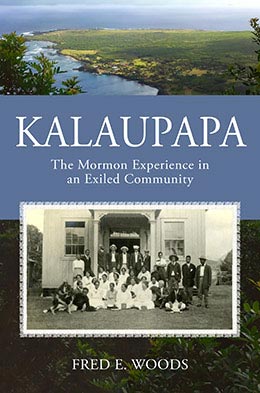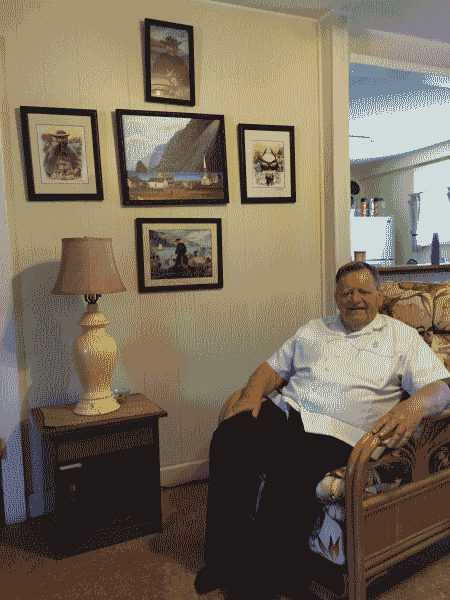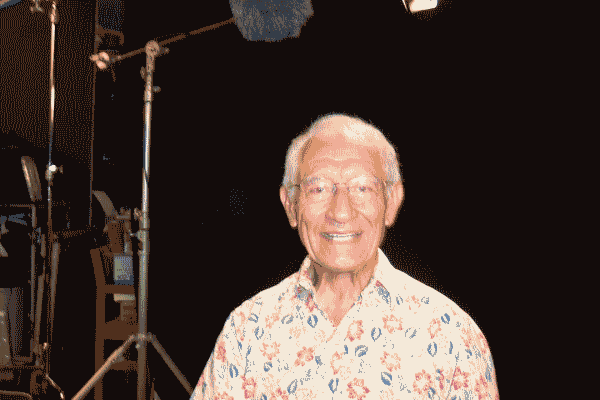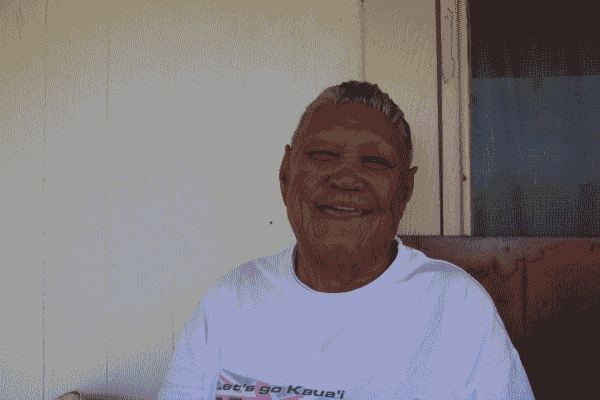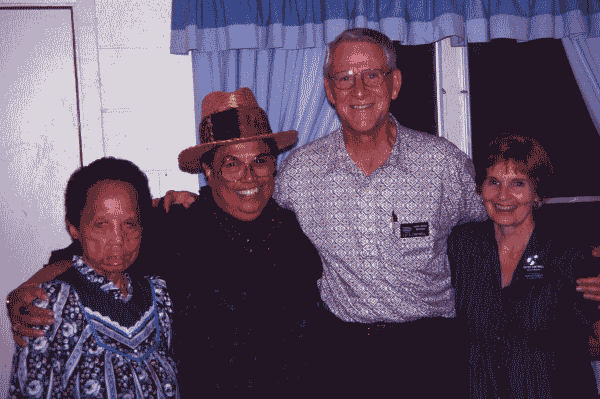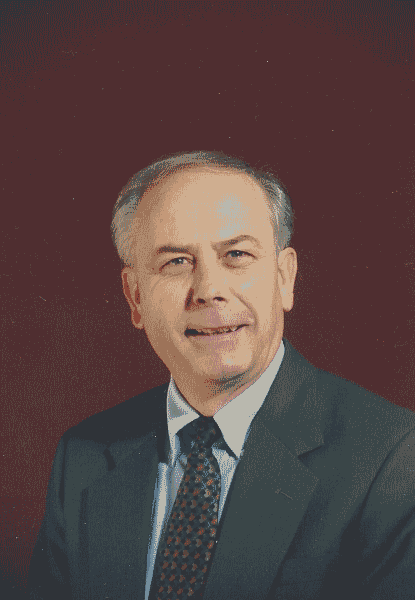Mormons at Kalaupapa in the Mid-Twentieth Century (1945-65)
Fred E. Woods, "Mormons at Kalaupapa in the mid-Twentieth Century (1945-65)," in Kalaupapa: The Mormon Experience in an Exiled Community, Fred E. Woods (Religious Studies Center, Brigham Young University; Salt Lake City: Deseret Book, 2017), 115-214.
More significant to the Kalaupapa residents than even the end of World War II in 1945 was the introduction of sulfone drugs to the settlement the following year. These drugs carried the hope of arresting symptoms of the disfiguring Hansen’s disease. The vast majority—85 percent—of patients volunteered to receive repeated administrations of these drugs, which proved very effective in relieving symptoms and curbing the disease.[1] The impact of the new drugs on the lives of the patients cannot be overstated. Decades later, in 1969, and for the first time in their lives, all patients would have the choice to leave the settlement and assimilate into society. Latter-day Saint patients would finally have the privilege of attending their holy temple, and all residents could be reunited with their families. This new lease on life set the stage for a catalytic figure, Lawrence M. Judd, to usher in a new era of activity, celebration, and emancipation.
Tsunami
A year prior to Judd’s appointment as resident superintendent, an unexpected tsunami ravished the flat peninsula on April 1, 1946. Deep in the Aleutian Island chain, a 7.4 magnitude earthquake spawned a fierce Pacific-wide tidal wave, which hit the western shores of the Hawaiian Islands and caused serious damage.[2] Thankfully, no one was killed on Kalaupapa; however, among other things, “twelve beach homes were washed away and others damaged. Cemeteries along the shore were a shambles, with massive gravestones moved off their foundations, and fences and stone walls destroyed.”[3]
Some of the Kalaupapa community thought warnings were a joke because the tsunami occurred on April Fools’ Day.[4] Henry Nālā‘ielua remembered, “On April Fool’s Day 1946, my roommate Nicky Ramos woke me up at 6:35 a.m. ‘Eh!’ he said, looking out the window. ‘Somet’ing wrong with da water.’ ‘What?’ I jumped out of bed . . . pretty soon a whole beach house floated by. . . . The waves must have been 35 or 40 feet high. Huge!”[5]
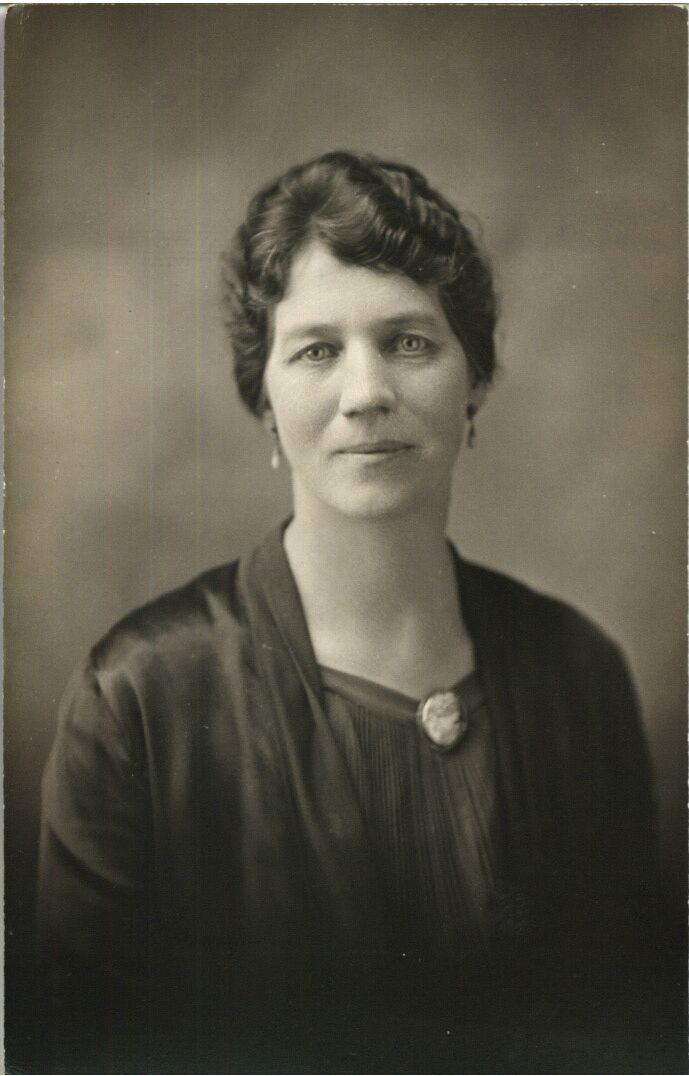 Olivia Sessions Waddoups. (Courtesy of Find a Grave.)
Olivia Sessions Waddoups. (Courtesy of Find a Grave.)
Olivia Sessions Waddoups, wife of Kalaupapa’s superintendent, William, recorded this eventful day when her husband’s life was miraculously spared:
The ocean then was rising and it came up so fast and oh so high and with such force we all ran, but Will who had gone to move his car, thinking the waves would not reach us. But before he could get in the car, the force of the water had banged the door against him, thrown a large truck against his car. How he was extricated out, God knows; he was badly bruised, then washed and hurled with the water about 20 feet—head over heels and striving to save himself hurt as he was, then he saw me floundering in the flood of water against a rock wall. I was hurled from my feet—rolled over several times, and I put my arms around a coconut tree, realizing the back wash would be terrific, I thought to save myself. But was suddenly covered with water and a force that sent me about fifteen feet against the rock wall. One of the men Renaldo saw me and came to help, for fear I would drown, the water receeded some and we got over the rock wall. . . . Will was suffering such pain, we got him home and the Dr. came and examinations and xrays now show there are no broken bones but he is very badly crushed and bruised thru the center of his body. O what a mirical [sic] he was not killed. We are so very thankful for his life.[6]
Olivia also described the destruction that the fierce waves caused to the general landscape of the settlement:
I have no words to explain the havoc and destruction we have here [at] Wills office and the Post Office a large three office building was whirled off its foundation and turned half way around. many beach homes flattened, some washed out to sea, pig-pens & chicken coops, fences and garages washed away. One home a large dwelling was washed out standing up but, soon all we could see was the roof as it floated away in the ocean. Our cemetery was terribly damaged, had stones, slabs of cement, cement pillars of the gateways were scrapped off and floated several hundred feet, fishes left out on the land and our water system about 1500 feet of pipe line near the intake has thrown us into a serious water shortage.[7]
Notwithstanding, Waddoups’s body was eventually restored to full health, buildings were repaired or rebuilt, and normalcy was restored to the community.
Waddoups as Resident Superintendent
Waddoups was no stranger to Hawai‘i or to Kalaupapa. He served a mission in the Hawaii Mission from 1900 to 1904, where he became fluent in Hawaiian and spent his early married years with his wife, Olivia Sessions, living in Iosepa, a gathering place for Hawaiian Latter-day Saints about seventy-five miles southwest of Salt Lake City. William also visited Kalaupapa several times previous to his three-and-a-half-year experience as the Kalaupapa resident superintendent, both as the mission president between 1926 and 1931 and as the temple president between 1919 and 1930. After all this, from 1944 to 1947, he and Olivia lovingly served this vibrant community. In his own personal history, Waddoups explained:
November I was appointed Superintendent of Kalaupapa Leper Settlement, by the Board of Hospital and Settlement. My duties to begin December 1, 1943. Olivia and I arrived on the Island of Molokai November 30th and reached Kalaupapa the same day. Harry A. Kluegel, Superintendent of the Board met us there and introduced us to our new work. We have a comfortable home with servants.[8] Our salary begins at $388.00 and full maintenance with annual increments to $450.00 per month. December or rather Jan. 1, 1944 my salary was increased to $416.00 with $50.00 bonus per month. I resigned as Superintendent of Kalaupapa to take effect as of June 4, 1947.[9]
Having been working at his new assignment for only one month, William wrote in his first journal entry for the year 1944, “Olivia and I are both well and happy at the beginning of a new year. We are beginning to understand some of the duties imposed on us in our new work here in Kalaupapa. We enjoy the work and find a satisfaction in the work we are doing.”[10]
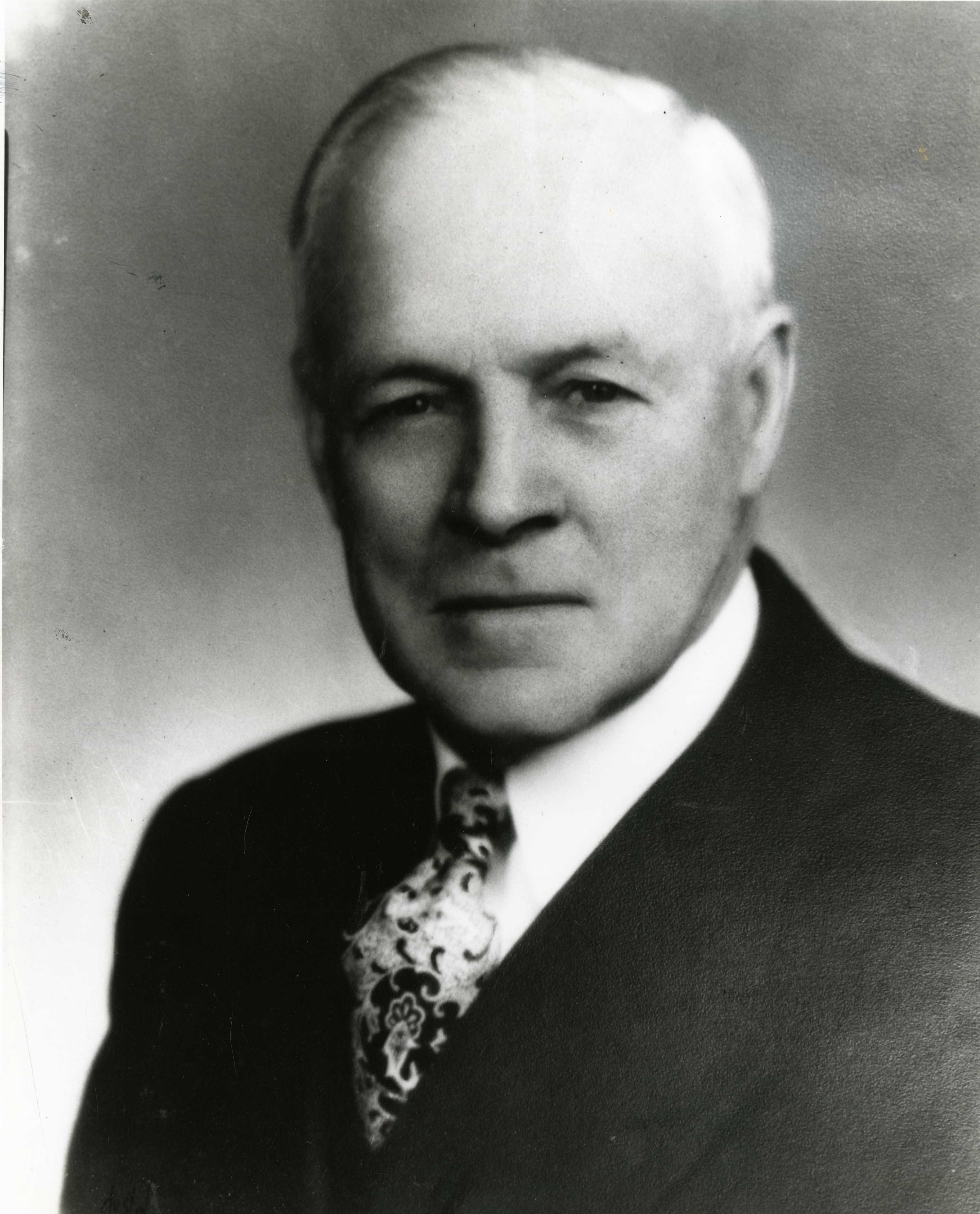 William M. Waddoups. (Courtesy of Joseph F. Smith Library Archives and Special Collections, BYU–Hawaii.)
William M. Waddoups. (Courtesy of Joseph F. Smith Library Archives and Special Collections, BYU–Hawaii.)
During these years of service from 1944 to 1947, Superintendent Waddoups was busy overseeing a variety of tasks. His daily routine and general responsibilities can be captured by this entry: “There is always a certain sameness about my daily programme. There are the same tasks to be performed every day, yet there are enough new jobs to keep the work interesting. Our patients homes must be looked after [and] necessary repairs made. All our mechanical equipment checked and kept in good order. Our water, livestock etc cared for.”[11] About six months later, Waddoups wrote, “Our usual activities are being taken care of each day. I try to keep in close touch with the four unit homes and the hospital, and to know what the needs individually and collectively are. We have our patient workers, our carpenter, plumbing, painting, electrical, laundry and mechanical departments functioning well.”[12]
In addition to overseeing these different areas, William was also involved in the construction of the first airport runway at the settlement during the later period of his tenure.[13] Furthermore, he and Olivia were very active in their LDS faith; Church minutes make clear that they shared their testimonies, gave lectures, and offered prayers in various Church meetings.[14] One Easter, Olivia wrote about how Will “beautifully explained the ‘Resurrection’” during a Sunday School lesson to the Kalaupapa Saints and mentioned her role in passing out eggs to the children.[15] On another occasion she described a short Mother’s Day Church program, which, she noted, “Was a sad one, as none of the Saints can visit their mothers nor send anything out to them.”[16] A series of journal entries during William’s term as resident superintendent demonstrates his steady involvement with the Kalaupapa Saints and visitors who attended LDS Church meetings. William and Olivia’s spiritual depth and positive attitude are evident in their warm relationship with the community:
Sunday, Jan. 2, 1944—Today is our fast Sunday. I gave $2.00 to Mahelona our branch president to help in defraying the expenses of the branch. I attended Priesthood meeting at 8:30. This was followed by Sunday School and then sacrament meeting. The people seem to enjoy having us in their meetings, and we enjoy taking part with them. . . .
Sunday, Jan. 23, 1944—This morning after breakfast, I attended Priesthood meeting in the Kalaupapa chapel. Our attendance is small but our people are sincere. Olivia came down at 9:30 and together we attended Sunday School. We take our own bread and water and partake of the sacrament with the rest of the saints. Our classes in Sunday School are simple and not according to the patern [sic] in larger schools but it is sincere worship Our regular Sabbath service follows Sunday School. Today it was conducted by the branch genealogical officers. Olivia and I were both asked to speak. . . .
Saturday, Feb. 5, 1944—Spent the evening translating Sunday School lessons. . . .
Sunday, Feb. 6, 1944—Today is our fast Sunday accordingly we ate no breakfast. I went to Priesthood at 8:30. Olivia came to the church at 9:30 and together we attended Sunday School and testimony meeting. We again had the blessing of the sacrament. . . . In the afternoon I translated and prepared for printing three lessons for Sunday School classes studying the subject [the] Holy Scriptures. . . .
Tuesday, Feb. 8 1944—Today is my Sixty Sixth birthday. . . . The members of the church here came to the house at noon, stood outside the gate and serenaded us with Hawaiian songs. Jack Sing and wife sent a lovely boquet [sic] of roses and ferns. The Catholic sisters of Bishop Home sent a bunch of orchids and a box of luscious tomatoes. I felt very much honoured by the expressions of good will. . . . Father Peter of the Catholic Church has come to our home and paid his respects. . . .
Tuesday, Feb. 29, 1944—Marie Falaufata Ariola, patient number 3585 died today. She was the only Samoan patient we have here. She was a member of the Mormon church. I was asked to speak at the funeral. . . .[17]
Sunday Dec. 10, 1944—I attended Sunday School at 9 a.m. I met with the English Senior class, we discussed the Priesthood quorum and Welfare organization of the church. Sunday School was followed by a preaching service and then Priesthood meeting was held. Our group is small, but they are sincere Latter-day Saints.[18]
Sunday Jan. 14, 1945—We attended our regular Sunday services today. Sunday School at 9 a.m. Church service at 10 a.m. followed by Priesthood meeting. Olivia and I were asked to report on our trip to Honolulu for the New Year season. . . . Olivia and I attended a meeting of the Boy and Girl Scouts.
Thursday Feb. 8—Today is my 67th birthday. . . . The Catholic Sisters came in and brought me some flowers. Jack Sing brought a lei for my hat. He is our general foreman. . . . I am most thankful that I have reached my 67th year in such good health and circumstances. I indeed have many things to be grateful for. God has been kind to me. . . . I give him praise for all things.
Sunday Feb. 18—Olivia and I are fasting for Clara Horner. I attended Priesthood meeting, Sunday School and general Church services. Many of our people have colds and other ills, so our attendance was small, but we have a good spirit present and I enjoyed the meetings.
Sunday Mar. 11—Olivia and I attended Sunday School and general meeting. Our attendance was small as a good number of our members are unable to attend. I was asked to report my trip to Honolulu. Our people here are always happy to get reports from the outside.
Sunday Mar. 18—I attended Sunday School and general Church meetings. Our attendance was small. We attended a gathering of the Boy Scouts honoring Harold Stein. Our newly organized orchestra made their first appearance. Their playing was creditable. The Girl Scouts sang several numbers.
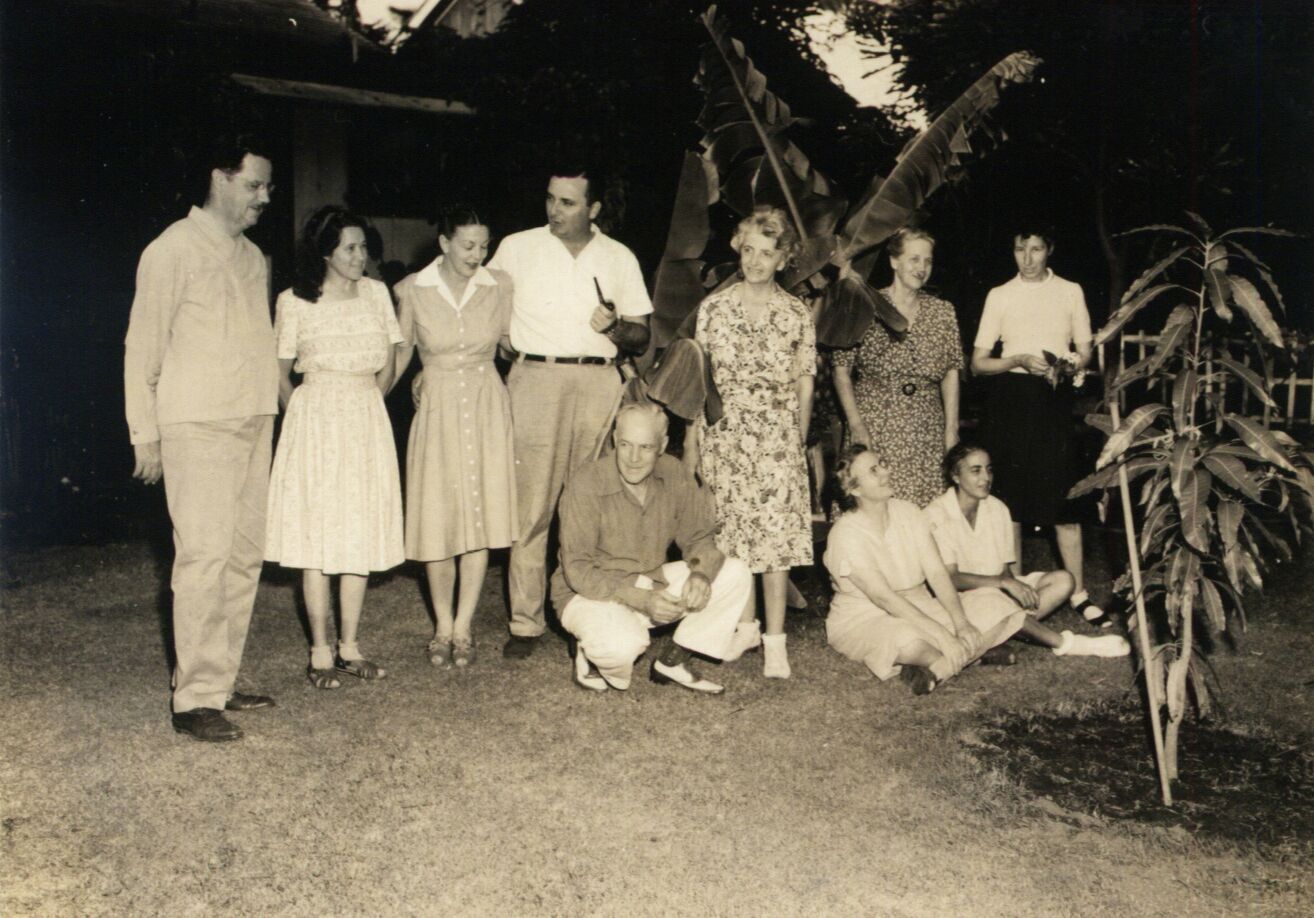
Sunday Apr. 1—Today is Easter Sunday. It is also our regular fast day. . . . After an enjoyable programme the children were dismissed to search for nine dozen eggs hidden in various places on the grounds of the Church. Most, if not all found some eggs.
Sunday Apr. 22—We enjoy meeting with our small group and partaking of the sacrament. Our general meeting after Sunday School is very poorly attended. Most of the members go to the homes where they live for lunch which is served about 11a.m.
Sunday Apr. 29—We went to Sunday School. The sacrament is administered in Sunday School. General meeting follows immediately after Sunday School. Almost all the church members leave after Sunday School to go to their lunch, which is served about 11a.m. Our attendance is small but we have a good spirit present and we have good times together.
Sunday June 24—I attended Sunday School and general meetings. Albert Kahina and Henry Kaahanui from Hoolehua visited us today as missionaries. We enjoyed having them with us. They gave talks encouraging the people.
Sunday July 1—We enjoyed partaking of the sacrament and worshipping with our patient saints. After church we spent the day at home reading. . . . I gave 2oo to Mahelona, president of our branch to help pay branch expenses.
Saturday July 7—Olivia and I attended a camp fire jamboree with the Boy Scouts at Kalawao in the evening.
Sunday July 8—I attended Sunday School and general meeting today at our little chapel. Our attendance is small, usually not more than 25, but we have good times, and discussion in classes, that show a good understanding of the principles of the Gospel.
Tuesday July 17—Olivia and I drove down to Kalawao. . . . I went down to inspect our Boy Scout Camp. The boys keep their camp clean and orderly.
Sunday July 22—I attended Sunday School and assisted in the Senior class in discussing amusements and recreation. In the general meeting I was asked to speak on the meaning of [the] great image which Nebuchadnezzar saw, as recorded in Daniel chapter 2.
Tuesday July 24—Today is the 98th anniversary of the arrival of Brigham Young and his pioneer band in the Great Salt Lake Valley. . . . I wrote letters to Pres George Albert Smith, Joseph Fielding Smith . . . [and] I visited the Boy Scout camp at Kalawao.[19]
Thursday July 26—We received a call from Castle H. Murphy of the mission saying that he and Harold B. Lee were in Hoolehua. He said they desired to come down and meet the people here. We arranged horses for them to come down. . . . In the short notice we could get word to only part of the people. There were about 20 present. He [Harold B. Lee] talked to them and visited a few minutes. . . . He blessed the people and encouraged them. They were delighted to see him.[20]
Sunday July 29—Olivia and I attended Sunday School and church Services. In Sunday School we considered the Church and the future life. There were some interesting comments. . . . I and Olivia were asked to speak briefly on . . . Pioneer Day.[21]
Sunday Sept. 16—I attended priesthood meeting, Sunday School and general Church service. I was asked to report on our trip to Honolulu. . . . They are alway[s] much interested in hearing what is going on in other places.[22]
Sunday Oct. 14—We attended Sunday School and church. We partook of the sacrament and took part in exercises and discussions of the meetings. We held forth in the hall today, as our meeting house is being painted. At 1 P.M. today a series of soft ball games began. I batted out the first ball. I am not in favor of Sunday sports, but it is the desire of the people and has been so conducted for years. I do not feel authorized to change it.
Sunday Nov. 11—Olivia and I attended Sunday School this morning. After class exercises we were asked to report on our trip to Honolulu and the semi-annual conference at Salt Lake City. Our people love to hear news and events from branches, wards, and the church on the outside. They drink up everything about our conferences in Salt Lake City.
Sunday Dec. 9—The missionaries talked in each service and we enjoyed their remarks.[23]
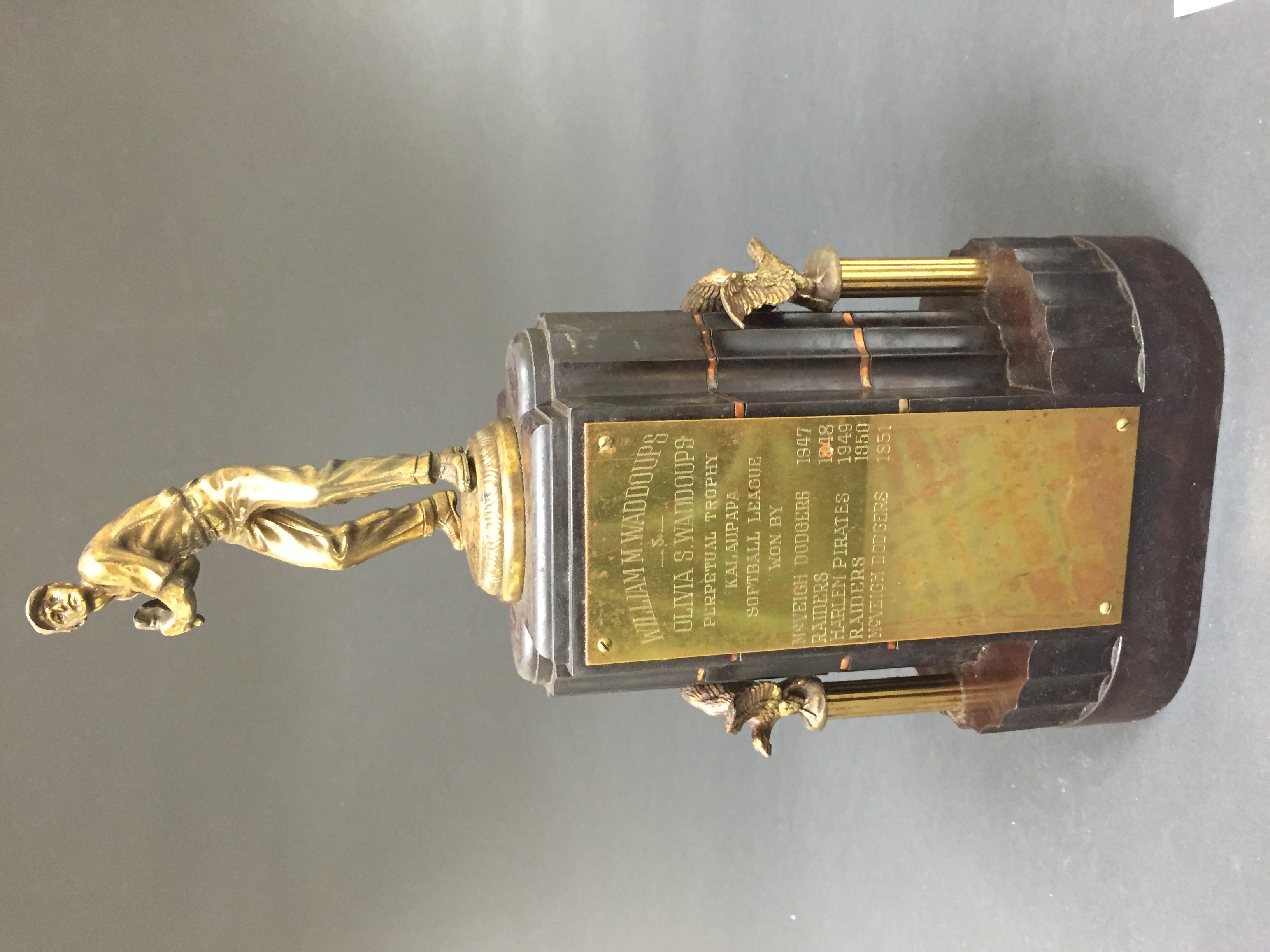
Fifty-two names listed on the LDS Church’s tithing list for 1945 document a clear Mormon presence during the Waddoups era.[24] However, poor health and other challenges seem to have played a role in Church activity; Olivia Waddoups described a much smaller (though grateful) number of Saints gathered for a Sunday Church meeting the following year:
We attended the Services at the Church there were 19 to Sunday School and 9 at meeting, among these 9 was one blind man, two with tubes in their throats, three of them with only one eye, rather a pathetic picture but they expressed only gratitude and thanks for the many blessings they receive.[25]
Although Olivia and William were affiliated with the Latter-day Saints, they also took time to be intimately involved with the larger Kalaupapa community. It appears that Olivia was particularly impressed with the compassionate service given by the patients to others outside the settlement. For example, one noteworthy event was a clothing drive the patients sponsored to aid needy patients at the Culion leprosy settlement in the Philippines. Olivia wrote, “I am awe stricken at the vast collection of very nice clothes, shoes, sneakers, coats, and undies, pajamas and other things that the Patients have brought.”[26]
On Christmas Eve of 1945, William recorded a journal entry which reveals the ecumenical nature of the Kalaupapa community, especially at Christmas time:
Our church people held a Christmas service this evening at 6:30. I was asked to be the speaker. Some members of the congregational church attended our service and sang two songs. We had a good crowd, the church was well decorated, the tree was beautiful. At 11:30p.m. I attended the service at the congregational church. They had a candle lighting service which was beautiful. I was asked to offer the prayer. Dr. Norman Sloan delivered the sermon. The service lasted until about 1 A.M. I attended the Catholic midnight Mass for a short time. All the church buildings and yards were specially lighted with colored lights. Kalaupapa is very colorful for the Christmas season. Few grasp the real meaning of Christ’s birth and mission.[27]
The following year, William again reported the holiday season wherein the community once more held festive events. In these activities, “all the churches observed suitable and impressive services, . . . [and] all the church buildings and yards were artistically decorated and lighted.” On New Year’s Eve, a visiting seven-piece orchestra “furnished very good music for the dance.”[28] In his final year of serving as superintendent, Waddoups was asked to deliver a sermon for the Protestants’ Easter-morning service. One visitor in attendance recalled that it was a “very beautiful sermon” coupled with “beautiful music.” The guest further noted, “Their organist is a patient, hands were stubbs, but he made the organ ring.”[29]
Nancy Talino recalled that during the decade of the 1940s, “There was always music. People were always singing. I think that’s one of the things that kept everybody happy, when you get together and sing together.”[30] The Waddoups supplemented the music they heard at the settlement by listening to the Sunday broadcasts of the Mormon Tabernacle Choir on their home radio.[31]
William and Olivia made time for needed diversion, which usually included taking daily walks on the beach, attending weekly movies, playing Rook, reading with close friends, and enjoying quiet evenings alone in their home.[32] In addition, they prayed and fasted regularly to draw strength for carrying out their demanding duties. For example, this journal entry provides a glimpse into their spiritual depth and need for divine power:
Olivia and I are fasting today. I find much spiritual and physical strength through fasting and prayer. Separated here as we are, from associations with larger branches and church leadership and activities, we need some help and physical strength to carry on our work. We associate every day, and most working hours with people who suffer with this dread disease Leprosy. I feel that we need some source of additional strength to keep us on an even physical, spiritual and mental keel. God has been kind and merciful to me.[33]
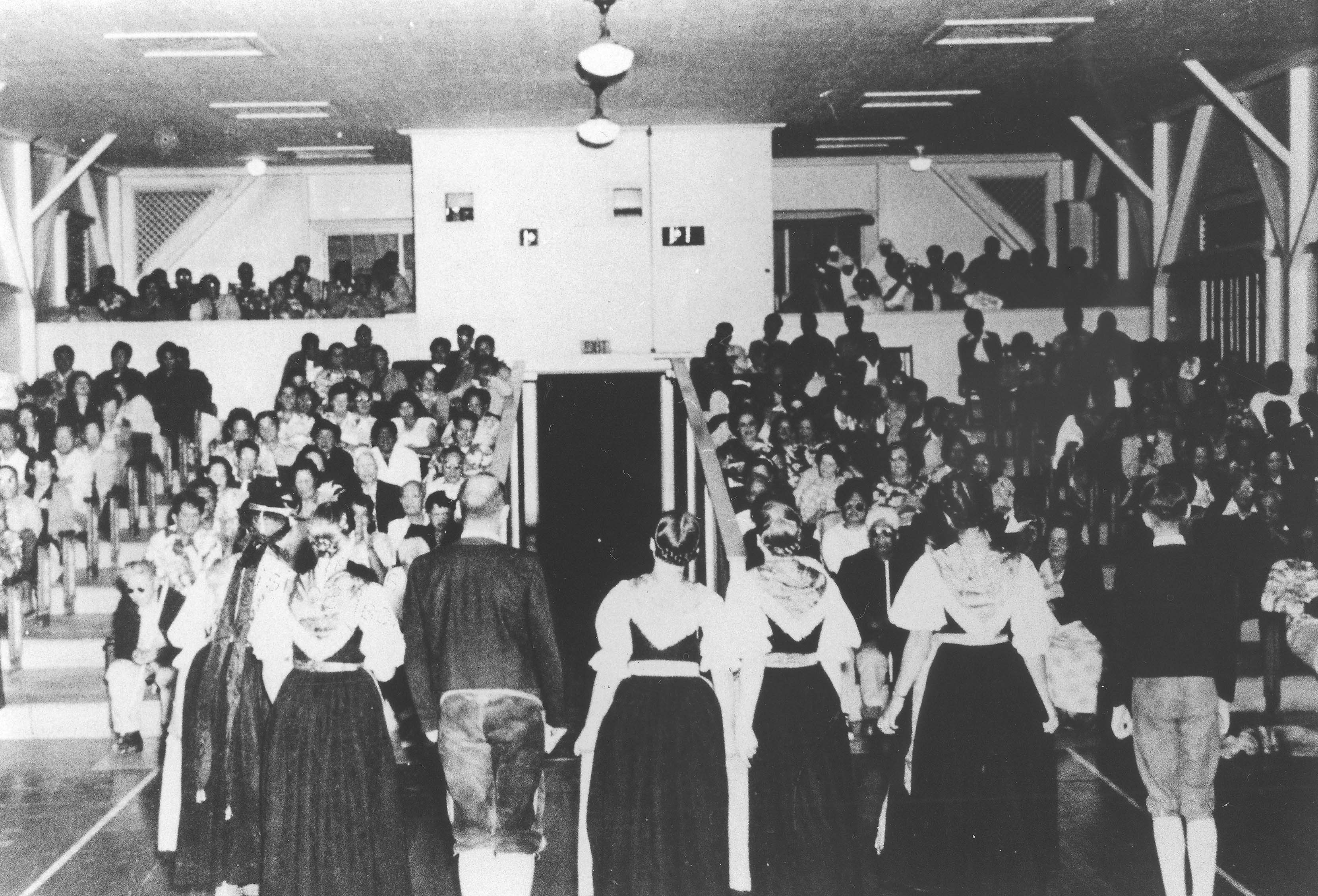 Von Trapp Family at Paschoal Hall, Kalaupapa, 1952. (Courtesy of NPS/
Von Trapp Family at Paschoal Hall, Kalaupapa, 1952. (Courtesy of NPS/
A year after their arrival, William and Olivia attended a movie at Paschoal Hall titled Pack Up Your Troubles. The show triggered an emotional surge of homesickness in the Waddoupses. Will wrote tenderly, “We look forward with longing to the time when we can return to our old home in Utah. Many of us are growing old and I feel that we should have a reunion with our loved ones before too long or some of our members may be taken away before we see them. We are torn by two loves, our children here and our loved ones in the mainland. We cannot be in both places, of course.” He added, “We want to be near a temple always.”[34]
In another entry written seven months later, William noted, “I enjoy the work here. It is not very burdensome. Our home is comfortable, our help is good and well prepared, my salary is by far the greatest I have ever had, and our expense is so little.” He added, “The things we miss is our Church contacts, the thing we have spent our life at, and which is most dear to us. As soon as our finances will permit, we plan to return to Salt Lake City and again take up our church activities.”[35]
The Waddoupses continued their diligent service in the settlement until June 1947, when William reached his seventieth year. At this time he retired, and the couple returned to Utah.[36] In a final monthly report as superintendent, he noted, “All the medical Staff have been very cooperative, and our association has been most pleasant. . . . I commend all the patients for their patience with me and for their good will and cooperation. . . . My work has been a pleasure and a fine experience.”[37] A fine gesture of good will was manifest by the patients to the Waddoups, where they presented them with a beautiful set of sterling silverware which they had collected to show their love for William and Olivia.[38]
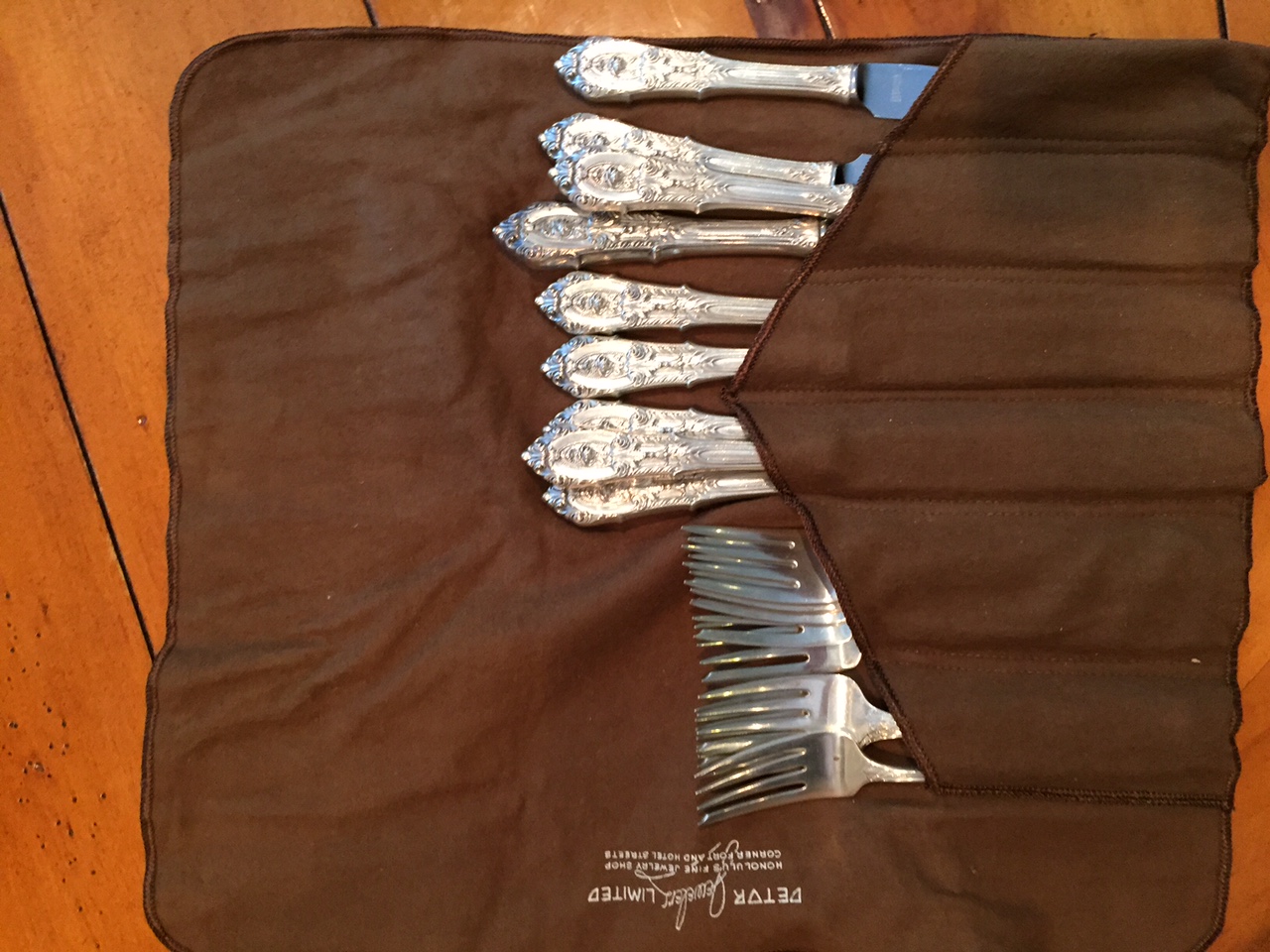 silverware set given by the patients to the Waddoups. Courtesy of Bill and Mary Lou Bingham. Mary Lou is a grand-daugther of William and Olivia, and the Binghams have this sterling silverware set in their possession.
silverware set given by the patients to the Waddoups. Courtesy of Bill and Mary Lou Bingham. Mary Lou is a grand-daugther of William and Olivia, and the Binghams have this sterling silverware set in their possession.
An LDS Apostle Visits Kalaupapa
Shortly before their assignment came to an end, William and Olivia enjoyed the great privilege of hosting an LDS dignitary. Matthew Cowley, an Apostle of the LDS Church, carried the tremendous responsibility of overseeing tens of thousands of Church members across the Pacific. Elder Cowley, greatly loved by the island people, was affectionately known as the “Polynesian Apostle.” Kalaupapa was part of his stewardship in the Pacific region, and he took the time to visit the Latter-day Saints in their secluded settlement. One of the LDS patients, Jack Sing, remembering Cowley’s visit, remarked that he was “a very jolly man. . . . He talk, lot of fun and saluting us and all that. Now he’s a fine fellow.”[39]
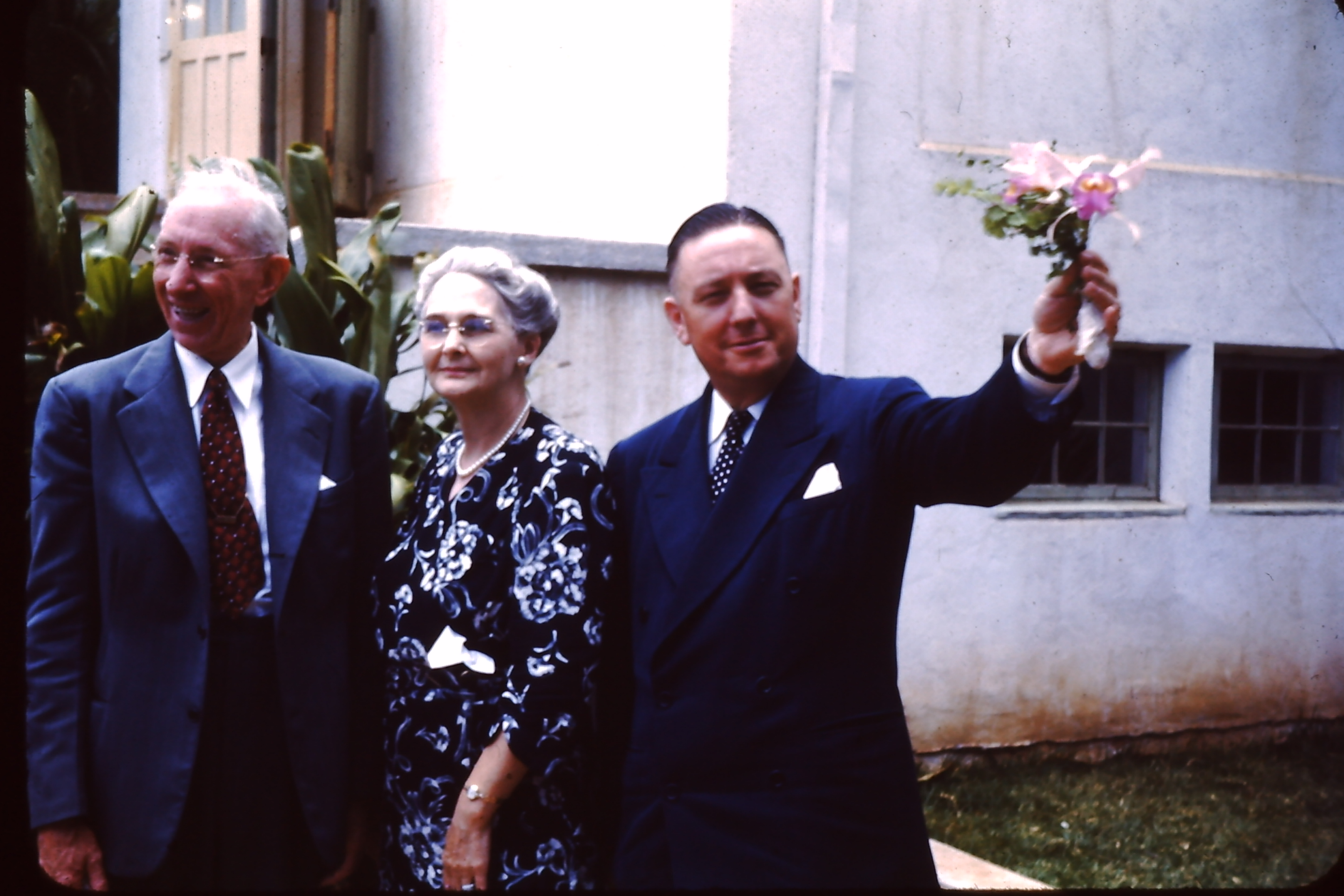 E. Wesley Smith, Sister Smith, and Matthew Cowley, 1947, Moloka‘i. (Courtesy of Jack L. Halvorsen.)
E. Wesley Smith, Sister Smith, and Matthew Cowley, 1947, Moloka‘i. (Courtesy of Jack L. Halvorsen.)
Olivia also recorded in her journal the experience of Elder Cowley’s visit on March 27, 1947: “Bro. Cowley, Jenkins & Clissold came. . . . We then all went to meeting where the Brethren gave some splendid advice. . . . Bro. Cowley pleased me then with his Maori language and Charts and then a very spiritual talk. . . . We feel very honored and humble in this great privilege. We feel we have had a very special day.”[40]
Elder Cowley was likewise humbled and touched by this Kalaupapa encounter, which he later recalled when speaking at an LDS Tongan Mission conference held not long thereafter:
When I was listening to two of the hymns we sang here this morning, “We Thank Thee O God for a Prophet” and “Come, Come, Ye Saints” my mind went back to the Hawaiian Islands. When I was there in the month of May [March] three of my friends and I got in a little airplane—just a small one that would only hold four people and flew from Honolulu to another island and landed at Kalaupapa—a beautiful little village—beautiful flowers, beautiful grass, beautiful cottages all freshly painted. The man that met us at the airport took us in his car, and on the front of the church it said “Church of Jesus Christ of Latter-day Saints.” We went in and there were a lot of people sitting down on the seats waiting for us. My friends and I sat on one side of a railing and the Presidency of the Branch sat on the other side; we never even shook hands with one another. They sang the first song and had a prayer, then the Branch President asked the choir to sing a second song which was ‘We Thank Thee O God for a Prophet.’
I’ve heard our great choir in the Salt Lake Tabernacle in Salt Lake City sing that song; I’ve heard the people in the Hawaiian Islands sing it; I’ve heard them sing it all over Australia and I’ve heard them all over New Zealand, and I’ve heard you sing it here this morning, but I’ve never heard it sung as beautifully as it was by that little choir, and all the people in that choir were lepers—some of them with their ears gone, some of them with part of their faces gone, some of them with their hands gone and their feet just rotting away—and yet in all that sickness they sang ‘We Thank Thee O God for a Prophet.’ I thought when I looked at those people I would feel very sad, but when I looked my soul was lifted up and they all looked like holy people to me. Another song they sang was ‘Count Your Many Blessings’ and there those people are to stay the rest of their lives and will never go home—and yet they can sing these songs with joy and happiness in their hearts. They have love in their hearts for the Church and for the Gospel.”[41]
Although in the settlement for only a few hours, Elder Cowley profoundly impressed by the community of Kalaupapa, as evidenced in a letter of gratitude he sent to the Waddoups. Because of its rich content, the bulk of the letter has been included:
To you and Sister Waddoups I hasten to send my aloha and mahalo nui for a few hours of genuine inspiration spent at Kalaupapa, and for the kind hospitality of your lovely home. The visit was all too short, yet it will be vivid upon my memory forever. I went there apprehending that I would be depressed. I left knowing that I had been exalted. I had expected that my heart, which is not too strong, would be torn with sympathy, but I went away feeling that it had been healed. Never had I dreamed that I would hear lepers lift their voices in song. The experience lifted my soul. Beautiful harmony from a chorus . . . directed by one blinded by the dread disease was indeed more than I had expected. That was a memorable hour of worship. The inspiration of the service came from the congregation—not from the pulpit. In appreciation for that inspiration, I prayed hard that I might make, with words from a limited and inadequate vocabulary “leis” of spiritual flowers to place about their necks. How miserably I failed! When I arose to the impossible task I had already discovered that each of them was so adorned with spiritual “leis” made from the floral garden of his and her own soul, that any creation of mine would have spoiled the picture. Had I thought they would understand I would have just said “Thank you from the bottom of my heart” and sat down. I only said more because they expected it.
I went from the meeting appreciating my friends, loving my enemies, worshiping God, and with a heart purged of all pettiness. This is a transformation for me and for it, I am indebted to the leper Saints of Kalaupapa. As we took off into the air enroute back to Honolulu I looked down from the settlement with its beautiful trees, lawns and shrubs, with a shore line washed by the azure waters of the Pacific and a precipitous back curtain of lush foliage and I said to myself, “What an appropriate setting for the jewels that have been placed there. God grant that when aches and pains attack my body, and worries beset my mind, I can sing with the lepers of Kalaupapa.”[42]
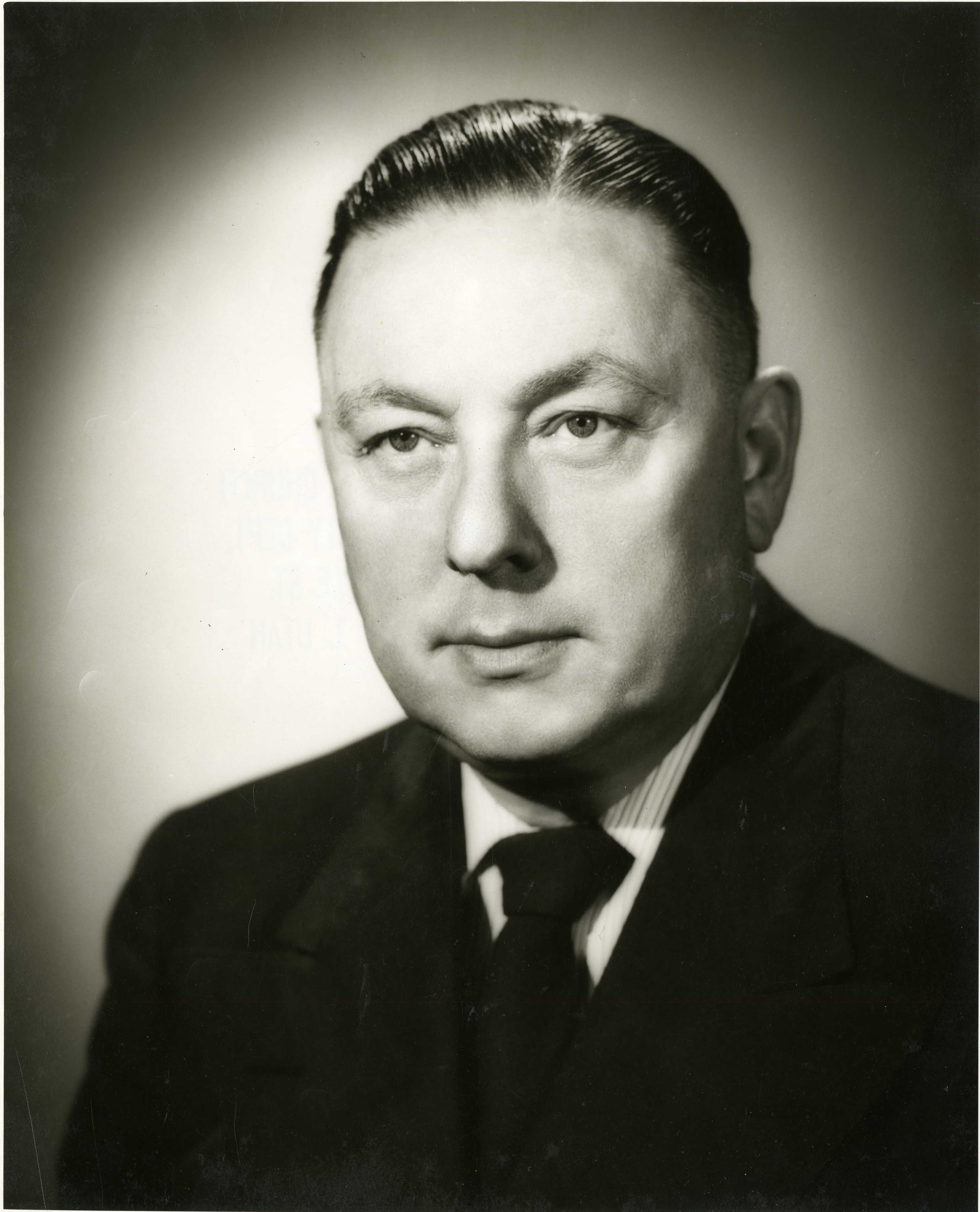 Matthew Cowley. (Courtesy of Joseph F. Smith Library Archives and Special Collections, BYU–Hawaii.)
Matthew Cowley. (Courtesy of Joseph F. Smith Library Archives and Special Collections, BYU–Hawaii.)
At last, the rippling effects of service flowing from Napela, Damien, the Sacred Heart brothers, Franciscan sisters, Protestant leaders, kōkua, and the Christian community as a whole had transformed a tormented terrain into sacred space. From the hopelessness of its early beginnings, the Kalaupapa community finally offered visitors inspiration and betterment. Over time, the extreme pressure exerted from exile, privation, and suffering had forged a community of equality, charity, and cooperation.
The Lawrence Judd Years
Lawrence Judd’s service at Kalaupapa was far more than a job to him. It was a fulfillment of his childhood vow to help victims of leprosy. One day, while growing up in Honolulu, Lawrence raced down Nuuanu Avenue on his bike, eager to gawk at the newly arrived US Navy transport ships at the Honolulu harbor. Other activities involving celebrations, parades, or royal visits had reached this waterfront in times past, but this was a different scene. As he slowly coasted closer to the pier, he saw a crowd of Hawaiians of varying ages, mostly barefooted, was huddled behind an odd white picket fence awkwardly erected on the platform above the gangplank, intended to keep a separation between loved ones. Some of the people clung to the fence as they wept and howled. A young girl, cheeks glistening from tears, looked up and met the eyes of Lawrence. He felt her pain and searched for an explanation.
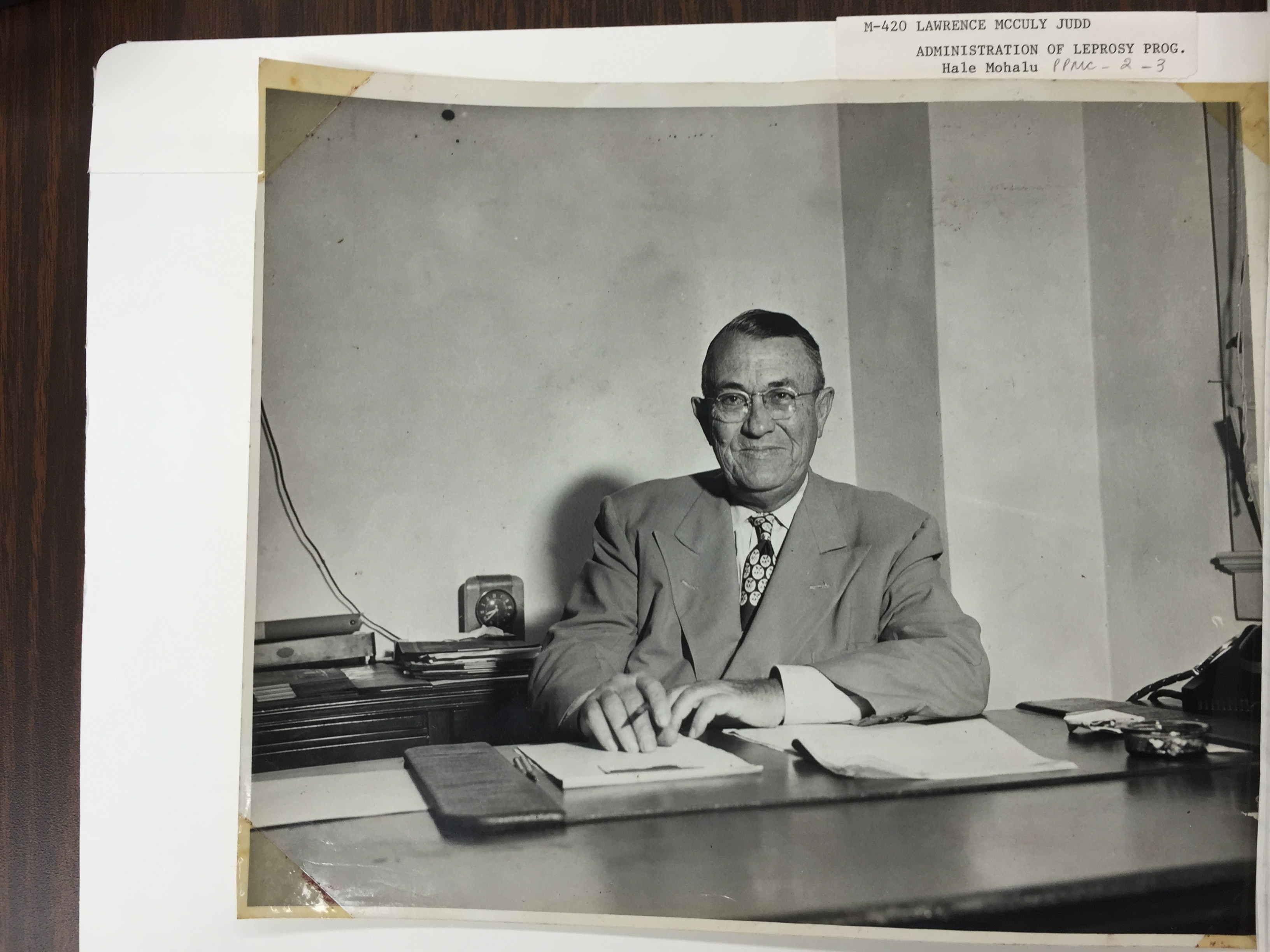 Lawrence M. Judd. (Courtesy of Hawai‘i State Archives.)
Lawrence M. Judd. (Courtesy of Hawai‘i State Archives.)
Lawrence rode to a uniformed man to ask what was happening and who these unfortunate people were. The man explained that the bereaved souls were family and loved ones of victims of leprosy who were being transported now to the Kalaupapa settlement. A large carriage van arrived, and a health department officer led the patients out and onto the platform to say their last goodbyes to their families, who stood on the other side of the whitewashed fence. The wails and cries accelerated. All were careful not to draw near each other or touch. Brief tearful exchanges were made while health officials unloaded the patients’ meager belongings from the van and placed them onto the cattle boat. Lawrence watched intently as the sorrowful procession of passengers walked slowly down the gangplank and found a place on the unpretentious, dirty inter-island cattle boat. Young and old waved their last farewells as they sailed toward their new lives of uncertainty and loneliness.
It was, at once, an unforgettable moment frozen in time, burned into the psyche of an impressionable young man. The scene of misfortune and heartache witnessed that day fashioned a rudder by which Lawrence would steer the rest of his life. Imaginations of becoming a celebrated naval captain dissolved, and a new vow took root in his heart. Somehow, some time, he would help these people of Kalaupapa.[43]
The desperate scene never left him. Between 1929 and 1934, his years of legislative work in the territorial senate, Judd had visited Kalaupapa several times. Also, while he was in office as governor, he formed a committee to improve settlement conditions.[44] Thus, with his years of experience and his tenacious desire to relieve suffering patients, Judd was the obvious fit to replace Waddoups in June of 1947.
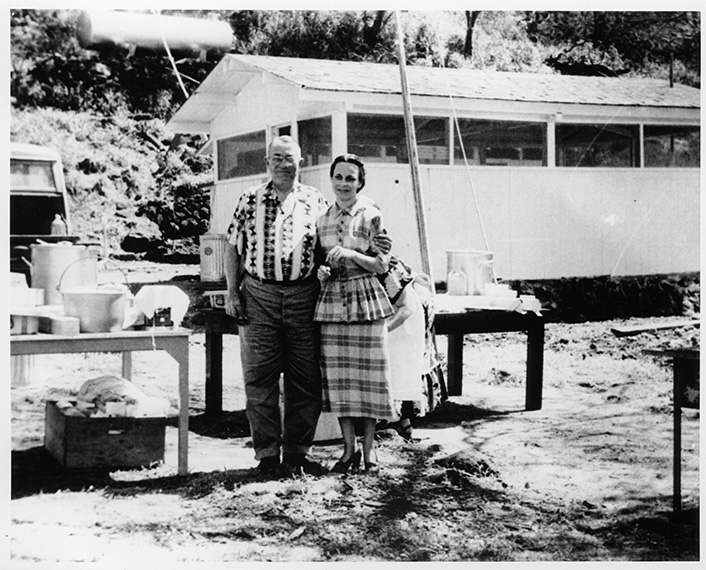 Lawrence M. Judd and Eva Judd. (Courtesy of NPS/
Lawrence M. Judd and Eva Judd. (Courtesy of NPS/
The full-time job offer came by way of a letter from H. A. Kluegel, superintendent of hospitals and the Kalaupapa settlement, to Harold W. Ross, who oversaw hiring for the board of health. Kluegel explained, “At Kalaupapa today there is need for the expansion of the scope of directed activities having to do with the welfare and well-being of the social aspect of the patients. The Board feels that Mr. Judd may well carry out this program in addition to the usual administrative duties of the position.”[45]
After accepting the appointment as superintendent, Judd delivered this solemn speech to the assembled patients:
It is with a deep feeling of responsibility and Aloha for you that I have assumed the duties of Resident Superintendent. My interest in your welfare began about fifty years ago. . . . I have visited here many times, as a Senator and Member of the Senate Health Committee, as President of the Senate, as Governor of the Territory, and as a private citizen. . . . Little did I think, fifty years ago, that I should ever come to live with you, that I should thus have the opportunity of helping you with your every-day problems and of dealing directly with the welfare and happiness of you men, women and youth, who are not only my fellow citizens and friends, but are now my neighbors.
In dedicating myself to the difficult tasks that lie ahead of me, I fully appreciate the grave responsibilities of the position I now hold. In the administration of my office I need your thorough cooperation and steadfast help. It shall be my objective to keep high the moral and social standards of the community, and to add constructively to your welfare. I shall at all times do my utmost to devote my energy, with my natural limitations, to the promotion of human principles and to give your problems the dignified consideration they merit.[46]
First Order of Business
Judd surmised that the first order of business should be a major cleanup of the physical grounds, believing that greater self-respect and pride among the patients would result. His robust plan included discarding abandoned cars, “mattresses, iron scraps, crates, packing material, bedsprings, rusty piles, defunct plumbing fixtures, oil stoves, termite-eaten lumber, and other junk that symbolized years of living in a state of hopelessness.” He managed to get everyone on board, and when the dust settled, the community had hauled away six hundred truckloads of rubbish without the aid of a city sanitation crew.[47]
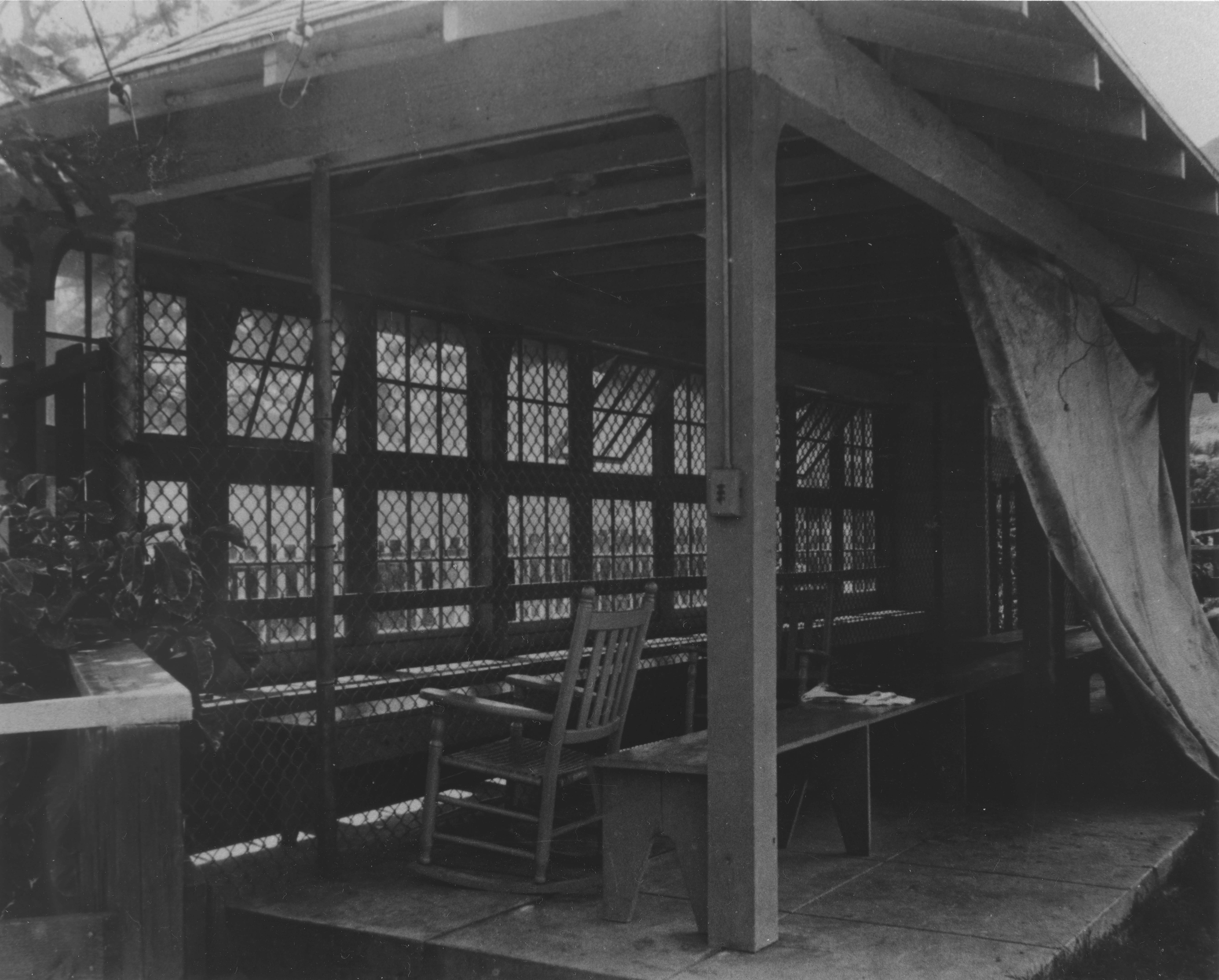 Barrier between patients and visitors, ca. 1940s. (Courtesy of NPS/
Barrier between patients and visitors, ca. 1940s. (Courtesy of NPS/
The cruelty of that white picket fence from his childhood memory motivated Judd to eradicate most of the old barriers sprinkled throughout the buildings at the settlement: “We took down some of the barriers that separated the patients from well people in the colony. . . . A craft shop was opened, education was emphasized, and a choral society organized.”[48]
The Lions Club
The next significant step in revitalizing the community was Judd’s procurement of a Lions Club charter.[49] Judd delivered a passionate inaugural address on the day of the club’s chartering, declaring, “This day will be recorded in the history of the settlement as a memorable one.” Among other things, he thanked his fellow Lions and friends who were visiting the settlement from the islands of O‘ahu, Lāna’i, Maui, and topside Moloka‘i. Judd took occasion to educate those in attendance, many of whom were visiting for the first time. He succinctly reviewed the history of the leprous disease at large and particularly at Kalaupapa, inspiring hope that 90 percent of the “active” (infectious) patients had voluntarily chosen to have sulfone drugs administered, which had been of “substantial benefit.” At the same time, he urged, “We must not rest content with the progress of the past but must do our utmost to provide for our people the most advanced and humane procedure known to modern science.” He also emphasized the value of service and hinted at the hope he held that the Lions Club would bring much service to Kalaupapa:
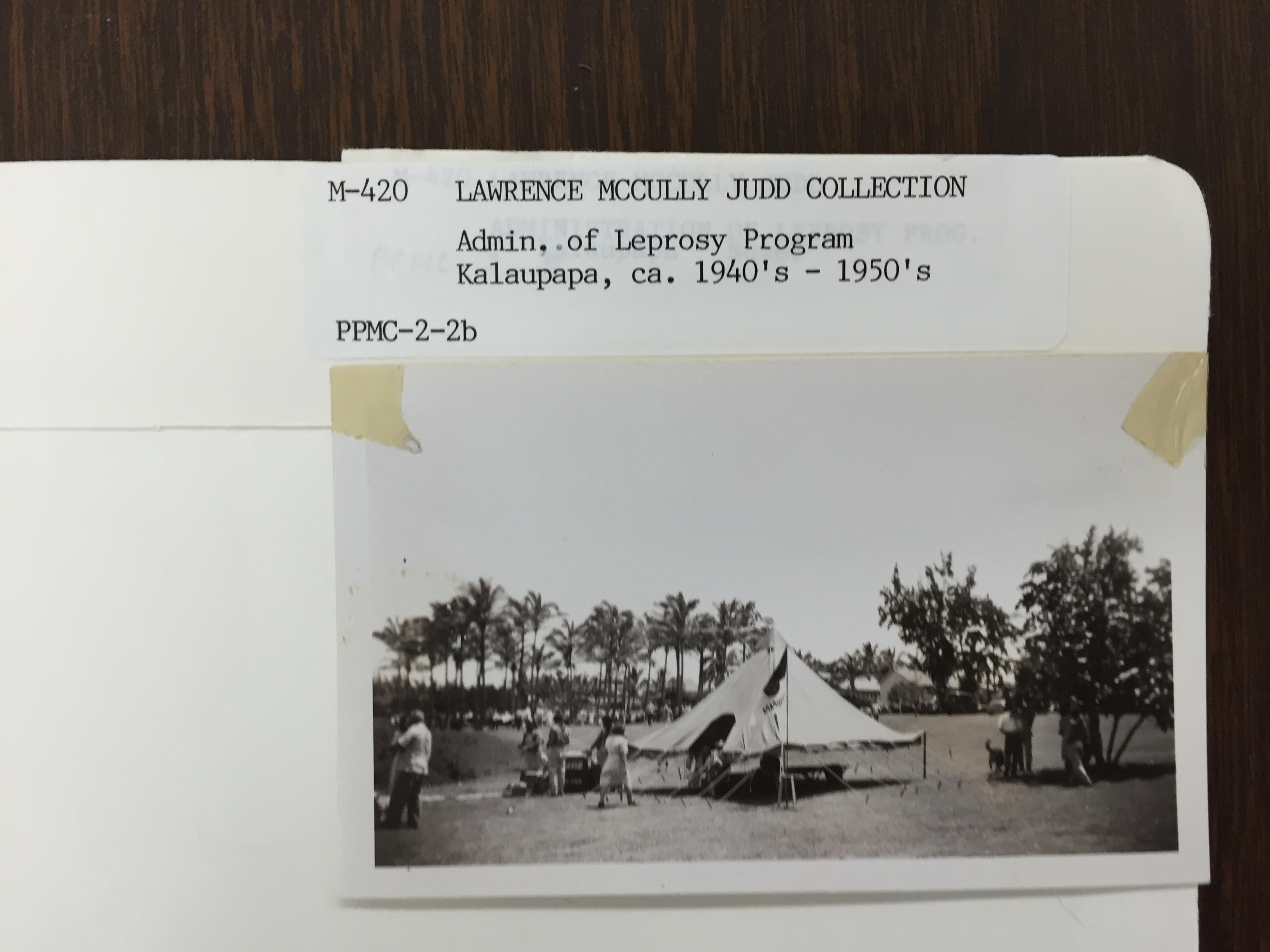 Kalaupapa Lions Club Charter Day, 1948. (Courtesy of Hawai‘i State Archives.)
Kalaupapa Lions Club Charter Day, 1948. (Courtesy of Hawai‘i State Archives.)
I think that in the usual walks of life we are apt to forget some of the fundamental principles of a joyous life and forget the great personal satisfaction attained by service to others. Yes, we are even inclined to forget the need for the application of the Golden Rule. Therefore, as the representative of the Board of Hospitals and Settlement president in the settlement I most sincerely welcome the establishment of a Lions Club in Kalaupapa for I can visualize the opportunities for service which exist here and I do not know of any community more worthy of service.[50]
Bill Malo, a Latter-day Saint, became an active member of the Kalaupapa Lions Club and later commented on Judd’s tremendous influence and the club’s impact on the settlement:
In my opinion, the social interaction all came about because of this man. The biggest thing Mr. Judd did was to convince his brother to introduce the Lion’s Club International to the settlement. Every year the Lions Club had a charter celebration, and people from the outside world would come to Kalaupapa to visit. . . . You were able to interact with other people socially, and it was here that we made contacts with the outside world. I made friends with people from all over who came to Kalaupapa with the Lions Club. . . . Developing these friendships helped me to shed some of the feelings of fear I had concerning whether or not I would be accepted.[51]
The entire community seemed enthusiastic over the energy and positive direction Judd provided. Under Judd’s direction, Reverend Alice L. Kahokuoluna contributed to the literacy of the entire community while serving as the librarian for the settlement. In a 1948 report she sent to Judd, Alice listed 2,462 books in the library and divided them into categories: 1,521 books for adults, 739 books for children, 60 poems and plays, 52 religious books, and 90 reference works. The report contained the names of individual donors and organizations which were contributing magazines and newspapers to the library.[52]
The Judds placed great emphasis on recreational activities for the community, believing that with the patients’ improved health it was time to increase their activities. Soon after the Judds arrived at the settlement, they held a field day on the Fourth of July. Among other festivities, the field day included the following events: standing broad jump, fifty- and seventy-five-yard dash, four-man relay, bag race, shotput, softball throwing and batting, potato race, and even a “fat man race.” Winners received various prizes, which included pocket watches, a duck, a cigarette lighter, ashtrays, a coffee maker, and vases.[53]
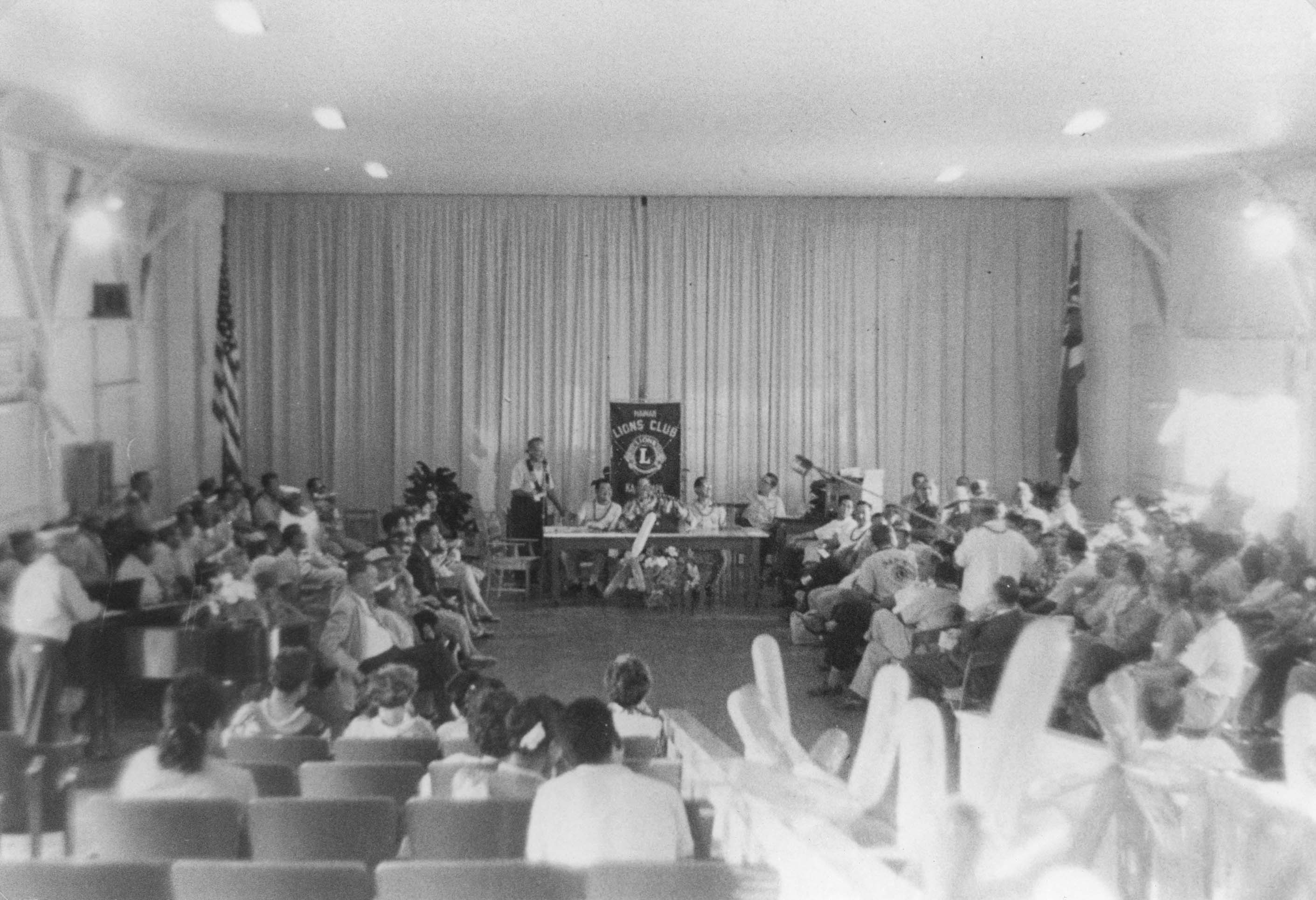 Kalaupapa Lions Club meeting at Paschaol Hall, Kalaupapa, ca. 1950s. (Courtesy of NPS/
Kalaupapa Lions Club meeting at Paschaol Hall, Kalaupapa, ca. 1950s. (Courtesy of NPS/
Youth Activities
Lawrence soon launched more sports programs and activities for the youth with his wife, Eva, laboring faithfully at his side. One of the young boys summarized the Judds’ impact on the community when he said to Mrs. Eva Judd, “Before you and Mr. Judd came all we did was eat, sleep, fish and ride bicycles. Now there is something to do every moment, band, Boy Scouts, soft ball, movies, block printing, amateur plays.”[54]
Young men became more involved in the Boy Scouts program, which had already been established, but they also created new youth clubs. Just three months into Judd’s assignment, these programs were up and running, improving the lives of the young people.
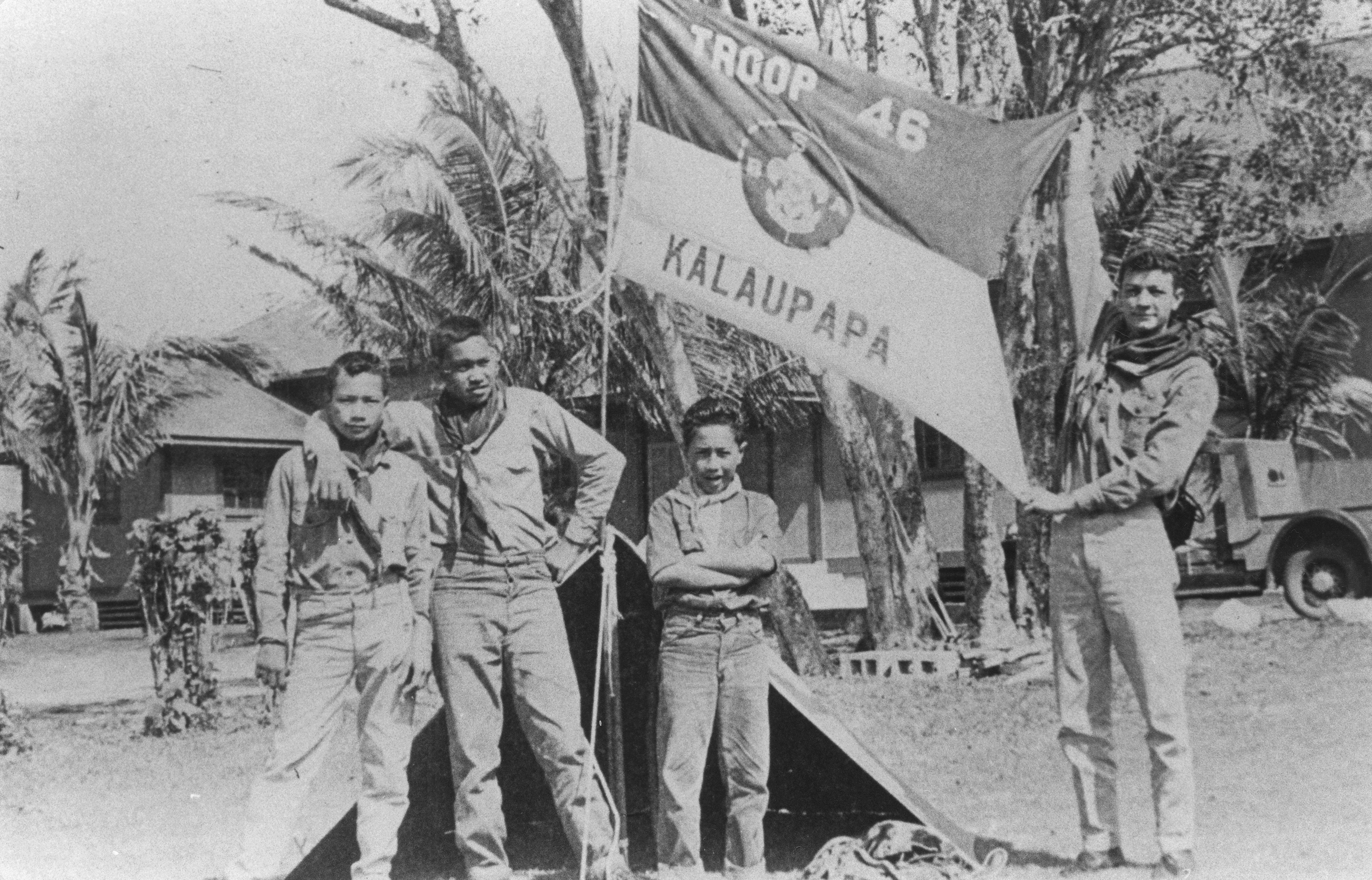 Kalaupapa Scout Troop 46 (L to R: Robert Leong, Elroy “Makia” Malo, Henry Leong, and Eddie Marks at Boy Scout “Makahike,” festival, Kalaupapa. (Courtesy of NPS/
Kalaupapa Scout Troop 46 (L to R: Robert Leong, Elroy “Makia” Malo, Henry Leong, and Eddie Marks at Boy Scout “Makahike,” festival, Kalaupapa. (Courtesy of NPS/
When the boys met to shape their organization, it was proposed that the name of the club be Young Men’s Social & Educational Club. The purpose of the club and the constitution were specified: “The object of the club shall be promoting of Recreation, Loyalty, and other clean activity, among the young people of Kalaupapa. The club shall be composed of boys, residents of Kalaupapa. . . . A majority of the members shall constitute a quorum.” Bylaws were established to provide order and to encourage the young men “to behave in a gentlemanly manner.” To enforce this bylaw, a tax of ten cents was levied against anyone who used profanity.[55]
That same day, a Girls Social Club was formed and a memo recorded the names of elected officers.[56] Minutes of their meeting prescribed the established and readily agreed-upon rules. These included “no swearing,” and “all girls must not refuse to dance with the boys, if addressed politely.”[57]
In addition to clubs specific to the boys or girls, a combined Young People’s Social and Educational Club was formed, inviting both males and females to join. To their credit, the members agreed that each incoming member should pay a one-dollar fee and that a social be held each month on the third Saturday.[58] The minutes for that first meeting were recorded on September 2, 1947, by a bright teenager named Edward Marks, who signed the document as “Secretary”:
The meeting was opened by Mr. Judd to organize a club for the young people of Kalaupapa. After . . . advice, he stressed his full cooperation in organizing our club due to his interest in the younger sect. He also gave us the assurance that comm. [Commissioner] Utterback of the American Legion is very willing to extend his full cooperation with his power to contribute to the success of our club. Mr. Judd also commented on some of the American Legions contributions such as trophies, cups, and athletic equipment. . . . Mr. Judd then commenced in our election of officers.[59]
These deliberately designed youth organizations, under the wise and experienced tutelage of Superintendent Judd, helped develop responsibility and leadership skills in the settlement.
Band for the Youth
Having learned the violin as a child,[60] Judd believed that learning an instrument and performing in a band would boost the young people’s morale and confidence. He arranged for the purchase of new instruments, and a band soon formed. Elroy “Makia” Malo, an active Mormon in his youth who went on to become a well-known Hawaiian storyteller, recalled his first public Kalaupapa performance on the alto horn. Feeling very inadequate with his new instrument, Makia stood miming his part while the song played, not daring to put lips to horn. Judd, sensing the hesitance, whispered in Malo’s ear, “Blow, boy, blow!” Makia recalled, “It came out pretty loud but it sounded almost like a fart, and people started to laugh. That was my debut.”[61]
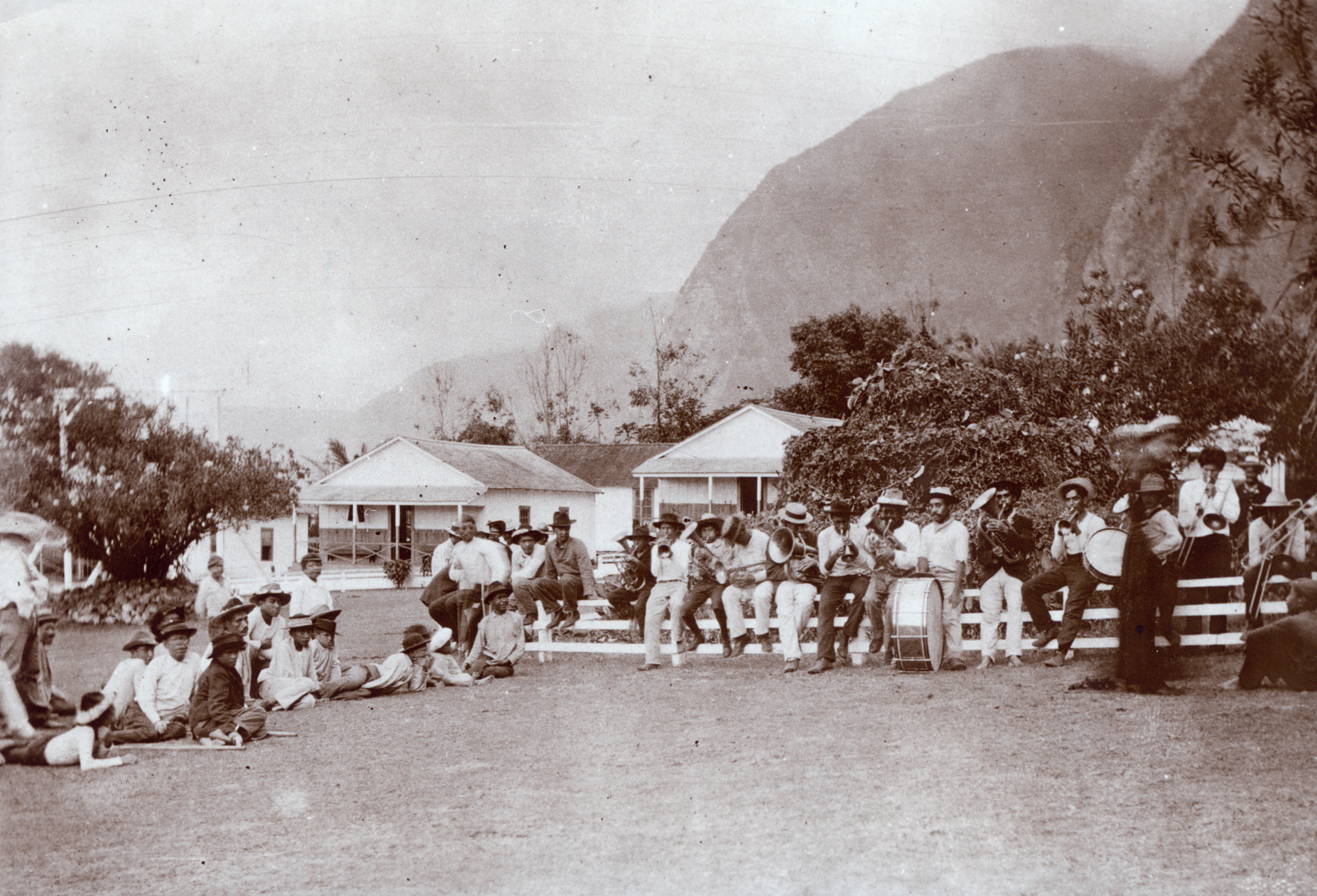 Kalaupapa Band, ca. late 1940s. (Courtesy of Hawai‘i State Archives.)
Kalaupapa Band, ca. late 1940s. (Courtesy of Hawai‘i State Archives.)
Adult Activities
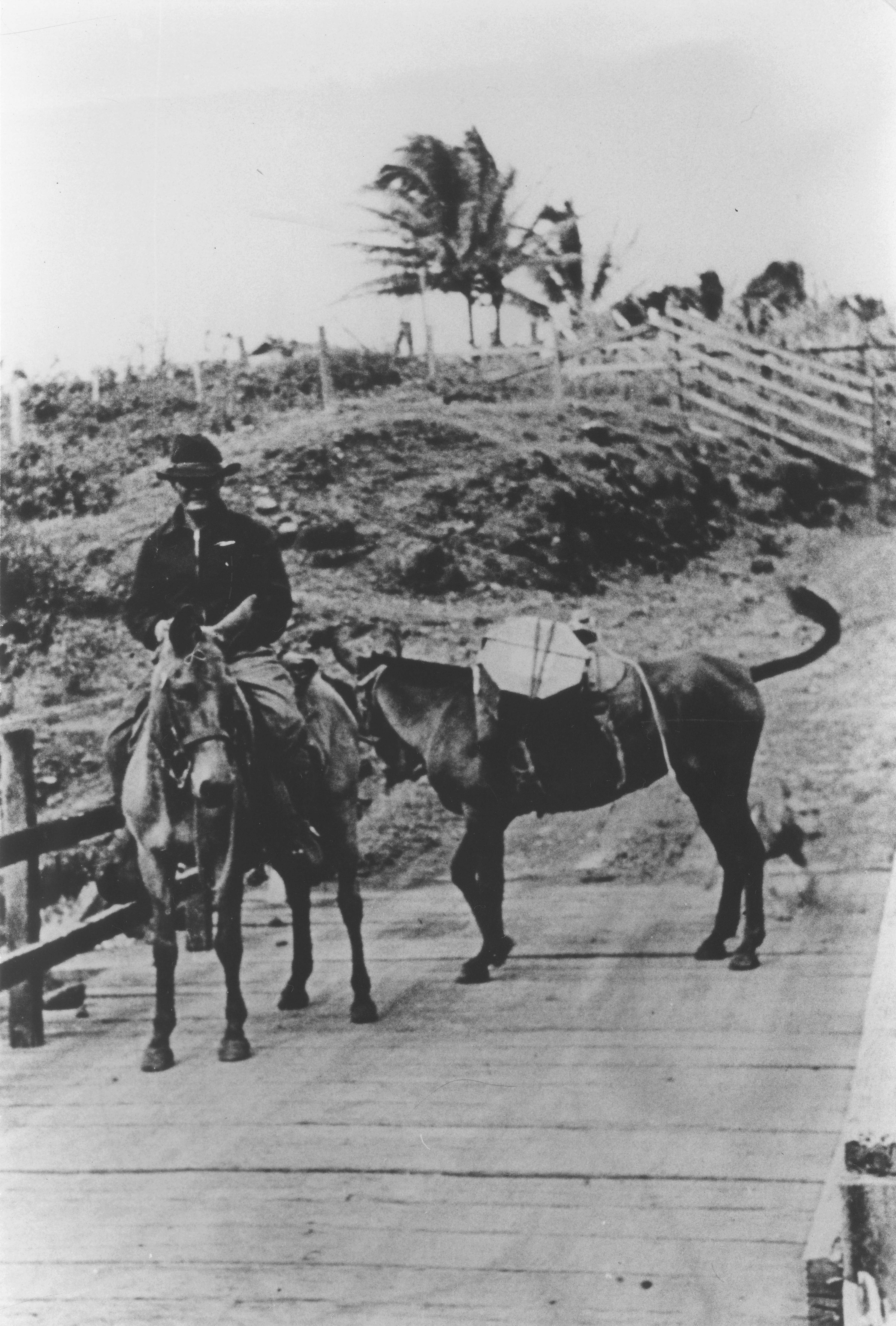 David Kupele bringing a movie from the trail. (Courtesy of NPS/
David Kupele bringing a movie from the trail. (Courtesy of NPS/
Movies formed a big part of the adult social activity. One visitor who watched a film at the settlement remarked, “The attendants sit in the balcony and patients on the lower floor of the theater.”[62] Movies were shown several times a week at the Kalaupapa social center, known as Paschoal Hall. A sample of the films shown during the Judd era of the late 1940s appeared in the “Kalaupapa Picture Schedule” for the month of December:
Friday December 3—Night Song
Monday December 6—High Wall
Friday December 10—If Winter Comes
Monday December 13—Intrigue
Friday December 17—Summer Holiday
Monday December 20—Man in the Iron Mask
Saturday December 25—Secret Life of Walter Mitty
Monday December 27—Tobacco Road
Thursday December 30—Three Daring Daughters[63]
For evaluation purposes, Judd formally summarized what he had accomplished in just two years from the time of his appointment in 1947:
Substantial progress has been made in improving the welfare of the patients of the settlement. The general appearance and cleanliness of the settlement have been improved. Vocational, educational, and occupational therapy programs have been initiated. Additional opportunities for social intercourse have been instituted. The general moral tone of the settlement has been ameliorated. Worthwhile forms of entertainment—cultural, edificatory, as well as amusing—have been brought in for the benefit of the people. We have tried to recognize the patients as individuals, with widely different aptitudes. It is manifestly proper that the best humanitarian conscience and intelligence should be directed toward improving the lot of the patients.[64]
As with the previous superintendent, Judd’s list of accomplishments addressed a concern for the moral environment of the settlement, or as he put it, the “general moral tone.” Soon after his appointment, he brought up issues which Waddoups had previously raised with regard to the “moral conditions of the settlement.” Waddoups and representative residents of Kalaupapa had made suggestions and recommendations which caught Judd’s attention. Among other things, there was a concern about the amount of alcohol some adult patients consumed. Furthermore, they expressed a desire to prevent smoking and drinking among the young people. One patient, Nancy Talino, humorously recalled that the boys somehow found a way to sneak a few beers past Superintendent Judd, although they were fond of both Lawrence and his wife: “He was a man that everybody loved. Eva, his wife, also greeted every patient with love. A nurse would warn the young men to hide their beer when Mr. Judd came to visit the hospital. They hid it in the toilet tanks.”[65]
Notwithstanding, Judd took matters seriously and made conscientious efforts to work with the settlement’s religious leaders in maintaining a proper environment for the community, who rallied in support of his leadership. A suggestion in the early Judd era was voiced “that home supervisors encourage minors to attend church on Sundays.”[66] Father Patrick Logan, Reverend Alice Kahokuoluna, and LDS Branch President Jonah Mahelona all worked hand in hand with the superintendent.
Mahelona served as Kalaupapa’s sheriff and submitted reports to Superintendent Judd, which give some idea of the police routine and the quiet pulse of the community in the late 1940s. In one report dated July 31, 1947, Mahelona noted, “During the month the usual patrols were carried on nightly between the hours of 6:00 p.m. to 6:00 a.m. The Police Officers . . . on duty . . . were carefully instructed to watch for fires, and unusual disturbances.” His report also noted that there had been no raids and no arrests during the previous month. A special charge was issued to the police officers regarding protection of Paschoal Hall: “The Police Officers are detailed to thoroughly inspect the Kalaupapa Social Hall, for thirty (30) minutes interval, after which each weekly movie picture show or Public Entertainment in the said Hall, to avoid any possibility of fire from cigarette’s stubs, etc.” One police report indicated that “the conduct of the Audience at the weekly moving picture shows or Public Entertainment is excellent.”[67]
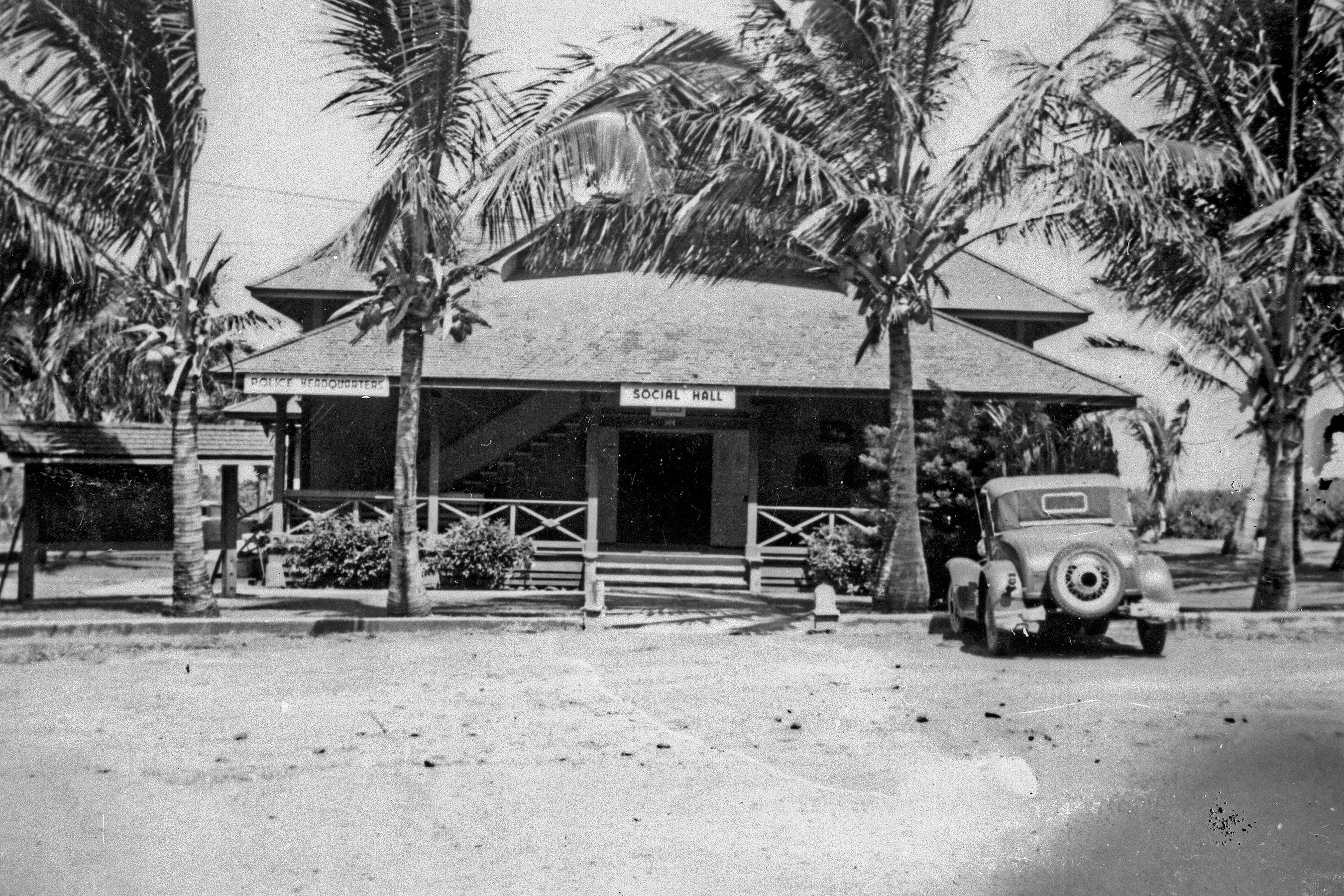 Paschoal Hall 1940s. (Courtesy of NPS/
Paschoal Hall 1940s. (Courtesy of NPS/
Flights for Patients and Entertainers
To the delight of the residents, Judd instituted sightseeing trips by plane for the patients. More than one hundred fortunate patients (four at a time) took advantage of those short excursions and were grateful that Judd had initiated such flights. Bill Malo explained, “There were four of us who were given the first ride on the airplane. Mr. Judd said one afternoon, Andrews Flight Company is coming and will give you a ride around for 10‒15 minutes for $10.00. Travel then started around the area.”[68]
These brief flights around Moloka‘i expanded to other islands, such as Maui and Hawai‘i. The only stops made were to refuel the engines when needed. Judd thought it would also be nice if the patients could enjoy brief meetings with family at fueling stations on various islands, with the understanding that there be no physical contact. One patient, Makia Malo, remembered Judd’s flight plan:
He had arranged for patients to charter flights out of Kalaupapa, to go home to their home island. They could charter the flight and go over, fly to big island and they can go up there but they cannot leave the plane so at least they can see their family. And so all you had to do was telephone your family, they come here on a certain date. So you charter the flight and you go to big island or Maui, Lāna’i, wherever. It was the patient’s choice. And so this happened a lot.[69]
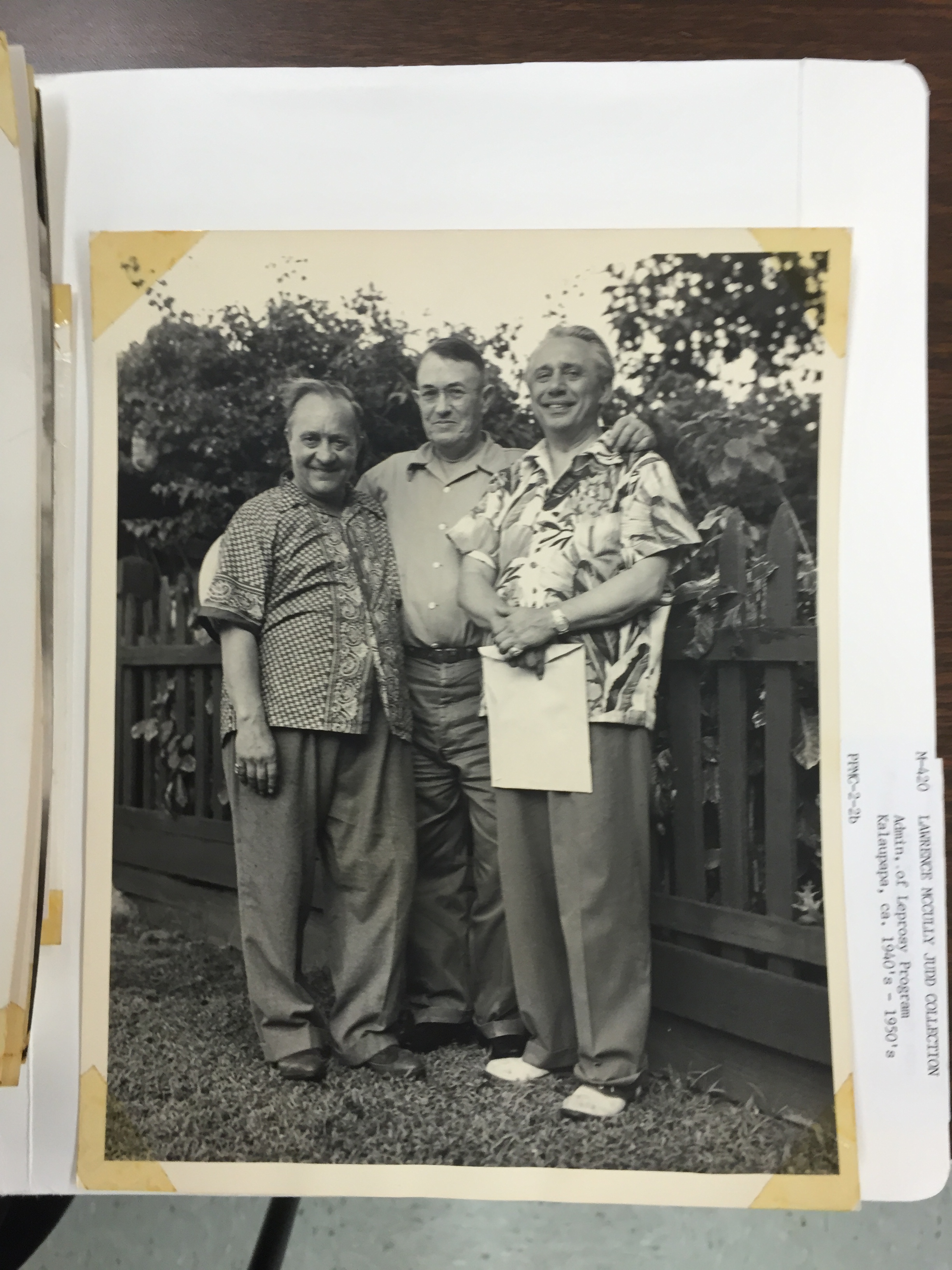 Lawrence Judd with Comedians Harold Johnson (left) and John Olsen (right), 1948. (Courtesy of Hawai‘i State Archives.)
Lawrence Judd with Comedians Harold Johnson (left) and John Olsen (right), 1948. (Courtesy of Hawai‘i State Archives.)
Unfortunately, after seven months of joyful excursions, Judd’s boss in Honolulu, H. A. Kluegel, caught wind of the sightseeing flights and ordered a detailed report of what had been going on, as well as a list of every patient involved and who gave authorization. Among other things, Judd explained:
The plane flights were authorized by me in the absence of any rules, regulations or expressed policy of the board to the contrary. I do not know of any action that has contributed more to the joy of the patients concerned. These trips were definite morale builders, and, in my judgment, should not only be continued but encouraged.
The primary purpose of the trips, as initiated, was to provide sightseeing trips via airplane. The initial trips were made without landing at outside airports. As the trips were extended, it became necessary to refuel the planes and, thus, patients were able to arrange brief visits with relatives and friends at refueling points. . . . In each case the destination of the plane was Kalaupapa airport.[70]
Kluegel’s response was simple and to the point: “Stop the flights.” That was the end of flying high.[71]
With the flights cancelled, Judd found a way to bring the world to Kalaupapa: importing entertainers via air travel in order to boost the morale of the community. For example, one news editor observed that “an orchestra was flown in from Honolulu accompanied by six dancers of Honolulu nightclub fame.”[72] Superintendent Judd made sure there was an abundance of outside professional entertainment, which included big names like “Shirley Temple, Irving Berlin, Edgar Bergen, Dennis Day, Olsen and Johnson, Art Linkletter, Tarbell the magician, Paul Robeson, and many outstanding entertainers.” All entertainers performed free of charge at Kalaupapa.[73]
After her personal visit with some of the patients, Shirley Temple wrote a heartfelt letter from Washington, DC, addressed to Hale Mōhalu in 1951, which reveals that she was deeply affected by the experience she had with them:
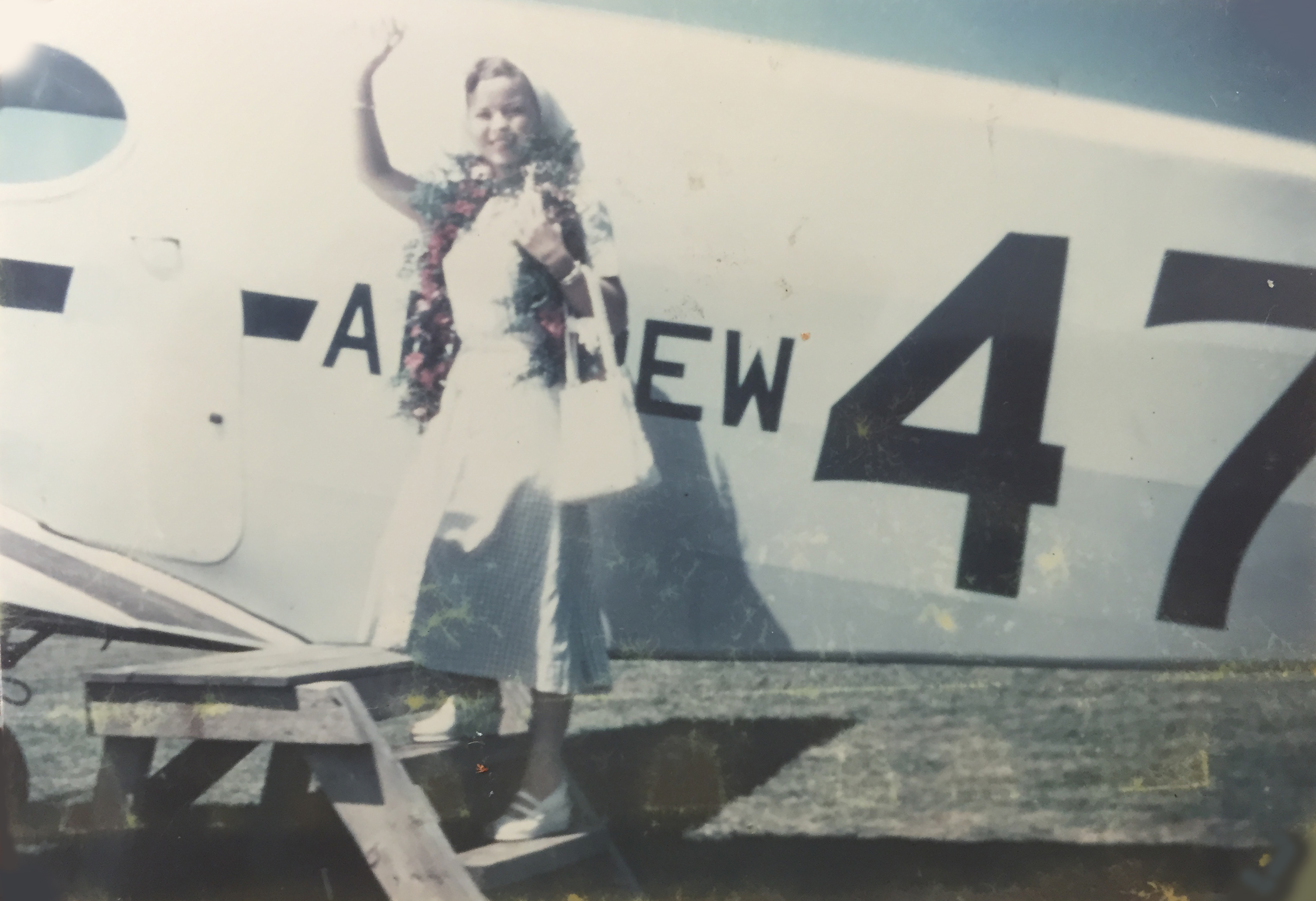 Shirley Temple arrives at Kalaupapa, 1949. (Courtesy of NPS/
Shirley Temple arrives at Kalaupapa, 1949. (Courtesy of NPS/
Dear Friends of Hale Mōhalu
It has been over a year since I visited with you, but the day still is fresh in my memory and all of you secure in my heart.
I regret that my departure that day for Kalaupapa did not permit me to spend more time with you. I did so enjoy your singing, visiting your rooms, seeing your beautiful social hall, and above all, talking to many of you.
The ways of Fate are not always easy to understand, and each of us bears some share of the burden. To those who shoulder a heavier load than the rest must go praise equal to their patience and fortitude. It is in this spirit that I send this letter with my deepest admiration for the dignity with which you live your lives.[74]
Presence of LDS Full-time Missionaries
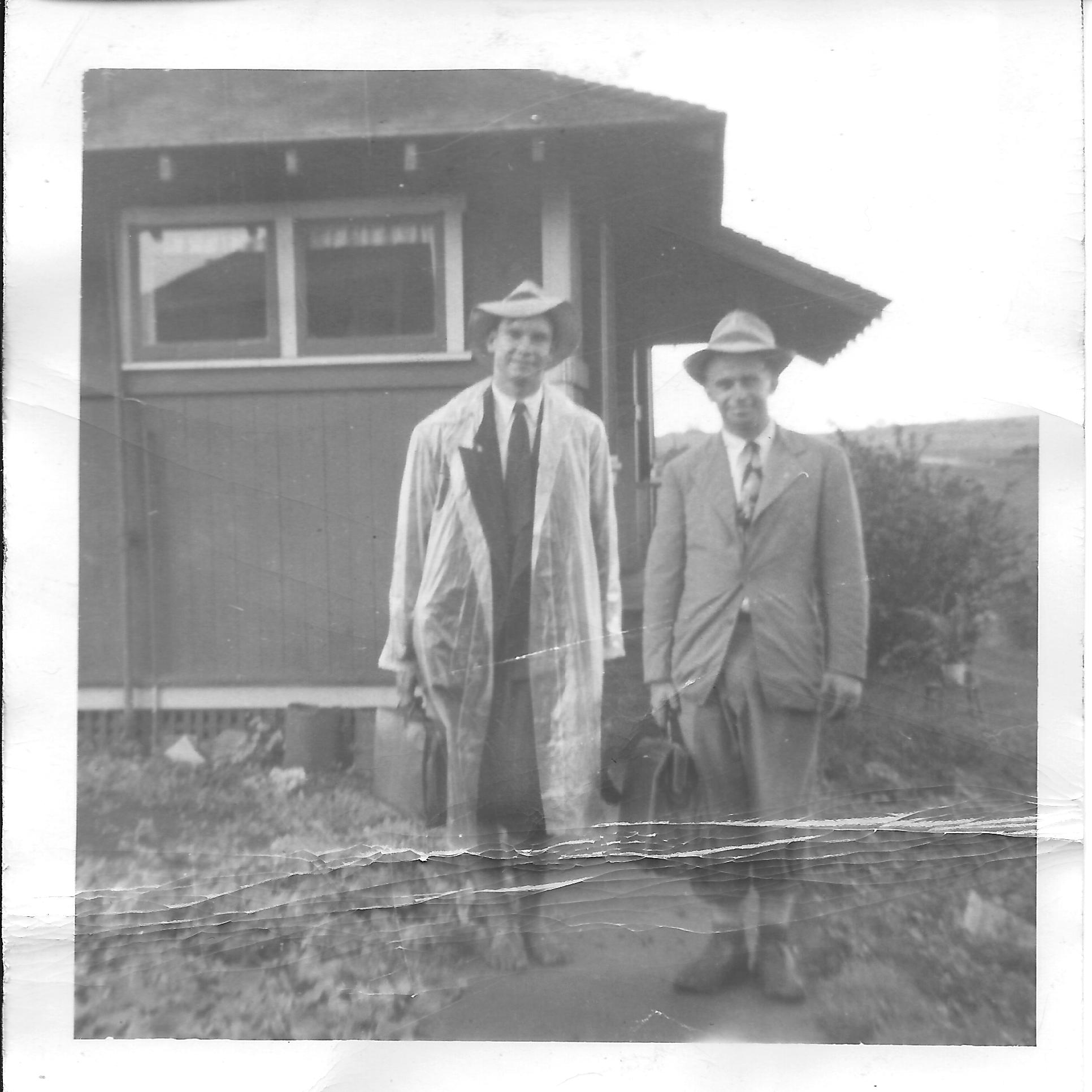 Elders Jack L. Halvorsen (barefoot) and Eldon R. Littlewood, in front of their mission living quarters, Ho‘olehua, Moloka‘i, 1948. (Courtesy of Jack L. Halvorsen.)
Elders Jack L. Halvorsen (barefoot) and Eldon R. Littlewood, in front of their mission living quarters, Ho‘olehua, Moloka‘i, 1948. (Courtesy of Jack L. Halvorsen.)
During the Judd era, Mormon missionaries were permitted to live full-time in the settlement for the first time. Commencing in the late 1940s, these young men dwelt on the Kalaupapa peninsula as neighbors of the patients and blessed many through their service. Judd particularly singled out one young LDS missionary, apparently Jack L. Halvorsen, who stayed at Kalaupapa about six months and did outstanding work as a Boy Scout leader.[75] Halvorsen, while serving as the LDS district president of the Moloka‘i District, had written to Judd requesting permission to have the Mormon missionaries live in the settlement. In a letter to Judd, dated February 10, 1948, Halvorsen articulated his request:
I wish to express my appreciation for the privilege I have made of making your acquaintance and I wish to thank you for your courtesy and cooperation that has been extended to me and my co-laborers during our visits to Kalaupapa. It is with pleasure that I make the following request, hoping that it will meet with the approval of all concerned. During our past visits to the settlement, and in our association with the members of our Church there, we have felt a need for Missionaries to be stationed there permanently. We have some fine men as leaders, but they are not very progressive. And for this reason the members of the Church . . . desire to have Missionaries labor at Kalaupapa.
My co-laborers and I would not only feel it a privilege but a pleasure to labor among the people of Kalaupapa. I therefore discussed this matter thoroughly with President E. Wesley Smith of the LDS Hawaiian Mission and he felt that it would be a fine thing and asked me to proceed with the arrangements. Inasmuch as we have a Mission house at the Settlement our housing facilities would be well taken care of.
I am sure that you are familiar with these conditions and I am sure that you will be able to help us in many ways. I wish to assure you that you can depend upon cooperation from us and we want you to feel free to ask us if we can help you in any way. It is with these thoughts in mind that I write this letter and I sincerely hope that Elder Lisle Russon and I will be granted the same rights and privileges as the Ministers of the various denominations now laboring at Kalaupapa.
We are prepared to begin our labors as of February 12, 1948 and hope that if we receive permission, that we may do some little thing to help our people not only spiritually but to help them to become better citizens and to more fully develop their appreciation for their fellowmen. It is with sincere gratitude that I extend my “Mahalo” in advance for any help you might be able to render us.[76]
Judd promptly forwarded this letter to his supervisor, H. A. Kluegel, with a note: “I firmly believe that the request should be approved and so recommend. Undoubtedly, the presence here of permanent missionaries of LDS will be on [sic] benefit to the settlement.”[77] Less than a week later, Judd wrote to Halvorsen, informing him, “Your request has been approved by Mr. H. A. Kluegel.”[78]
Elder Halvorsen and his companion, Elder Russon, already acting in faith, were listed as arriving in the community three days before receiving Judd’s letter to commence their service in the Kalaupapa community. Both would spend several months there: Russon served until June 25, and Halvorsen served until August 3.[79] This was an important transitional period for The Church of Jesus Christ of Latter-day Saints, and especially for the local Kalaupapa Mormon congregation, as it was the first time missionaries were permitted to live in the settlement rather than just visit for a day or two and return to topside Moloka‘i or other places.
Records compiled during Judd’s administration reveal that Halvorsen was quickly immersed in the Kalaupapa Boy Scout troop, leading out in planning scouting events. Just two weeks later, a Kalaupapa recreational activity report read, “Induction of new officers for the organization. Scout Master, Kenso Seiki, in charge. Elder Halvorsen assistant.”[80] Thus it appears that Halvorsen (with Judd’s support) initially provided the leadership opportunity to Kenso, with the intent to train him to serve competently as the new Scoutmaster. This practice was (and is) common protocol in the LDS Church, as established by the founder, Joseph Smith Jr., who said, “I teach them correct principles and they govern themselves.”[81]
LDS Hawaii Mission President E. Wesley Smith, eager to learn more of the transition of his missionaries to Kalaupapa, wrote to Halvorsen, asking how arrangements were coming along.[82] Halvorsen responded with this report:
It is with pleasure that I inform you that our request has been granted and we are now residents of Kalaupapa. The Saints are so happy that they can hardly stay away and are trying to do everything in their power to help us to get our house fixed up a bit. The people as a whole of Kalaupapa (including the Staff and Kokuas) seem very happy to have us with them and are doing everything they can to cooperate.
Although Halvorsen was thrilled with the warm acceptance by the entire community, he did take opportunity to describe the unique circumstances and challenges living at Kalaupapa presented:
The conditions here are quite different than they are in most places and we have to be very careful in the things we do, but I think that we will be able to help our people here very much as well as what little help we can give to the community. One of the problems we have met up with in fixing our house we are unable to buy anything other than postage stamps and there are some things that we need. We need either a desk . . . or a table that can be used for the same purpose. Mr. Judd has informed me that we can have anything brought in from Honolulu on the boat without charge. So if you find something suitable it should be taken to [the] pear [sic]. We also need a shower curtain for our shower as the one we have is all worn out, do you think the mission could furnish us with one? [83]
Two weeks later, President E. Wesley Smith responded to Halvorsen, manifesting his support and pleasure with Halvorsen’s attitude and work ethic:
I am very much pleased with the spirit of this letter and the genuine missionary spirit that seems to radiate from your soul. . . . Now, Elder Halvorsen, it is my desire to cooperate with you 100%. Now that I know how you feel and that you are really enjoying your work at Kalaupapa and with the spirit you manifested in your letter I know that you will succeed in doing a grand and noble work there among the people of Kalaupapa. I appreciate the fact that Superintendent Lawrence Judd has asked you to serve on the advisory committee for vocational training and that you are building a carpenter shop that you may be able to teach the boys along vocational lines.[84]
Halvorsen was followed by other missionaries who would both give and receive from the Kalaupapa community. One was Jerry Hayes, who replaced Halvorsen in August of 1948. This change of assignment was a great concern to Jerry’s parents, causing his father to write a letter to President Smith. Five days later, President Smith responded to the father’s letter, reassuring him of the precautionary measures taken at the settlement and of the wonderful opportunity this experience afforded his son. Due to the rich content of material, it is provided below in its entirety:
August 31, 1948
Mr. Grant E. Hayes . . . Salt Lake City, Utah
My dear Brother Hayes: This will acknowledge your most interesting and greatly appreciated letter of August 26 regarding your beloved son Jerry Grant Hayes.
I sincerely, appreciate the interest you are taking in your son. . . . I can readily understand your feelings in regard to his last appointment to labor at Kalaupapa, the leper colony. I can also appreciate the feelings of his good mother and the fear that may enter your hearts. Naturally you are concerned, and I can appreciate the fact inasmuch as you do not understand the conditions there and the circumstances surrounding this appointment that you would be disturbed in your feelings and there would be a sense of fear that in some way your son might be contaminated with this disease. Personally, I feel that this appointment is one of the choicest in all the Mission. During the past year this privilege was granted to have Elders remain there, and they will gain much in testimony, knowledge of the gospel, power to express themselves that they could not receive in any other place. They are associating directly with the Superintendent of the Colony, Supt. Lawrence Judd, former Governor of the Territory of Hawaii. He and his wife are there directing the welfare of this community; therefore, your son and my nephew, Elder Smith, are closely associated with this good man and his charming wife; thus, they will be able to learn a great deal that will benefit them the rest of their lives.
They in no way come in contact with this disease. They have a lovely home, well equipped with all the modern conveniences that you have in your own home. Their food is purchased - - that is, their food is provided for them through the government commissary. Mr. Judd secures his food from this same place and in no way do those who are afflicted with this disease come in contact with or have anything to do with the food, and, therefore, there is no worry there. Their going and coming and their relationship in the community is strictly governed under medical rule. There are a number of white people who live there in the Colony. In fact, more than one-third of those living there are not lepers. I would suggest that you contact Bro. William Waddoups, who now works in the Genealogical Society, 80 North Main Street. For 5 years Bro. Waddoups and his charming wife had this responsible position to give you first-hand information that will give you much comfort and joy, I am sure.
Now, Elder Smith and Elder Hayes are not confined permanently to the Cilony [sic, Colony]. They meet frequently with the other Elders on the Island of Molokai. In fact, our Branch at Hoolehua, Molokai, is one of the largest and strongest branches of the Church in the Hawaiian Islands, so your son has the privilege of meeting frequently with these other missionaries where they can have their testimony meetings, where they can meet in social life, and thus have opportunity to speak and develop in many ways. Practically every missionary laboring in the Hawaiian Mission is eager to have this opportunity of going down to labor, and the feeling is that your son is being greatly favored with this privilege.
It is not my policy to change missionaries often when they are assigned to a district, but in this case, it is my desire to give as many of the missionaries this opportunity as possible, so your son was instructed to develop as much as possible and give as much as he can to the development of the people there, and to their encouragement, so that when he is transferred to another part of the Mission he will be better qualified to handle the situations that will present themselves to him. When he leaves the Colony for his next assignment, he may remain there for at least a year, for it takes a year in order for us to get acquainted with the people and thus be qualified to do real missionary work. Where missionaries are transferred around too much, they lose contact with the people, they fail to gain their love and understanding, and thus are not able to accomplish as much good as when they can remain in one place.
President Matthew Cowley will return to Salt Lake soon after the 25th of September. He will be in Salt Lake City for the October Conference. He has had the opportunity of visiting the Colony at Kalaupapa, and it would not be amiss inasmuch as you are acquainted with him to have a talk with him, and after this visit with Bro. Cowley and Bro. Waddoups, if you in any way have a feeling of timidity or concern, please let me know and your son will be assigned to another part of the Mission. I have had the opportunity of personally visiting there many, many times, and my life, and I feel has been greatly enriched by having had the opportunity. . . . Sincerely your brother, E. Wesley Smith Mission President.”[85]
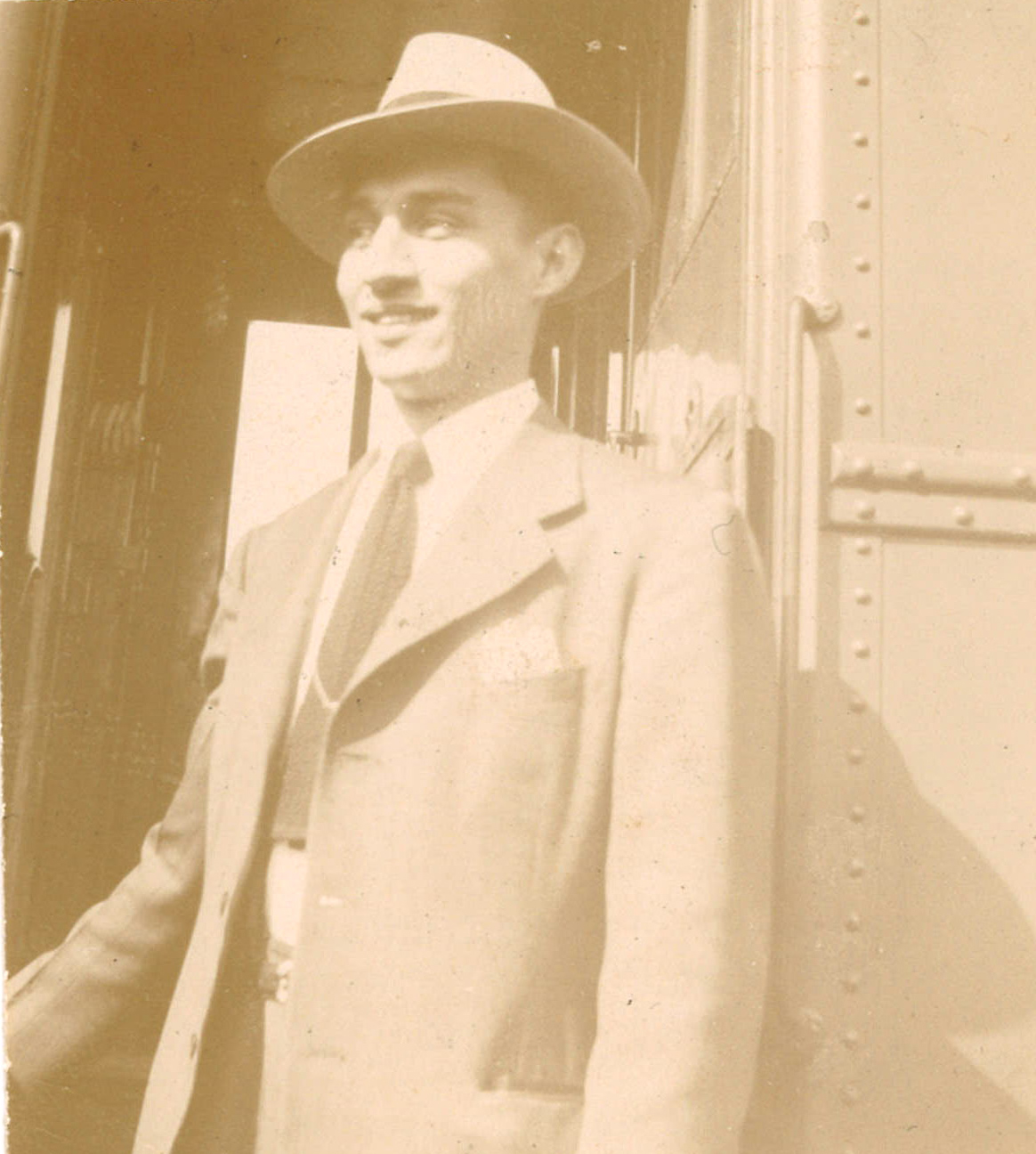 Elder David Hannemann. (Courtesy of David Hannemann.)
Elder David Hannemann. (Courtesy of David Hannemann.)
The letter must have been a great relief to the parents, and Hayes was permitted to continue as a missionary at Kalaupapa, where he served faithfully until late March 1949, when he was replaced by Tausilinuu David Hannemann. Hannemann served as a missionary in the settlement for five months and was dearly loved by the Kalaupapa community and even remembered fifty years after his departure.[86] Hannemann, then a twenty-three-year-old half Samoan, described his work at the settlement and the rich experience he enjoyed among the Kalaupapa ‘ohana (family):
I arrived in Kalaupapa the first week in March, 1949. And my first companion was John [L. Jeppson] from Idaho. . . . [John] and I relieved Jack Halvorsen, the first elder to be assigned to Kalaupapa. . . .[87] When we arrived, Elder Jepson took me to meet the branch president, Brother [Jonah] Mahelona. And then also Brother Jack Sing. He was the pillar of the Church there in Kalaupapa. And we had a nice cottage, the mission home. So I was very impressed. I was excited. [I thought] this is different, . . . I expect[ed] to be wearing my suit and go tracting, but that wasn’t the case, because we just went out in street clothes.
Elder Jepson, a very good companion, gave me a very good orientation, that during the day we just wear our plain clothes. There’ll be no tracting. Our assignment is to work with the Boy Scouts. He also took me to meet the next day to meet the Catholic priest, Father Logan. And the Catholic nuns, [Sister] Wilma, I . . . was very impressed with her, because she wore a white robe—usually Catholic nuns I’ve known over the years wear black clothes. And they seemed to be very dedicated ladies. Oh, they were ladies. And then we also met the Catholic brothers who were teachers, they were very good cooks. And the Catholic and the Protestant ministers. . . . The Catholic priest and the sisters were assigned with the patients at the hospital. The Protestant minister worked with the patients with arts and crafts. And the Mormon Elders would work with the Boy Scouts. . . . Oh, it was wonderful. . . . There was a good feeling among all people.
We visit our members quite often, and hold meetings in their homes, or they invite their friends. . . . We were very well received by the people that they invited to attend, and of course we had refreshments afterwards, so . . . people love to eat. . . . I was supposed to be impressed with . . . how faithful our members were; . . . they were very faithful. . . . I would say in attendance about an average of about fifteen people. . . . Another benefit that I really appreciate, the territory extend commissary privileges to the elders, . . . the Catholic ministry, priests of the Protestant, so twice a week, we’d go to the Protestants for all the food we want to eat. . . . The only expense I had was for my rent, fifteen dollars a month. . . .
We never had any joint meetings with any other churches but we do have Kalaupapa holidays meant a lot to them, like Easter, Thanksgiving, and we would hold a special service . . . for their enjoyment, and accommodate them. But for the boys [Boy Scouts] we’d go hiking up in the mountains. . . .
People seemed to get along very well. And another thing impressed me: the homes. They’re very meticulous, how they maintain their homes. And their yards, they keep it mowed. And practically every one of them has a visible garden. Brother Jack Sing, had a beautiful visible garden, and he also raised chickens. The people were very nice to us. They were very good to us. . . . The Catholic nuns, the Catholic brothers were very good cooks. I don’t know how many times my companion and I were invited over to their home for dinner. They were so gracious. And we all share the same common interests—it’s the patient. And the Catholic priests, the brothers, the nuns, they seemed to carry on the spirit of Father Damien. In the hospital, on a very hot day, you never see the sisters remove their robes. . . . I have a lot of respect for that. . . . It’s the feeling. The good feeling. Because when you’re in Kalaupapa, when I was in my mission, you know we really didn’t have Catholics or Protestants or Mormons, we’re all one big ‘ohana. Even the employees, they would wave at you, we’d wave at them. . . . So it’s a good feeling. . . . Really good family, ‘ohana.[88]
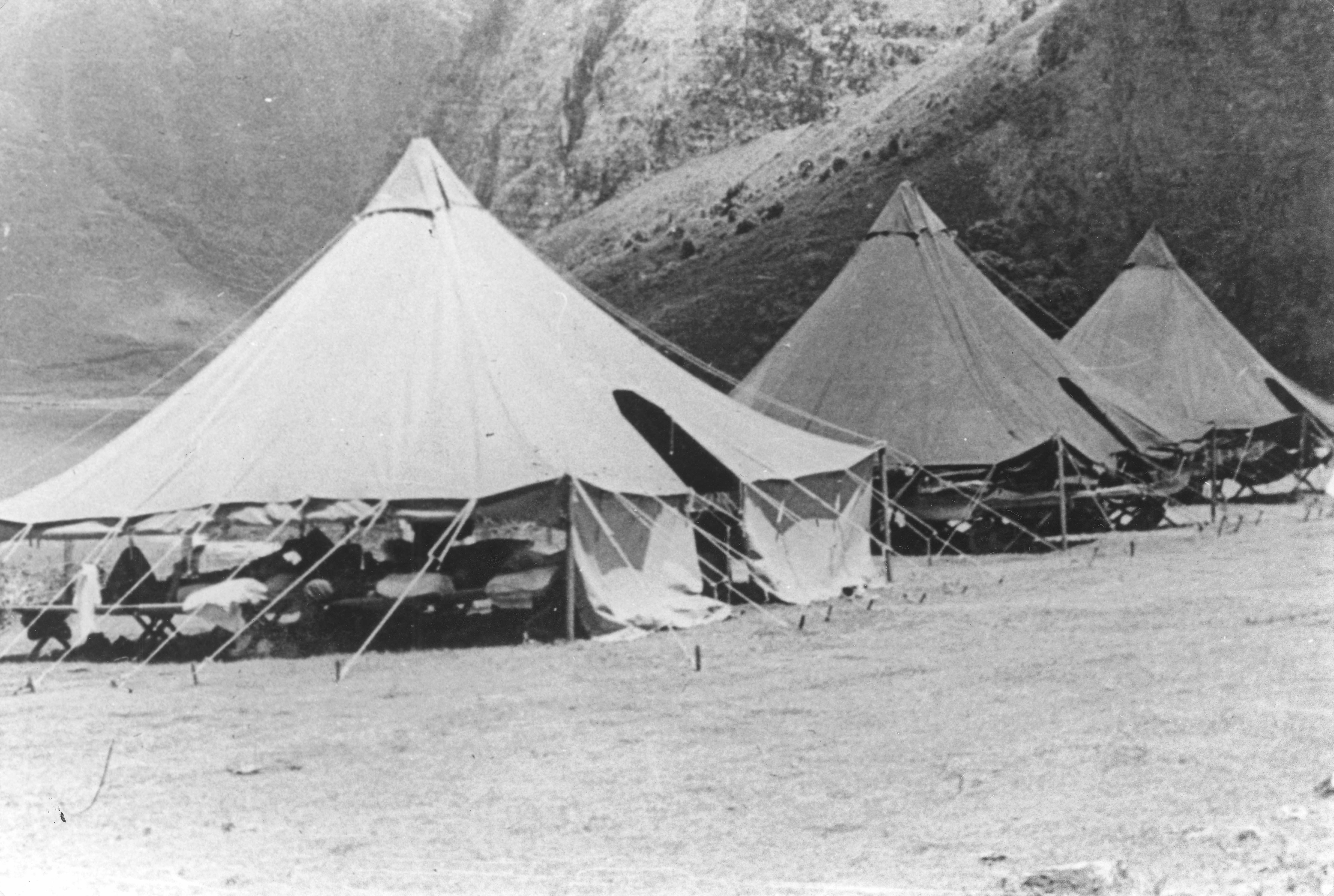 Boy Scout Camp at Kalawao, ca. 1940s. (Courtesy of NPS/
Boy Scout Camp at Kalawao, ca. 1940s. (Courtesy of NPS/
Ecumenical Community of Hope and Goodness
Mormon missionaries such as Halvorsen and Hannemann left their mark on the community, which patients remembered decades later. For example, Edwin “Pali” Lelepali remembered that the Kalaupapa community had good feelings toward the elders. Pali recalled playing football and pool with them and also remembered how the missionaries would visit the hospital and pray with the patients.[89] Yet the Kalaupapa experience was reciprocal, and the patients had a definite impact on the missionaries and others who visited the settlement as well. Elder Hannemann, like so many other Kalaupapa visitors, tried to describe the unique and singular spirit of the Kalaupapa community. It had the power to infuse goodwill and dissolve barriers of prejudice and malice—a community forged in the furnace of common affliction, consisting of people torn from family and friends with no one to turn to except each other. So that is exactly who became their family—one another.
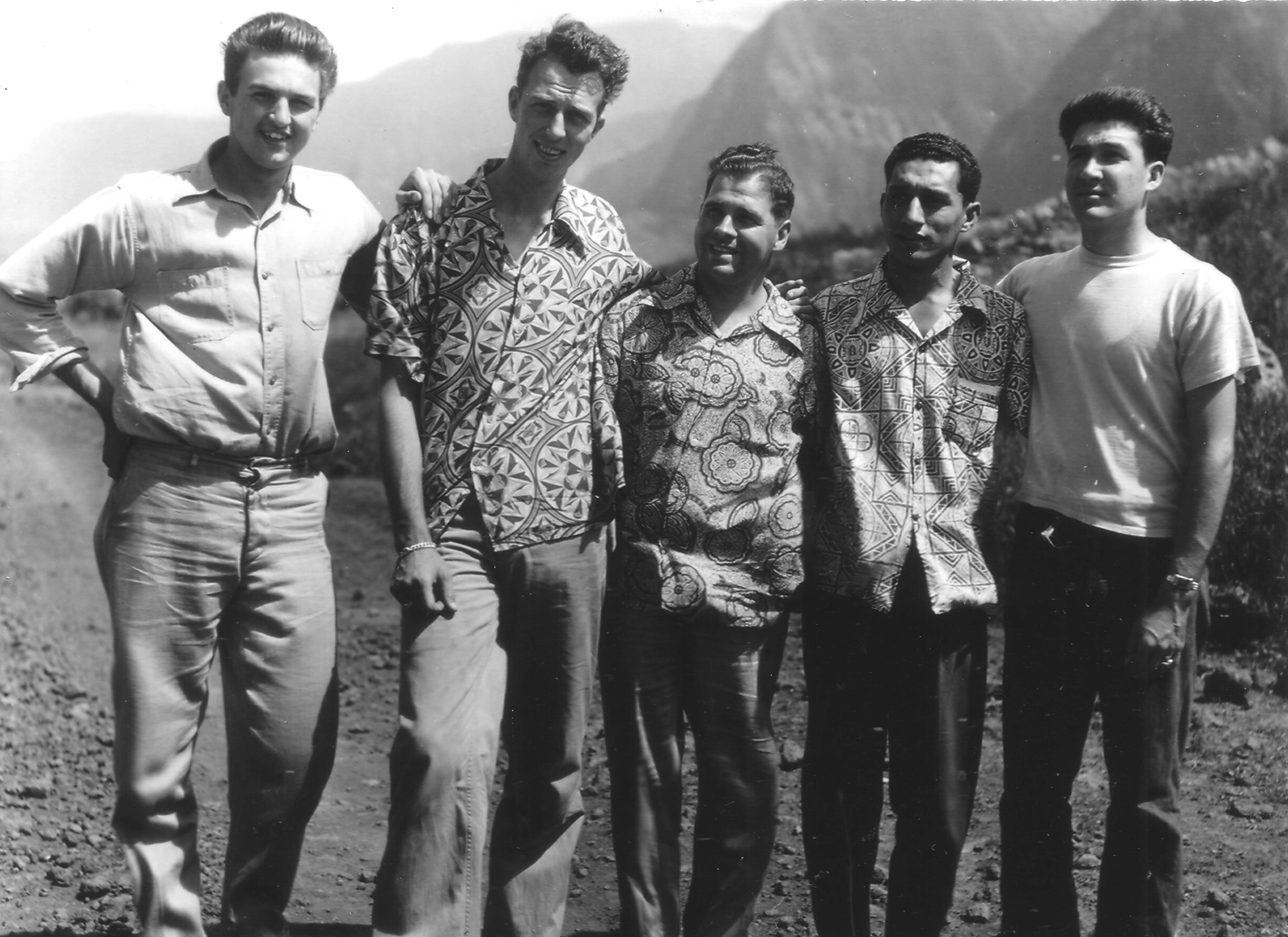 David Hannemann and other LDS missionaries on the Kalaupapa peninsula, 1949. (Courtesy of David Hannemann.)
David Hannemann and other LDS missionaries on the Kalaupapa peninsula, 1949. (Courtesy of David Hannemann.)
Another Mormon missionary, Elder Daniel S. Hess, felt the power of this special place after spending Christmas at the settlement in 1947. Hess recalled, “In climbing back up the narrow trail, I would look back at the settlement and my heart was moved toward it. There lived a group of people separated from the world, a people that were noble, that carried forth under the greatest of trials, and yet they showed happiness. . . . Their spirits and hopes were held high. They put their trust in God.”[90]
An ecumenical service held on Easter Sunday 1948 captures the genuine spirit of community there. Initiated by the Protestant Kana‘ana Hou Church, and with lumber donated by the board of hospitals, a cross was erected at the summit of Kauhakō Crater, which remains today. Historian Ethel Damon notes, “The two Mormon Elders assisted Pastor Alice in the service; many Roman Catholics were present. . . . The people sang as never before, their joyous message carrying on the wind even to the sufferers in the hospital at Kalaupapa.”[91]
Two years later, many of the patients from various denominations were engaged in a Passion play, reenacting events surrounding the crucifixion of Christ. A cast list notes the name of the production: “Pilate the Governor: A Passion Play presented on Easter Sunday, April 9, 1950.” The names of thirty-six Kalaupapa residents are given, including Fred McCarthy, who was selected for the part of Pilate, while Eddie Marks played the role of Jesus.[92]
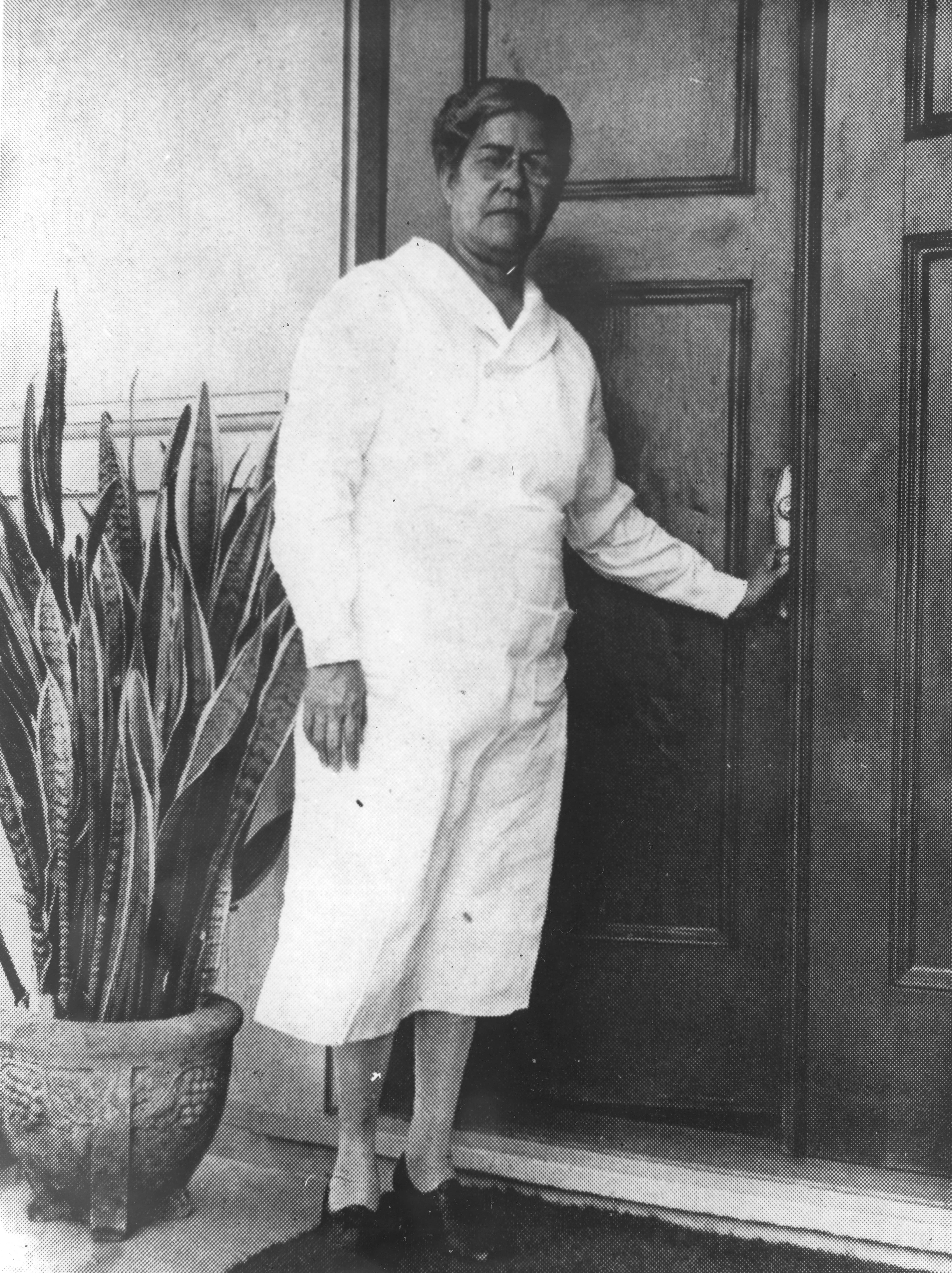 Reverend Alice L. Kahokuoluna in front of Kanaana Hou Church greeting members of her congregation (top of stairs to the right), 1947. (Courtesy of NPS/
Reverend Alice L. Kahokuoluna in front of Kanaana Hou Church greeting members of her congregation (top of stairs to the right), 1947. (Courtesy of NPS/
During the 1940s, Reverend Alice L. Kahokuoluna had a congregation of about seventy-five to whom she ministered, and her service brought spirituality to the settlement. Alice was a blessing not only to the Protestant members she oversaw at the Kana‘ana Hou Church, but to hundreds of patients in the Kalaupapa community as a whole.[93] One patient who knew her personally during the time of her ministry described Alice as being very kind and taking the time to make regular visits to the individual patients at their homes or at the hospital, regardless of denomination.[94] An interesting Mormon document mentions that Reverend Alice attended a Latter-day Saint MIA (Mutual Improvement Association) meeting for the youth on Christmas Eve one year, and that she offered a “word of prayer” and a “short talk” and wished all a “very Merry X mas,” which attests to her ecumenical spirit.[95] Alice served diligently in the settlement for decades and passed away just two months after bidding farewell to Kalaupapa in early 1957.[96]
Another LDS Church Christmas Eve program containing an ecumenical element occurred in 1948. Conducted by Mormon missionary Elder Jerry Hayes, it included prayers and lots of Christmas music. In addition, Lucy Kaona and Elroy “Makia” Malo (both LDS) provided scripture readings. Reverend Alice again gave a “brief talk,” followed by closing remarks by Elder Hayes.[97] This same cooperative spirit continued as patients and friends joined for Christmas activities and pageants, at least one of which was directed by Sister M. Wilma, one of the Catholic sisters.[98]
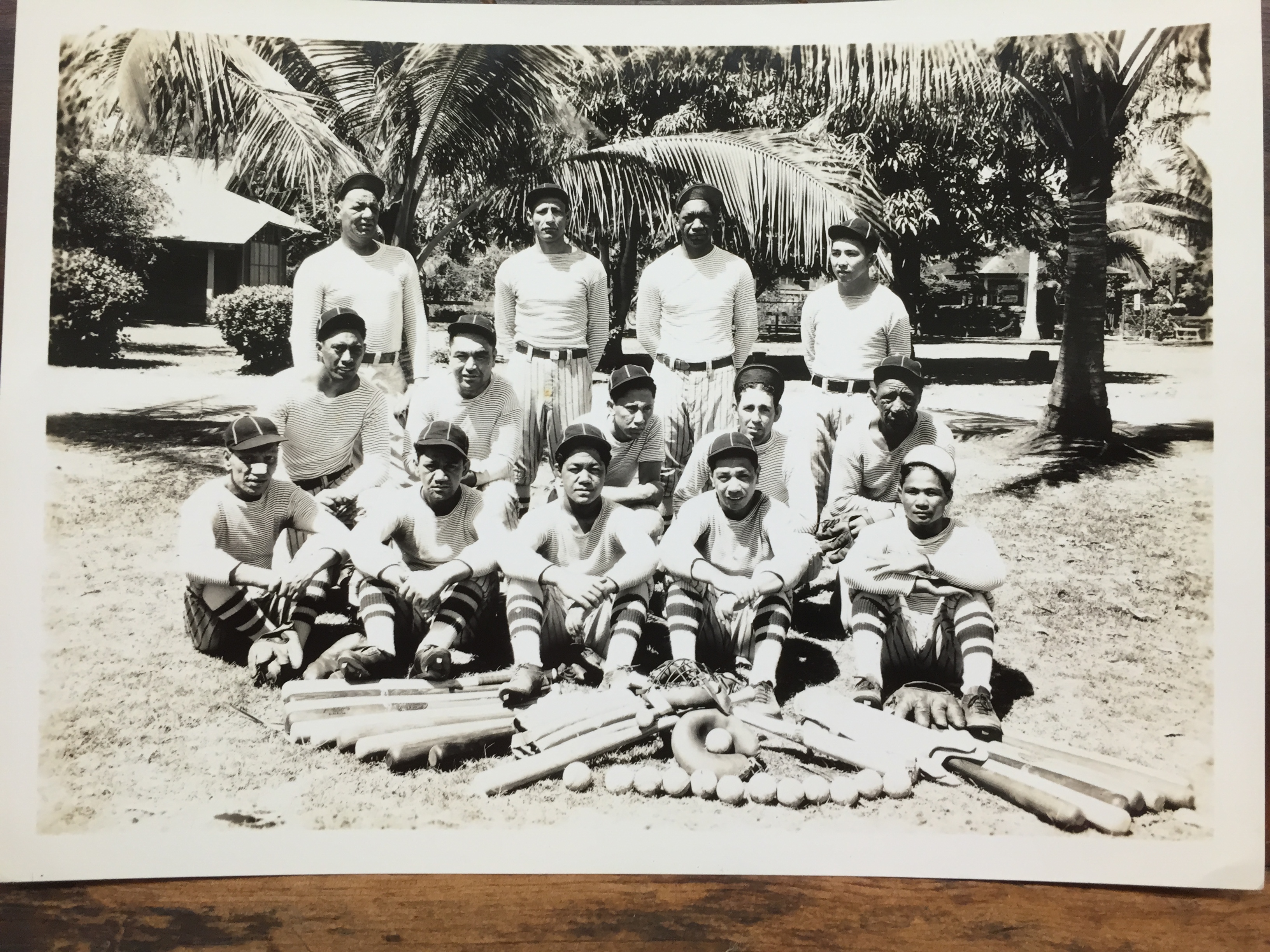 Kalaupapa Softball Team, ca. 1949. (Courtesy of L. M. Judd Collection, Hawai‘i State Archives.)
Kalaupapa Softball Team, ca. 1949. (Courtesy of L. M. Judd Collection, Hawai‘i State Archives.)
A document titled “Report of Recreational Activities for the month of December 1948” noted, among other things, a vast array of activities and socials: band practice, a Boy Scout meeting, entertaining and educational movies, a Lions Club social, ladies night, programs honoring senior members of the settlement, special holiday musical programs, and a three-act play sponsored by the St. Francis Parish and the Holy Name Society all played out during the month. The report concluded, “The Kalaupapa Entertainment Club entertains tonight with a New Year’s Dance affair, bringing to a close one of the most happy and entertaining year ever recorded, which featured an orchestra and guest entertainers from Honolulu.”[99]
Many other wholesome activities took place throughout all the seasons of this era. For example, one visitor observed, “On Sunday afternoon most of the people in the settlement, patient and non-patients, could be found at the ball grounds where an exciting game of softball was played between teams of patients and non-patients.”[100]
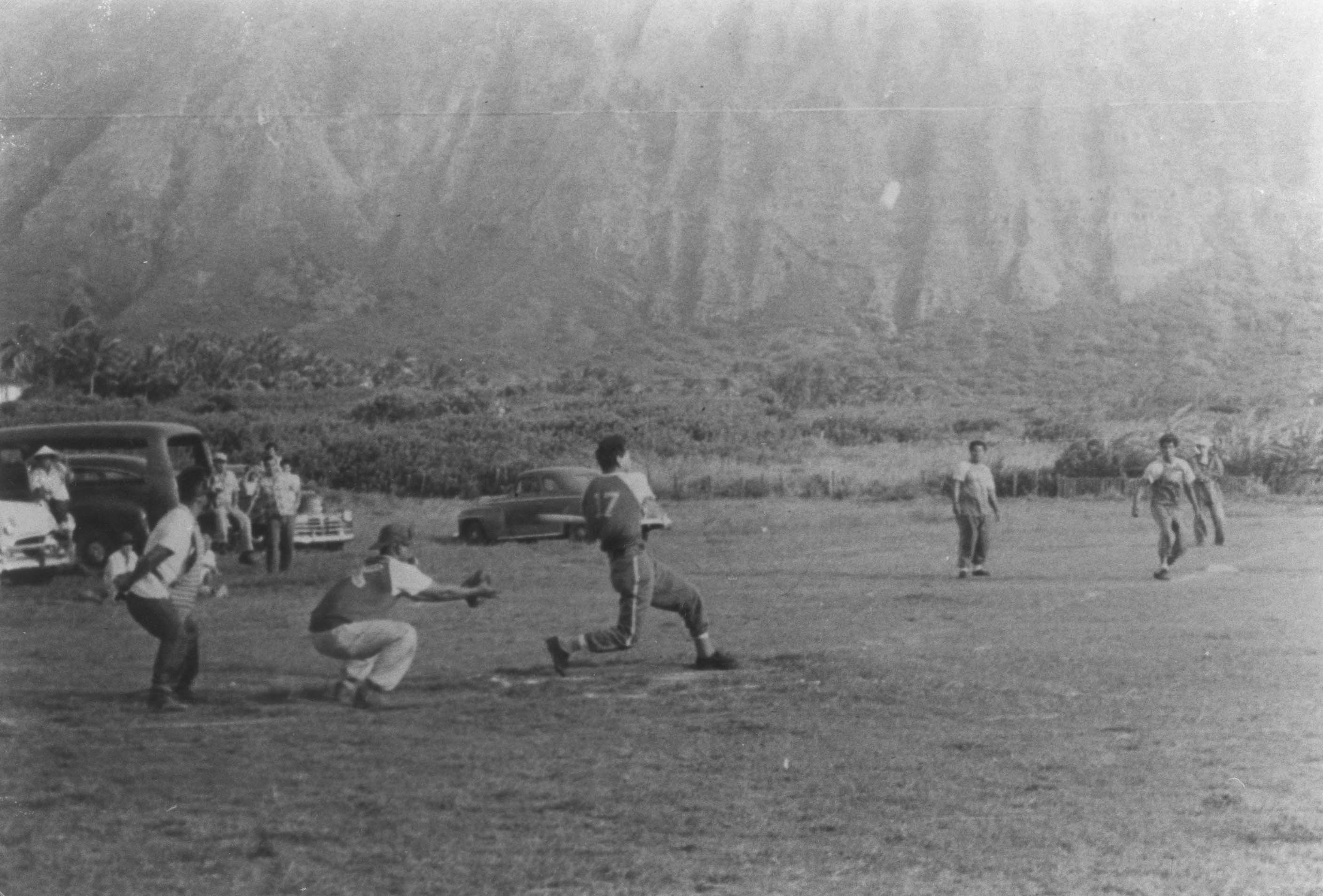 Kalaupapa baseball game. (Courtesy of NPS/
Kalaupapa baseball game. (Courtesy of NPS/
There was also an abundance of music during this era, including the Kalaupapa Choral Group. Dozens of patients were involved in this choir, which met at least weekly for rehearsals. A chart shows that this group took their music quite seriously—fines were given for those tardy to practice. Further, they created detailed bylaws and a constitution. The lead officers during the years 1956‒57 were Eva Keao, president; Bernard Punikaia, vice president; Earl Malo, secretary; and Alexander Hoopii Jr., treasurer.[101]
LDS Activity During the 1950s
Ecclesiastical records during the 1950s show that Latter-day Saints continued their attendance at weekly Church meetings.[102] There were also regular visitors of different faiths who attended LDS meetings. For example, when Daniel L. Decker and his LDS mission companion (stationed on topside Moloka‘i) were assigned to take a census of Latter-day Saints in the settlement, Decker wrote that although Brother David Kupele’s blind wife was a Catholic, she had been an active member of the Relief Society for over two decades and “surely has faith in Mormonism.” On the other hand, Decker noted that their census revealed that a dozen former LDS members had joined other churches over the years.[103] Just two weeks earlier, in late May 1950, the last two full-time LDS missionaries to live in the settlement departed; and although elders stationed on topside Moloka‘i continued to make occasional visits, Mormon missionaries no longer occupied the small LDS mission home.[104]
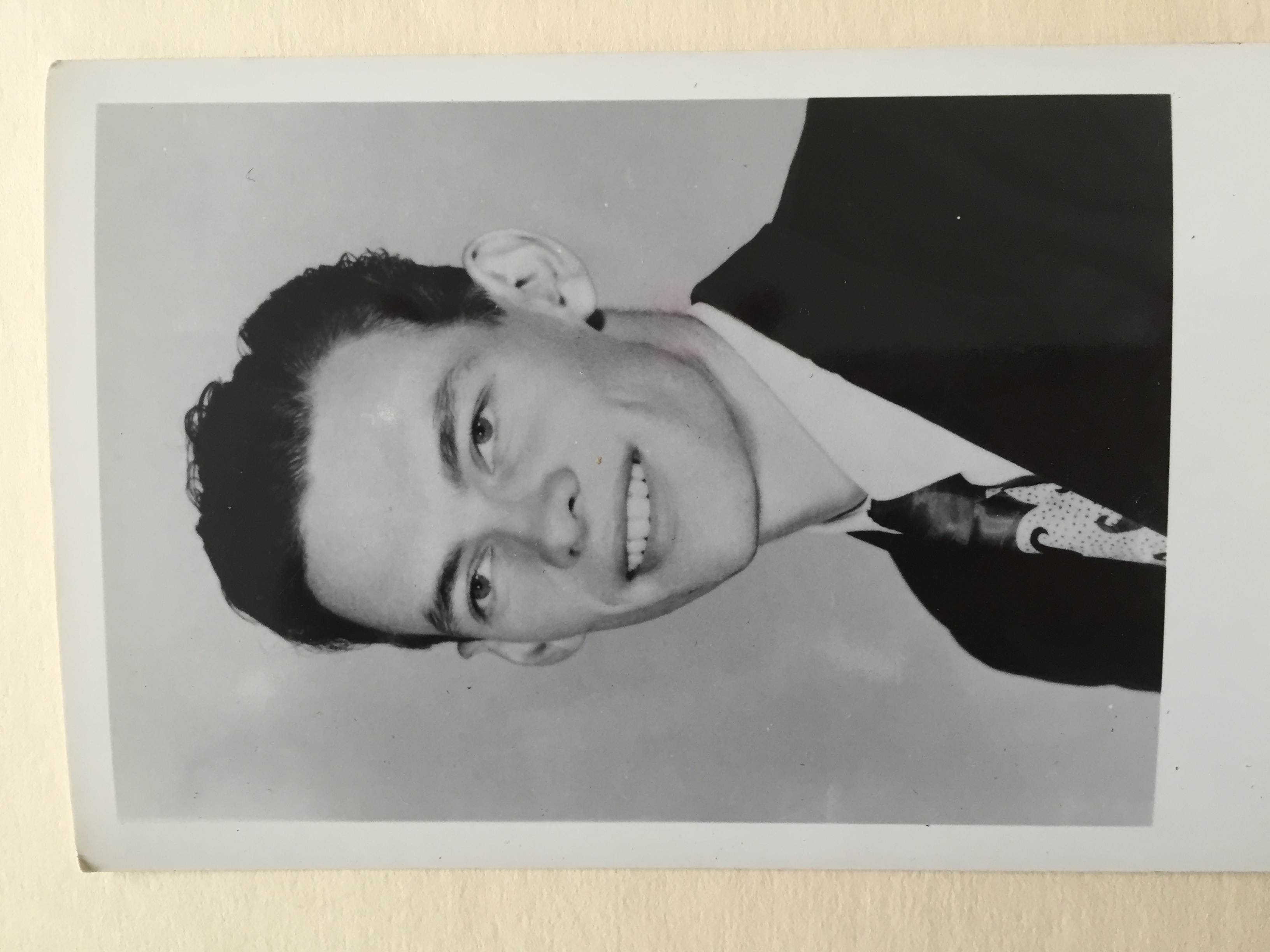 Elder Daniel L. Decker, LDS missionary to Kalaupapa in 1950. (Courtesy of Daniel L. Decker.)
Elder Daniel L. Decker, LDS missionary to Kalaupapa in 1950. (Courtesy of Daniel L. Decker.)
Nevertheless, the patients who remained firm in the Mormon faith continued to attend their weekly Church meetings at the LDS chapel. During this period of time, members presented short talks called “sacrament gems” in sacrament meetings, a general Church practice between the years 1910 and 1980 in which scripture verses of a hymn were used to present a lesson.[105] The Kalaupapa Saints also participated in a “dime fund” at this time, a feature of the general LDS Church Sunday School program.[106] Records show that the typical weekly worship service during this period consisted of Sunday School held at 9:30 a.m. with sacrament meeting following at 10:00 a.m. Sunday School attendance for December of 1954 showed that thirteen out of twenty-four listed LDS members were attending, or roughly 54 percent.[107]
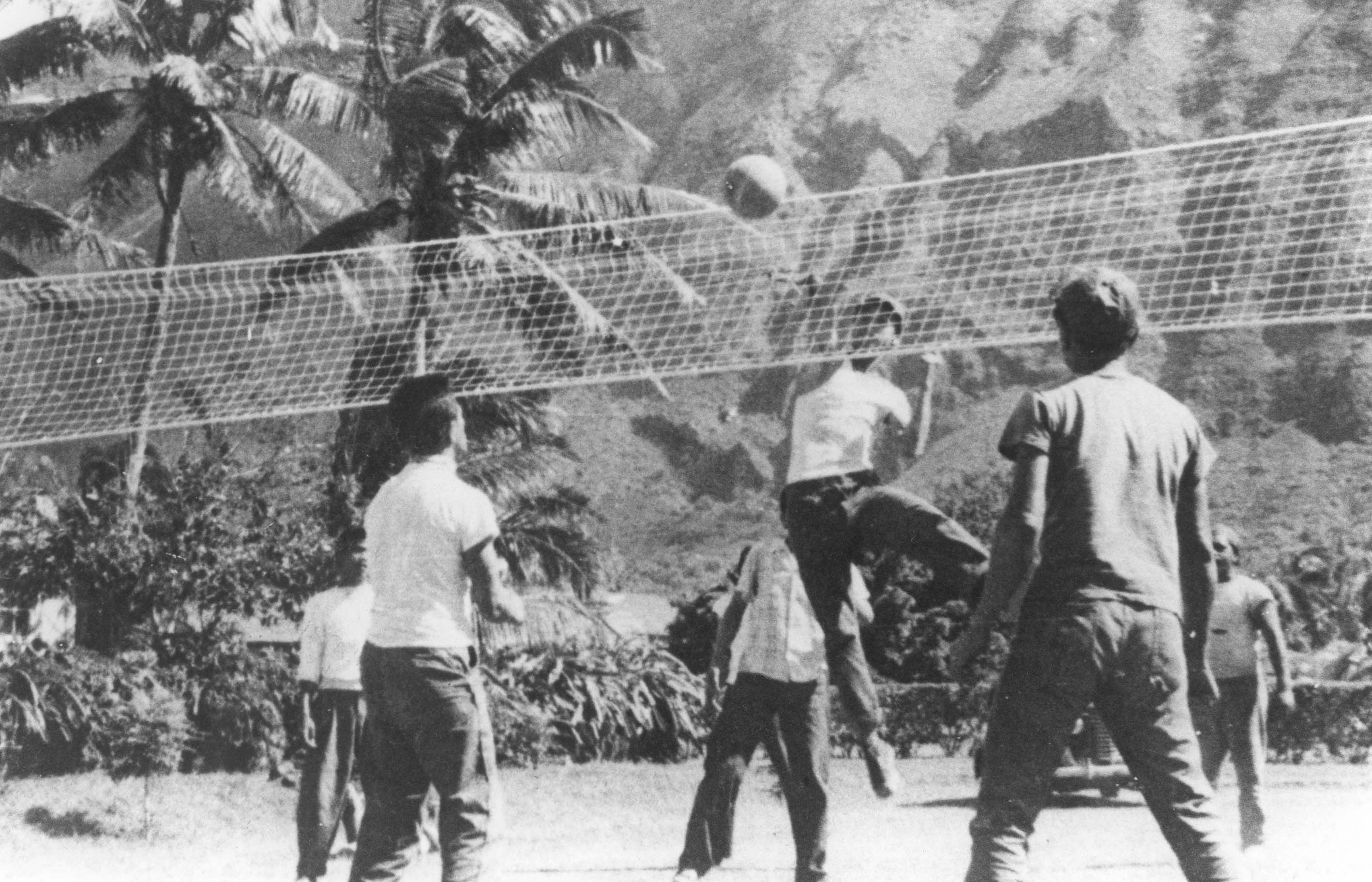 Kalaupapa volleyball game. (Courtesy of NPS/
Kalaupapa volleyball game. (Courtesy of NPS/
At this same time, another Mormon missionary, Elder J. Collin Allan, was making occasional visits to the settlement to administer the sacrament and strengthen local Kalaupapa LDS members during the fall of 1954 and early winter of 1955. He did so while stationed at Ho‘olehua on topside Moloka‘i with his companions.[108] Then a young man, Allan said he enjoyed the trip to Kalaupapa and “always hiked” up and down the pali (cliff). Even though over sixty years have passed, he could still recall some of the names of the members in the Kalaupapa branch. He noted that although there were two pulpits in the LDS chapel, one for patients and one for visitors, he and his companion always sat with the Kalaupapa Saints during the Church meetings and mingled freely, noting, “we were with them in every way.”
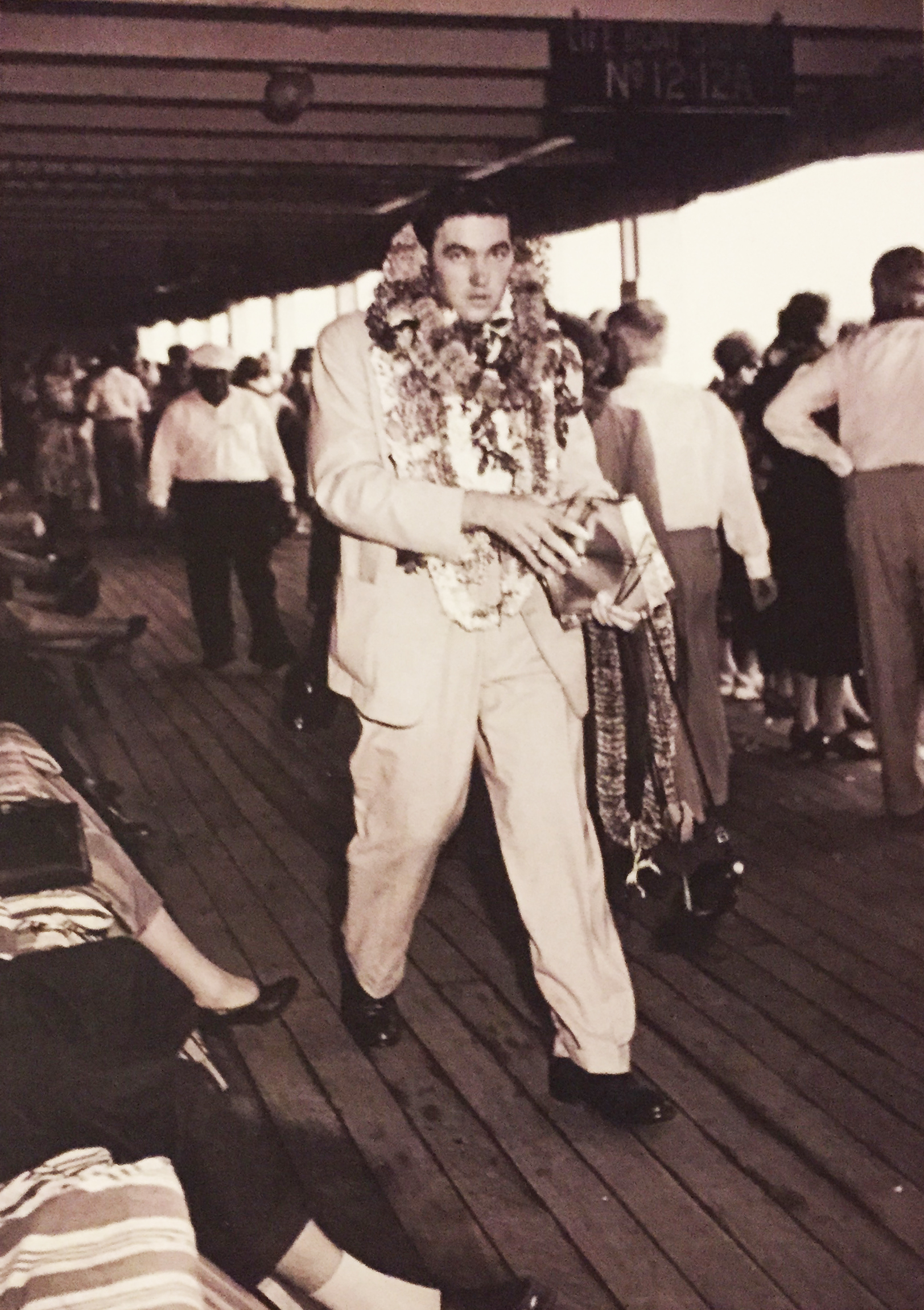 J. Collin Allan leaving Honolulu February 26, 1955 on ship SS Lurline. (Courtesy of J. Collin Allan.)
J. Collin Allan leaving Honolulu February 26, 1955 on ship SS Lurline. (Courtesy of J. Collin Allan.)
One patient who left an indelible impression on him was Brother Kalaukau, who was blind. Allan recalled that Kalaukau would faithfully stand in his priesthood assignment at the back of the chapel to make sure that no one entered while the sacrament was being administered in order to maintain proper reverence—a story he would continue to share with young people for decades. Allan also vividly recalled his experience of helping Brother Kalaukau partake of the sacrament as this faithful, blind Latter-day Saint held a metal cup of water between his maimed fingers.
Another blind LDS patient Allan recalled was Louisa Ka-ne, whom the Saints simply referred to as “Sister Louisa.” He remembered giving her a much-needed priesthood blessing one Saturday when she was very sick from the effects of Hansen’s disease. The following day Allan heard Ka-ne share her sweet witness of the truthfulness of the gospel in a Church meeting. He said, “I will never forget her testimony.” Among other things, Allan recalled that Louisa said, “We Latter-day Saints have everything to be grateful for.” He added, “What precious words from a precious person.” Allan further remarked, “Kalaupapa had a great influence and effect on my whole life. Whenever I hear people complain I think of them.” He also noted, “Their testimonies were simple. They were full of faith, despite their condition. They loved the gospel and loved to visit with you. . . . Their singing was always special, soft and spiritual, beautiful. It touched your heart to hear them. I would describe them as a people of good cheer. Always glad to greet you and make you one of them.”[109]
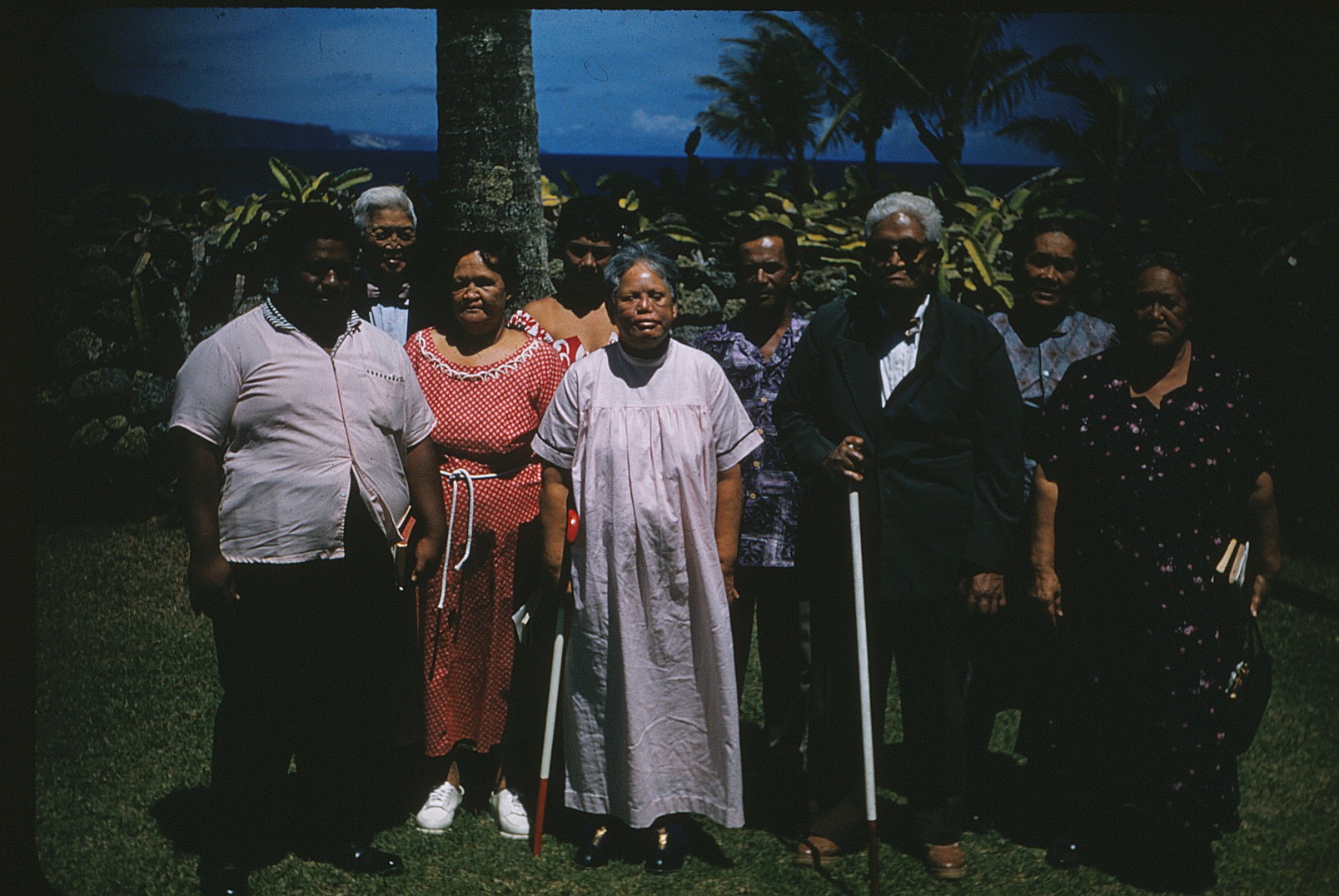 Louisa Ka-ne and Brother Kalaukau, blind LDS patients in middle front row, Sister Kalaukau to the right of her husband, Jack Sing, back row far left, late 1954. (Courtesy of J. Collin Allan.)
Louisa Ka-ne and Brother Kalaukau, blind LDS patients in middle front row, Sister Kalaukau to the right of her husband, Jack Sing, back row far left, late 1954. (Courtesy of J. Collin Allan.)
One Kalaupapa Saint Elder Allan felt connected to was Jack Sing Kong, who went by his middle name Sing. Jack converted to the Mormon faith at the settlement in 1934 and became the local LDS branch president in 1952. In a journal entry dated November 28, 1954, Allan wrote, “Sunday, I taught the Sunday School clan after Bro. Sing gave a good 2 1/
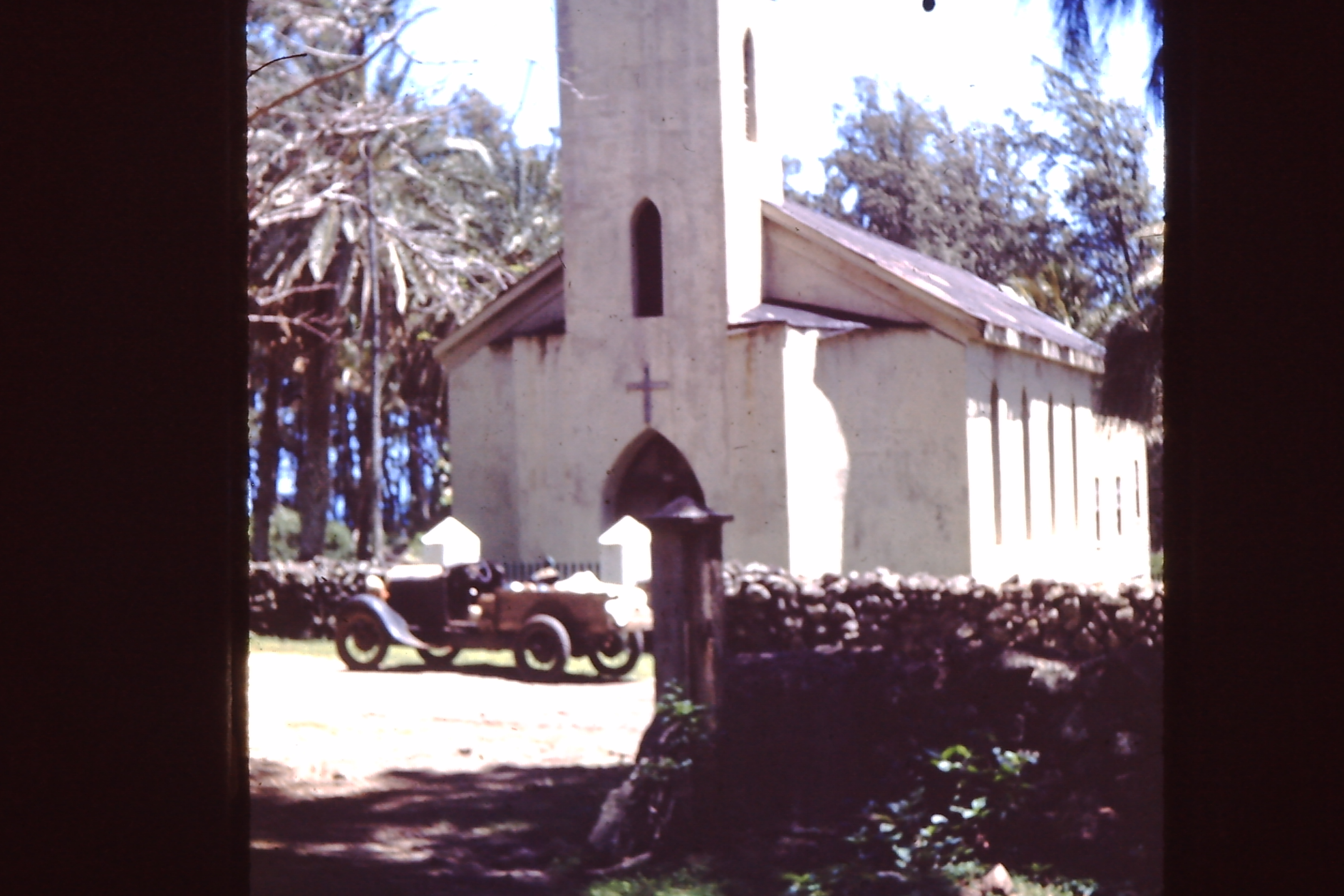 LDS missionary car bought by Jack Sing for $10.00, 1948. (Courtesy of Jack L. Halvorsen.)
LDS missionary car bought by Jack Sing for $10.00, 1948. (Courtesy of Jack L. Halvorsen.)
Jack Sing was also a proverbial fisher of men and was an influential leader of the Latter-day Saints, contributing to the entire Kalaupapa community. Jack was born on December 4, 1892, in Canton, China. According to his dear LDS friend Ku‘ulei Bell, Jack was one of eight children and came from the Kong dynasty. He moved with his parents and siblings to the island of Kaua‘i and was educated through the eighth grade. He married his first wife, Daisy Rebecca Bell, who died after one month of marriage. In 1919, at age twenty-seven, he was sent to Kalaupapa and met Mary Kaehukulani, whom he later married in 1931.[114] Twenty years later (after the disease they battled was arrested), the Sings were permitted to go to the temple, where an eternal marriage ordinance was performed for them. Ku‘ulei Bell referred to Jack as “a truly holy man and a very kind man.”[115]
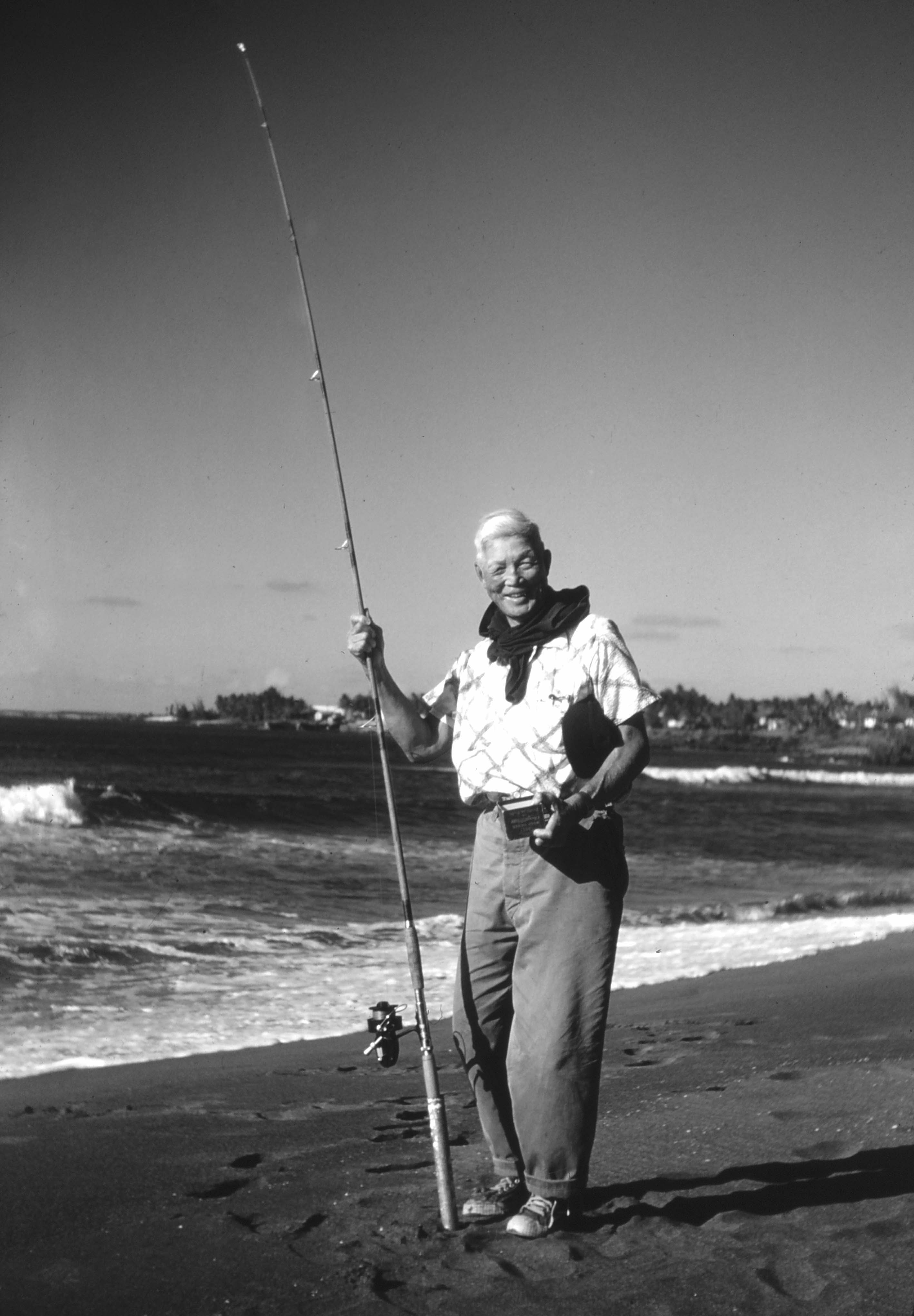 Jack Sing fishing at Kalaupapa, 1955. (Courtesy of Lee Cantwell.)
Jack Sing fishing at Kalaupapa, 1955. (Courtesy of Lee Cantwell.)
Three years later after being called as branch president, Jack Sing told Hawaii Mission President D. Arthur Haycock of a young non-LDS patient who declined receiving more pay for cleaning the LDS Kalaupapa church grounds when Jack offered higher wages. President Haycock was so impressed that he wrote a letter to Apostle Harold B. Lee about the incident, which captures the integrity of the youthful yard worker and how this young man felt about working on the sacred Church grounds, although he himself was not a Latter-day Saint:
June 1, 1955
Dear Brother Lee: For some time now a non-member patient at the Kalaupapa Leper Settlement has been caring for the grounds surrounding our chapel, hall, and mission home at Kalaupapa. Unfortunately, our members there are either too old or so afflicted with the disease that they are unable to keep the grounds up themselves. For this reason we have been paying our non-member friend a small monthly allowance of $6.00 for his labors. In fact, it has been so small that I have wondered if it was fair to the man. As you will remember, the grounds are beautifully kept with the lawn, flowers, and trees always well trimmed and watered. As a result the grounds are indeed a show place. In view of these facts I felt that it would only be fair to increase the allowance to this man by a few dollars. Accordingly, on my recent trip to Kalaupapa in company with Elder John Longden, I talked to the Branch President and he said that he was sure an increase from $6.00 to $10.00 would be appreciated by the caretaker. The increase was sent this last month, and in this connection I thought you would be interested in reading a letter received from Jack Sing, the Branch President. It reads as follows:
Kalaupapa, T. [Territory] H. [Hawaii]
May 18, 1955
Dear President Haycock:
Reference to the yardman money, the boy refused to accept a raise, he says he is satisfied to work for the Lord’s Church Yard for the $6.00 and he further states that he will pay tithing on it, about half of the money. So from now on please do not send $10.00, please send only $6.00. Next payment you can send me $2.00 to fill up the $4.00 I have here from the balance of the $10.00 check.
With kindest personal regards to you and family.
Very sincerely yours,
O/
Kalaupapa Branch President
I felt this note and the expression of the yardman breathes a wonderful spirit and I wanted to share it with you. The yardman may be afflicted with the terrible disease of leprosy, but he has a true sense of values and has learned some great lessons in life which many in this world have failed to learn. We are of course, laboring with him in an effort to bring him to a knowledge of the Restored Gospel. . . . Sincerely yours, D. Arthur Haycock Mission President.[116]
Like Jack, his wife Mary was an active part of the settlement and the Kalaupapa Mormon congregation during the mid-twentieth century. Mary served as the president of the LDS organization for women, the Kalaupapa Branch Relief Society. Relief Society minutes during the decade of the 1950s show that week after week and year after year, Mary was intimately involved with her ministry. Throughout these years, the attendance usually ranged from three to seven members, including the following Relief Society presidency officers: Mary Sing, president; Elizabeth Kaulahao, first counselor; and Mary Duarte, second counselor. Others who attended regularly were Louise Ka-ne and Lucy Kaona. These records indicate that Mary, known for her gospel scholarship, was usually the instructor of weekly spiritual lessons, although she also made time in meetings to “bring thread to show the girls how to make waffle rugs.”[117]
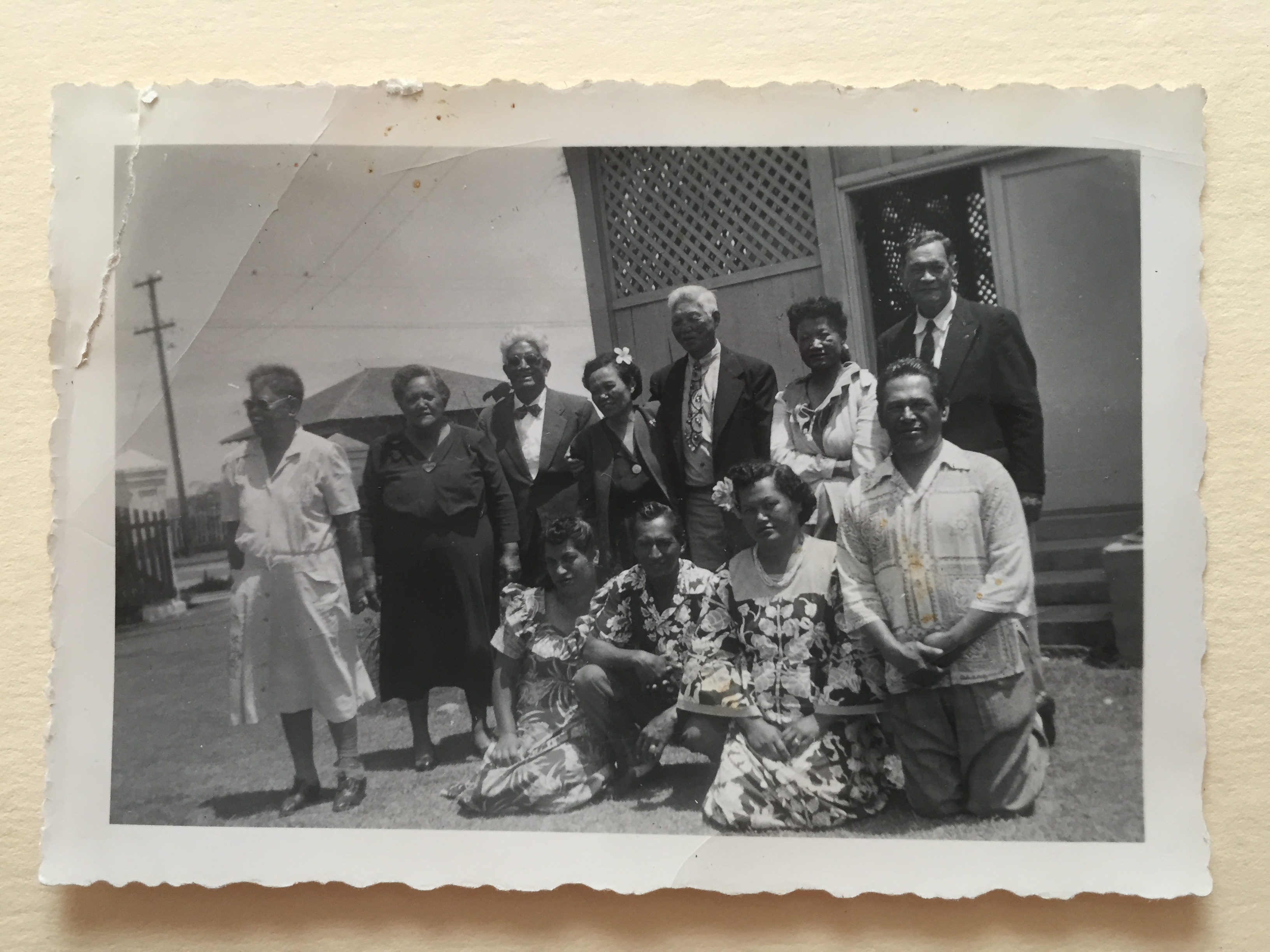 LDS members in front of Kalaupapa Branch Chapel, May 28, 1950. (Written on the back of the photograph is the following notation: “5/
LDS members in front of Kalaupapa Branch Chapel, May 28, 1950. (Written on the back of the photograph is the following notation: “5/
Relief Society meetings were held in the LDS social hall, the chapel, or in a private home.[118] The general pattern was a prayer meeting first, followed ten or fifteen minutes later by a general meeting referred to as a “regular assembly,” which lasted about an hour to an hour and a half. The grand event each year was the anniversary of the Relief Society’s establishment, usually held on March 17.[119] Minutes from various years of these celebrations mention there were visitors attending from topside Moloka‘i. These Church members came from the Maunaloa Branch and especially the Ho‘olehua Branch, which had ecclesiastical jurisdiction over the settlement, Mary Lee being the Relief Society District President.[120]
During one celebration in 1951, these Relief Society sisters from topside Moloka‘i came down to the settlement to join their LDS sisters in an anniversary event titled “We the Presidents,” in which select sisters played the parts of former Relief Society presidents. Minutes note the names of former Relief Society general presidents and who represented them:
Emma Smith Helen Makaiur
Eliza R. Snow Pearl Arruda
Zina Young Elizabeth Pelekai
Emmeline B. Wells Louise Hanakeawe
Louise Robison Lily Quintos
Amy Brown Lyman Mary Sing[121]
Following this successful event, President Mary Sing noted just two weeks later, “Testimonies of the members[,] their faith is still moving slowely [sic] in the work of the R. S.”[122] With summer coming on, vacation was announced and Relief Society meetings were postponed until October.[123] Meetings were also postponed for several weeks during the December holidays of the following year.[124] Minutes indicate these sisters did not only study religious topics in their meetings, but also literature from general Relief Society manuals such as Shakespeare or Robert Louis Stevenson, the latter of which actually visited the settlement in the late nineteenth century.[125]
The Kalaupapa Relief Society was also active in visiting other sisters in the settlement,[126] as well as reaching out beyond their borders. For example, in 1957 the local sisters decided to send relief money to Church members in Kaua‘i and Honolulu who had experienced some degree of destruction by a tidal wave.[127] Months later, Sister Sing also asked if the sisters would consider donating money to those who had been struck by tornadoes on the mainland, to which the Relief Society was once again readily willing to give.[128]
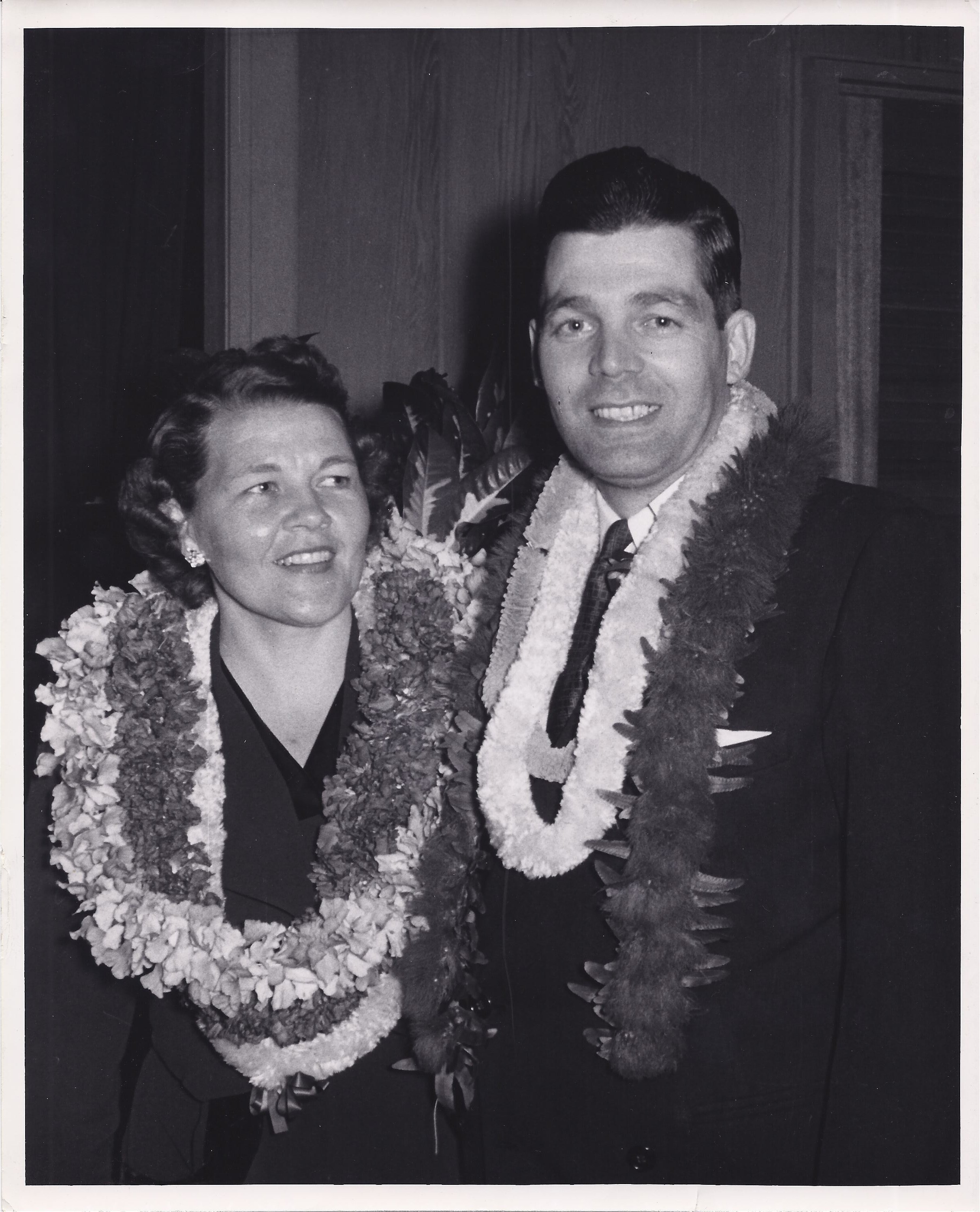 D. Arthur and Maurine Haycock, ca. 1955. (Courtesy of Brett D. Dowdle.)
D. Arthur and Maurine Haycock, ca. 1955. (Courtesy of Brett D. Dowdle.)
At the annual celebration of the Relief Society organization in 1957, Mary Sing recounted the history of how the Relief Society was first organized at Kalaupapa.[129] At a special Relief Society meeting held just three weeks later, on April 6, 1957 Mary again spoke on the early organization. During this meeting, the society was no doubt enthusiastic over the visit of Sister Maurine Haycock, the wife of Hawaiian Mission President, D. Arthur Haycock, who supervised all of the relief societies in the mission. She piqued their interest when she asked if the LDS sisters at Kalaupapa would like to have a portable electric sewing machine.[130] Such occasions continued to knit the Relief Society sisters even closer together. The following month, the weekly minutes note, “A suggestion is made if anyone wishes to become president. . . . No one care to take sis. Sing place. All like her to stay on,”[131] and on she stayed.
On April 30, 1958, the Kalaupapa Saints were privileged to assist with the showing of Cecil B. Demille’s magnificent movie The Ten Commandments at Paschoal Hall. President D. Arthur Haycock, who assisted in obtaining access to the film, suggested to Jack Sing that when the four-hour film was shown, “I think it would be a nice thing for you and the members of the Branch to serve cold drinks during the intermission. You could do it on a little good will gesture from the Kalaupapa Branch members.”[132] In writing to thank Mr. DeMille for the privilege of showing the film in the settlement, Haycock reported,
The viewing of this magnificent film was a great blessing to the good people of the Leper Settlement. The largest crowd ever attending a social function was present at the showing of the picture and all were united in their expressions of gratitude and appreciation to you for making this possible. If you could have seen how much these poor, afflicted people enjoyed the picture I know you would have felt repaid a hundred fold for you kindness to them.[133]
LDS Leadership at Kalaupapa during the 1960s
The LDS Kalaupapa Branch at the end of the 1950s numbered just over two dozen members.[134] The branch continued to decline, numbering twenty-three members in 1960 with an average attendance at Church meetings of about only a dozen or less in the early 1960s.[135] The minutes of a district conference held in 1960 at Kalaupapa list the Church officers at this time:
Jack Sing Kong—Branch President
William Malo—First Counselor in branch presidency
Reuben Nakoa—Second Counselor in branch presidency
Jack Sing Kong—Secretary and Treasurer
(Sunday School)
William Malo—Superintendent
Reuben Nakoa—First Counselor
Lucy Kaona—Secretary
Rachel Kahihikolo—Assistant Secretary
(M.I.A. Board)
Reuben Nakoa—Superintendent
Benjamin Kahikina—First Counselor
Rachel Kahihikolo—President [of the Young Women]
Helen Kahikina—Secretary & Treasurer
Lucy Kaona—First Counselor
(Relief Society Board)
Mary Sing Kong—Relief Society President
Elizabeth Kaulahao—First Counselor
Mary Sing Kong—Treasurer
Kuulei Nakoa [Bell]—Historical Secretary[136]
One memorable visit for the Latter-day Saints occurred several years later, when a special meeting was held on July 1, 1964, at the LDS chapel in Kalaupapa. On this occasion, Mormon Apostle Gordon B. Hinckley and his wife, Marjorie, visited the settlement to inspire the local congregation. Among other things, Elder Hinckley brought aloha greetings from the ninety-three-year-old Church President, David O. McKay. Elder Hinckley also encouraged local members by saying, “No one can take the restoration of the gospel away from you,” and he counseled them to be strengthened through reading the Book of Mormon.[137]
New LDS Chapel
Early this same year, the decision had been made to build a much-needed new LDS chapel in the settlement. Although the Saints had taken good care of their place of worship, a new building was necessary after sixty years of use and the natural aging of the structure. The old chapel was like all wooden buildings on the Hawaiian Islands, eventually succumbing to the deterioration caused by tenacious termites and sea air.
The wife of LDS building supervisor George C. [Claude] Terry wrote, “The appropriation was made, the plans drawn, the material ordered, the mill and shop work done and Brother Terry assigned to supervise the project, but the government red tape slowed things down. However, the extra year gave branch members additional time to raise money needed to take care of the building expenses.”[138]
Church records from a Kalaupapa Branch conference held in early May 1965 cite nine Church members and five district officers visiting on this occasion. Ernest Elia of the Ho‘olehua Branch (topside Moloka‘i), then serving as the Moloka‘i District President, which held jurisdiction over the Kalaupapa Branch, sustained these Church officers, as noted in minutes recorded by LDS Kalaupapa historical secretary, Ku‘ulei Bell:
Jack Sing Kong Branch President
William Malo First Counselor in branch presidency
Mary Sing Kong Relief Society President
Mary Duarte First Counselor in the Relief Society presidency
Rachel Nakoa Second Counselor and secretary in the Relief Society presidency
William Malo Superintendent of Sunday School
Lucy Kaona Secretary and Treasurer of Sunday School[139]
This same month, the old chapel was demolished and groundbreaking for the new structure took place on May 29, 1965.[140] Church records note that the previous week, three LDS labor missionaries had already arrived in the settlement to commence work on the new building.[141] At the groundbreaking ceremony, several people addressed the congregation: Jack Sing, branch president; Abraham Kaili, a church builder; George C. Terry, building supervisor; Joseph E. Wilson, supervisor of LDS Church buildings in the Islands; George William Poulsen Jr. and his wife Orlene, who were then presiding over the LDS Hawaii Mission; and Mr. Edward Burlem, government administrator for the Kalaupapa settlement.[142]
Construction on the new LDS chapel was not only important to local Church members; the general community also valued this project and were willing to assist their Mormon friends in tackling the workload. In fact, when the building was completed by early fall and the work hours were tallied, the people discovered that those of other faiths had actually donated more hours in its construction than the Latter-day Saints had. “All worked hard, and some of those with disabilities had their hands wired to the wheelbarrows that they might do their share.”[143]
During this time of collaborative labor, Jessie Terry recalled, “A large group of workers turned out and the building was not only torn down but all cleared away in one week. The members . . . worked very hard, even those with disabilities. Many non-members also me[t] and gave a helping hand.” Concerning these additional community members from varied faiths, Terry added, “Mary Sing, who had by this time served for twenty-two years as the LDS Relief Society president, brought lunch at noon to all the patients who volunteered their service.”[144]
The chapel was dedicated on December 26, 1965, by a Latter-day Saint General Authority, President Marion D. Hanks of the First Council of the Seventy. There were sixty people in attendance. In his remarks, President Hanks relayed the sentiments of love from Church President David O. McKay. Hanks also reminded those assembled that “God [would] consecrate [their] afflictions for [their] gain.”[145] Remembering the dedication decades later as a “tender and touching and unforgettable” experience, Hanks said:
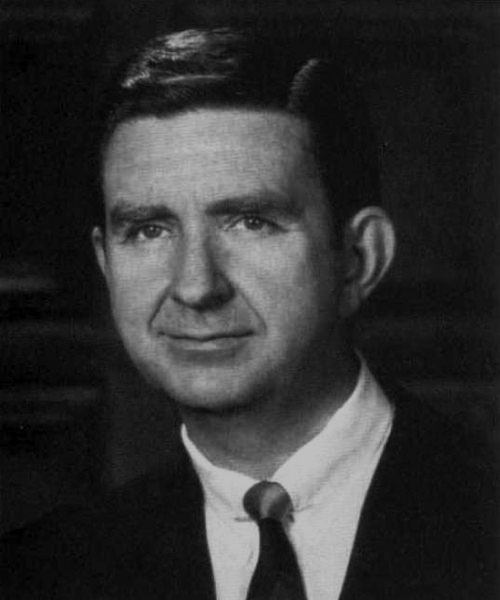 President Marion D. Hanks in 1967. (Courtesy of Richard D. Hanks.)
President Marion D. Hanks in 1967. (Courtesy of Richard D. Hanks.)
A musical number by the branch choir, comprising most of the members of the branch, was a poignant highlight. They came forward haltingly from the congregation, many being helped by others to the front of the small, attractive building. They arranged themselves in choir grouping, some of them literally leaning for support against each other. The sight was one that will linger in memory. Many were blind and many halt and lame. They literally supported each other as they sang hymns of praise and thanksgiving to God. There were a lot of tears at Kalaupapa that day.[146]
Hawaii Mission President George W. Poulsen, who followed Elder Hanks at the dedicatory ceremony, said, “This was a special morning which crowns all the efforts of the members and non-members who had assisted in the construction of the Chapel.” He reminded the audience, “As we lose ourselves in the service of others, we find ourselves,” adding, “We never come to Kalaupapa without going away with a song in our hearts.” Other speakers included Orlene Poulsen, Ernest Elia, Oliver Young of the district presidency, Sister Hanks, and Jack and Mary Sing. The latter two mentioned that their combined years at Kalaupapa spanned nearly a century.[147]
Completing construction on the chapel was a dream come true for the Saints, perhaps especially for Jack and Mary Sing, who had dedicated decades of their lives to leadership positions while presiding over their brothers and sisters. Two weeks later, on January 8, 1966, the entire settlement was invited to a lū‘au in celebration of the occasion. The Sings donated a pig, and two lānais were constructed with attractive poinsettias and palm fronds. Patients and non-patients gathered and all joined in feasting and singing. Catholic sisters, the local Catholic priest, and a Protestant minister were all in attendance. The community rejoiced together in celebrating their LDS friends’ new chapel.[148]
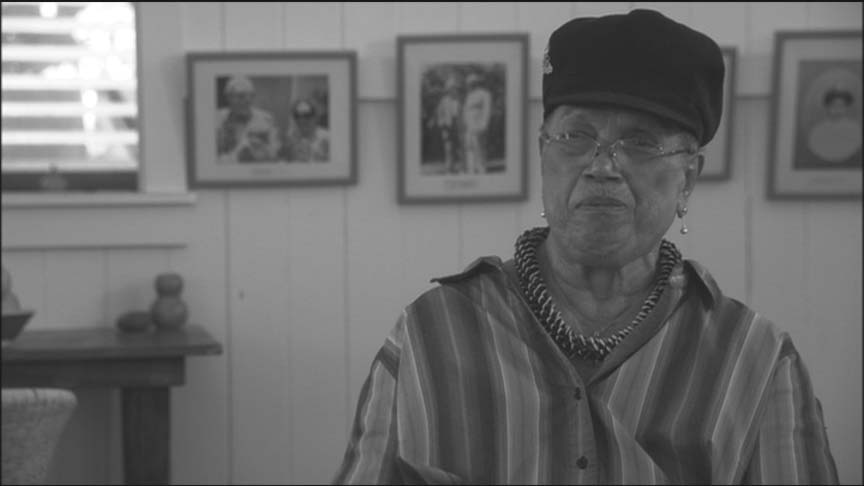 Ku‘ulei Bell inside the LDS Social Hall at Kalaupapa. (Courtesy of Brian Wilcox.)
Ku‘ulei Bell inside the LDS Social Hall at Kalaupapa. (Courtesy of Brian Wilcox.)
Latter-day Saint Ku‘ulei Bell captured the spirit of ecumenism prevalent in this unique community: “All the churches here in Kalaupapa always help one another, it does not matter what religion they are: Protestant, the Catholic, and the Mormons. If we needed help at one time to repair, fix our church, everybody came. And it’s the same thing, if everybody needs help in the different church, we’ll help them. . . . It’s just giving service to anybody, it doesn’t matter who.”[149]
Notes
[1] . Greene, Exile in Paradise, 527‒28.
[2] . “1946 Aleutian Tsunami,” USC Tsunami Research Group, http://
[3] . Greene, Exile in Paradise, 526.
[4] . Danny Hashimoto, interview by Fred E. Woods, February 9, 2015, Kalaupapa.
[5] . . Nālā‘ielua and Bowman, No Footprints in the Sand, 53‒54.
[6] . Olivia Sessions Waddoups, journal, April 1, 1946, William M. Waddoups Papers, MS 15040, Church History Library. In an interview conducted with former Kalaupapa patient Nancy Talino on March 1, 2015 at Hale Mōhalu, Nancy recalled that on that eventful day, William had been pinned to the wall by the tidal wave. However, it was in fact Olivia who had been thrown into a rock wall, while Will had been bruised by the water that banged his car door against him.
[7] . Olivia Sessions Waddoups, journal, April 1, 1946, William M. Waddoups Papers. When Olivia noted the damage to the cemetery, it appears that she meant the Kalaupapa cemetery in general and not the LDS section. This observation is based on a journal entry which states, “Bro. [Jack] Sing told the story of the cemetary there when the tidal wave hit and destroyed graves on both sides, but not ours [LDS section].” This entry is followed by a drawing with the Catholic section of the cemetery on the left, the LDS in the middle and the Protestant on the right, with the following words attached: “Catholic destroyed, L.D.S. safe, Protestant destroyed.” See J. Collin Allan, journal, January 31, 1955, copy of entry in possession of author.
[8] . Two months before the Waddoupses left Kalaupapa, Jessie Elliot, a former LDS secretary of William, visited Will and Olivia at the settlement. She described Kalaupapa as a “little village . . . the epitome of peace and calmness and restfulness.” Jesse also noted, “The supt’s [Waddoups] home is surrounded with beautiful shrubs, plants and flowers of all kinds . . . and they have a wonderful vegetable garden with just everything growing.” Jessie Elliot, letter, April 6, 1947, Kalaupapa/
[9] . “Personal History of William Mark Waddoups,” courtesy of Sarah E. Hale, a great-granddaughter of Waddoups (email sent January 2, 2016). William M. Waddoups noted in his journal, “The latter part of November 1943 I was offered the position of Superintendent of Kalaupapa Leper Settlement. After due consideration, and consultation with my family and close friends we decided to accept the position. My duties to begin December 1st. We left Honolulu by plane November 30th. We reached Kalaupapa the same afternoon we were received an introduced by Harry A. Kluegel, Superintendent Board of Hospitals and Settlement, and now begins a new and very different chapter in our lives.” See William M. Waddoups, journal, 1939–1943, late November 1943, William Waddoups Journals, MSS 8421, L. Tom Perry Special Collections, Harold B. Lee Library, Brigham Young University, Provo, UT.
[10] . William Waddoups, journal, January 1, 1944, William Waddoups Journals, MSS 8421, L. Tom Perry Special Collections.
[11] . William Waddoups, journal, February 15, 1945, William Waddoups Journals, MSS 8421, L. Tom Perry Special Collections.
[12] . William Waddoups, journal, February 15, 1945, William Waddoups Journals, MSS 8421, L. Tom Perry Special Collections.
[13] . William Waddoups, journal, January–March 1946, William Waddoups Papers, MS 15040, Church History Library.
[14] . Sacrament meeting minutes for the dates of July 30, August 6, August 20, September 3, September 17, October 1, November 5, November 19, and December 3, 1944, Kalaupapa Branch, Hawaii Mission, General Minutes, LR 4289 11, vol. 3s, Church History Library.
[15] Olivia Sessions Waddoups, journal, April 21, 1946, William Waddoups Papers, MS 15040, Church History Library.
[16] Olivia Sessions Waddoups, journal, May 12, 1946, William Waddoups Papers, MS 15040, Church History Library.
[17] . William M. Waddoups, journal excerpts, January–February 1944, William M. Waddoups Papers, MS 15040, Church History Library. During these same months, genealogical meeting minutes for the date of January 24, 1944, and January 30, 1944, show that William Waddoups was in attendance, and on February 27, 1944, both William and Olivia Waddoups are listed as being present at the meeting. See Kalaupapa Branch miscellaneous minutes, 1928–1944, Kalaupapa Branch, Hawaii Mission, LR 4289 19, Church History Library.
[18] . William M. Waddoups, journal, December 10, 1944, William Waddoups Journals, MSS 8421, L. Tom Perry Special Collections.
[19] . This reveals that William was on close terms with the LDS Church President, George Albert Smith, as well as Joseph Fielding Smith, then serving in the LDS Quorum of the Twelve Apostles.
[20] . Harold B. Lee was then a member of the LDS Quorum of the Twelve Apostles and Castle H. Murphy was serving at this time as the LDS mission president in Hawai‘i.
[21] . Pioneer Day is an annual holiday celebrated in Utah each July 24, which (as noted above) is the day Brigham Young led a vanguard company of Latter-day Saints into the Salt Lake Valley.
[22] . William Waddoups, journal, September 16, 1945, William Waddoups Journals, MSS 8421, L. Tom Perry Special Collections.
[23] . The missionaries attending the meeting were Elder and Sister Johnson, who were then serving on the island of Moloka‘i. See William Waddoups, journal, November 10–11, 1945. The various excerpts noted above are taken from William Waddoups, journal, January–December 1945, William Waddoups Journals, MSS 8421, L. Tom Perry Special Collections.
[24] . Kalaupapa Branch 1945 Annual Report, Kalaupapa/
[25] . Olivia Sessions Waddoups, journal, July 28, 1946, William M. Waddoups Papers, MS 15040, Church History Library.
[26] . Olivia Sessions Waddoups, journal, March 20, 1946, William M. Waddoups Papers, MS 15040, Church History Library.
[27] . William Waddoups, journal, December 24, 1945, William Waddoups Journals, MSS 8421, L. Tom Perry Special Collections.
[28] . William Waddoups monthly report to the board of health, December 1945, 3, in “Records relating to Hansen’s Disease, Monthly Statistical & Narrative reports by the Superintendent of Kalaupapa Sept. 1944–July 1947,” Series 260, Hawai‘i State Archives. There is also evidence of dozens of instruments at Kalaupapa during the Judd era as well as several which were to be ordered. See “List of instruments in Kalaupapa Recreation,” June 2, 1948, box 15, folder 221, Lawrence M. Judd Collection, series M-420, Hawai‘i State Archives.
[29] . Jessie Elliot, letter, April 6, 1947, Kalaupapa/
[30] . Nancy Talino, interview by Fred E. Woods, January 9, 2009, Hale Mōhalu, HI.
[31] . Olivia Sessions Waddoups, journal, May 26, 1946, William M. Waddoups Papers, MS 15040, Church History Library.
[32] . William Waddoups, journal, January 7, 9, 16, 28; February 4, 11; March 14, 24, 1945. Note that the Waddoupses often met with their LDS friends Robert and Beverly Worley to discuss gospel readings or to enjoy a game of Rook. Robert was a non-patient employee at the settlement. William noted on April 27, 1945, that Worley was to be inducted into the US Army on May 21, 1945. Journal entries indicate that the Waddoupses usually attended a movie each week at the Paschoal Social Hall. In a journal entry dated January 31, 1945, William noted, “Olivia and I usually go to some part of the beach for a rest and change, after work, each day.” In another entry on March 27, William wrote, “After dinner, Olivia and I spent an hour on the beach. This is about our only diversion away from our home.” Many journal entries attest to these various activities throughout the year 1945. See William Waddoups Journals, 1945, MSS 8421, L. Tom Perry Special Collections.
[33] . William Waddoups, journal, January 23, 1945, William Waddoups Journals, MSS 8421, L. Tom Perry Special Collections. This fast was conducted on a Tuesday rather than on the regular LDS fast scheduled the first Sunday of each month, which reveals an additional effort to draw strength.
[34] . William Waddoups, journal, February 19, 1945, William Waddoups Journals, MSS 8421, L. Tom Perry Special Collections. At this time, the Waddoupses had grandchildren as well as two grown daughters (Miriam and Mary) living in Honolulu.
[35] . William Waddoups, journal, September 18, 1945, William Waddoups Journals, MSS 8421, L. Tom Perry Special Collections.
[36] . Although William retired, evidence shows that he was still involved with providing information about the LDS Kalaupapa congregation to Hawaii Mission President E. Wesley Smith. President Smith wrote to Elder Jack L. Halvorsen on January 21, 1948, stating, “Recently I received some information concerning Kalaupapa and the membership there that I appreciate and value, this information received from President Wm. M. Waddoups who was for five years superintendent of the leper colony. I wrote to him in regard to the Church members and qualifications of each one.” President E. Wesley Smith to Jack L. Halvorsen, January 21, 1948, Hawaii Mission President’s Records, LR 3695 21, reel 1, box 1, folder 4, Church History Library.
[37] . William Waddoups, monthly report to the board of health, May 1947, “Records relating to Hansen’s Disease. Monthly Statistical & Narrative reports by the Superintendent of Kalaupapa Sept. 1944‒July 1947,” Series 260, Hawai‘i State Archives. Two years after Waddoups was released as the Kalaupapa superintendent, he sent a letter to Elder David Hannemann, a former missionary at Kalaupapa. Waddoups wrote, “Please give our alohanui to our dear friends there. We can never forget them and the association which we had with them. Those are precious memories we cherish.” See William Waddoups to Elder David Hannemann, April 28, 1949. The letter is in possession of the author, who thanks David Hannemann for granting him a copy of this document. Evidence shows that the medical staff was also devoted to the patients during the Judd era, which followed Waddoups’s tenure. For example, a note which Dr. Druecker wrote to Nancy Talino, framed and hung on her wall at Hale Mōhalu, reads, “To The Patient Patient: During 1949 and 1950 we had many laughs and tears but it is always the same story that life isn’t worth while unless its worth fighting for. I am certain that from now on you [will] continue on the happy road to good health and enjoyment of life. From Dr. (Shorty) Druecker who saw God perform a miracle.” The author thanks Nancy Talino for providing him with a copy of this note now in the author’s possession.
[38] Mary Lou Bingham, interview by Fred E. Woods, July 22, 2016, Bingham home, Provo, UT.
[39] . Jack and Mary Sing, interview by Ishmael Stagner and Kenneth W. Baldridge, February 24, 1979, Typescript, 6, Joseph F. Smith Library Archives and Special Collections.
[40] . Olivia Sessions Waddoups, journal, March 27, 1947, MS 15040, William M. Waddoups Papers, Church History Library. Olivia also wrote on this same date, “We have appreciated the fact that three Apostles have visited us here since we came to Kalaupapa. Apostles Lee, Kimball & Cowley, also Sisters Kimball & Cowley.” The LDS Apostles she is referring to are Elder Harold B. Lee and Elder Spencer W. Kimball. Sister Cowley accompanied her husband, Elder Cowley, and Sister Camilla Eyring Kimball accompanied her husband, Elder Kimball. The author thanks Ardis Smith, Church History Library archivist, for finding this reference and sharing it with him via email. In his official superintendent’s monthly report for March 1947, William Waddoups wrote, “Matthew Cowley official of Mormon Church and party [of] three visited.” Records relating to Hansen’s Disease, Monthly Statistical & Narrative Reports by the Superintendent of Kalaupapa, September 1944–July 1947, Series 260, Hawai‘i State Archives. Olivia Sessions Waddoups, journal, July 24, 1946. This journal notes that Elder Spencer W. Kimball, Sister Camilla Kimball, and Sister Cowley visited the settlement nine months before Elder Cowley came. Elder Cowley was sick at the time and therefore could not come on the earlier visit. Concerning this visit, Olivia also noted the LDS patients were “truly grateful for the visit and blessing of Apostle Kimball last Wednesday.” See Olivia Sessions Waddoups, journal, July 28, 1946.
[41] . Elder Matthew Cowley, “Tongan Mission History,” June 22, 1947, Church History Library. These remarks were made by Cowley during the first session of the Tongan Mission conference held in the Matavaimoui chapel in Nuku‘alofa, Tongatapu, Tonga. The author expresses appreciation to his friend and colleague Riley Moffat for bringing this document to his attention and transcribing it.
[42] . Henry A. Smith, Matthew Cowley: Man of Faith (Salt Lake City: Bookcraft, 1954), 300‒1. William Waddoups later gave a copy of this letter to D. Arthur Haycock, who served as the president of the Hawaii Mission from 1954 to 1958. The author expresses gratitude to Lynette H. Dowdle, daughter of D. Arthur Haycock, and Brett D. Dowdle, grandson of D. Arthur Haycock, for providing the author with a copy of this letter, which the author has in his possession. Upon returning to Salt Lake City after his visit to Kalaupapa, Elder Cowley also referred to this sacred experience in a general conference talk on April 4, 1947. Among other things in his conference address, he said, “A week ago yesterday I was in a little settlement known as Kalaupapa on the island of Molokai in the Hawaiian group. That is a leper settlement. I flew over there to spend an afternoon with those people. I went expecting and apprehending that I had been exalted. I attended a service with those people. I heard a chorus sing our beautiful anthem, conducted by an aged man, blinded by the dreaded disease. I heard them sing, ‘We Thank Thee O God, for a Prophet,’ and as long as I live, that song will never ring in my soul with such beautiful harmony as came from the hearts and the voices of those emaciated lepers of that colony.” See Matthew Cowley, Matthew Cowley Speaks: Discourses of Elder Matthew Cowley of the Quorum of the Twelve of The Church of Jesus Christ of Latter-day Saints (Salt Lake City: Deseret Book, 1954), 45. Apparently, Elder Matthew Cowley made another trip to Kalaupapa two years later as ascertained from this letter written by LDS Hawaii Mission President E. Wesley Smith to Elder Glen H. Christensen, stationed at Ho‘olehua on topside Moloka`i, dated February 23, 1949, stating, “My Dear Brother, . . . I think it best that the Elder laboring on topside of Molokai refrain from going down to Kalaupapa for our meeting on Thursday. You Elders will all have an opportunity to meet President Cowley personally in our testimony meeting and also in the general meeting on Wednesday evening. I received a letter from Mr. Judd informing us that the accommodations at Kalaupapa at that particular time would be crowded and therefore, President Cowley, Wenning and I will have to remain in the little home [at Kalaupapa] where the Elders are. . . . Sincerely yours, E. Wesley Smith.” Hawaii Mission President’s Records, LR 3695 21, reel 1, box 1, folder 6, Church History Library.
[43] . Lawrence M. Judd, Lawrence M. Judd & Hawaii: An Autobiography (Rutland, VT, and Tokyo, Japan: Charles E. Tuttle Company, 1971), 23‒28.
[44] . Judd, Judd & Hawaii, 130‒34, 141, 175.
[45] . H. A. Kluegel to Harold W. Ross, April 16, 1947, series M-420, box 15, folder 207, “Kalaupapa. Employment. L. Judd,” Lawrence M. Judd Collection, Hawai‘i State Archives.
[46] . “From an address by Lawrence M. Judd to the patients of the Kalaupapa Settlement, Molokai, June 1947, Kalaupapa. Resident’s Welfare. Miscellaneous,” box 16, folder 231, series M-420, Lawrence M. Judd Collection, Hawai‘i State Archives.
[47] . Judd, Judd & Hawaii, 247–48. Danny Hashimoto, in an interview with Fred E. Woods on April 13, 2015, noted, “In the beginning they liked him [Lawrence M. Judd] because he cleaned up the settlement quite good. Like he got rid of a lot of trash around the housing to clean up the area.”
[48] . Judd, Judd & Hawaii, 251–52. Danny Hashimoto, in the same interview as cited in the previous note, also recalled that Eva Marie Judd “started a craft shop,” and “after that patients took over . . . when she left . . . some people did quite good.”
[49] . Judd, Judd & Hawaii, 251–52.
[50] . “Talk by Lawrence M. Judd, Resident Superintendent, Kalaupapa Settlement . . . Charter Day Meeting of the Kalaupapa Lions Club,” April 24, 1948, 1‒2, Kalaupapa Lions Club, box 15, folder 215, Lawrence M. Judd Collection, series M-420, Hawai‘i State Archives. In a speech prepared to be delivered a year later for the Lions International annual meeting on June 18, 1949, Judd mentioned that 130 Lions and their wives were in attendance at the inaugural 1948 Lions Club meeting. Further, International Lions Club President Briggs and his wife had been in attendance. Briggs inspired the Kalaupapa Lions to renew their determination “to be good and useful citizens.” At the second annual meeting, 166 visiting Lions and their wives joined the Kalaupapa Lions in another inspiring gathering. In addition, Judd expressed his feelings that club activities provided “joy and self-satisfaction in performing devoted and unselfish service to the community.” See Lawrence Judd, “A New Approach is Needed to the Hansen’s Disease Problem in Hawaii,” prepared for delivery to the “Convention 50 Lions International,” June 18, 1949, 4, Kalaupapa Lions Club, box 15, folder 215, Lawrence M. Judd Collection, series M-420, Hawai‘i State Archives. Two years later, Edward Kato, secretary of the Lions Club, wrote two letters to Judd thanking him for securing the Lions charter, donating generously, giving devoted support, and providing enlightened leadership. See Edward Kato to Mr. Lawrence M. Judd, October 26 and October 31, 1951, Kalaupapa Lions Club, box 15, folder 215, Lawrence M. Judd Collection, series M-420, Hawai‘i State Archives.
[51] . Anwei Skinsnes Law, Kalaupapa: A Collective Memory (Honolulu: University of Hawai‘i Press, 2012), 467‒68. Regarding the Lions Club parties, Ku‘ulei Bell recalled that those who drew a “lucky number” were given a present by LDS Church leader Jack Sing Kong, who served as club president and designated gift giver. Jack was a very active member of the Lions Club for decades. See Ku‘ulei Bell, interview with Fred E. Woods, July 30, 2006, Kalaupapa. See also Lawrence Judd to Jack Sing, November 15, 1951, Kalaupapa Lions Club, box 15, folder 215, Lawrence M. Judd Collection, series M-420, Hawai‘i State Archives.
[52] . Alice L. Kahokuoluna to Superintendent Lawrence M. Judd, May 24, 1948, Kalaupapa Resident Superintendent Report, April–June 1948, series M-420, box 16, folder 229, Lawrence M. Judd Collection, Hawai‘i State Archives.
[53] . Lawrence M. Judd, “Kalaupapa Field Day,” and “Kalaupapa Field Day results and prizes,” July 4, 1947, in “Records Relating to Hansen’s Disease,” Monthly Statistical & Narrative Reports by the Superintendent of Kalaupapa, September 1944‒July 1947, Series 260, Hawai‘i State Archives.
[54] . Maud B. Thompson, “Impressions of Kalaupapa,” April 12, 1948, 3, Kalaupapa, History & Description, box 15, folder 211, Lawrence M. Judd Collection, series M-420, Hawai‘i State Archives. Further, “Kalaupapa in Brief,” April 23, 1948, Kalaupapa History & Description, series M-420, box 15, folder 211, Lawrence M. Judd Collection, Hawai‘i State Archives. This document, written during Judd’s administration, provides this concise description of improved conditions in the settlement: “Today the settlement presents a marked contrast to the early days. All necessities are provided by the territorial government, including food, housing, clothing, recreation and medical care. Patients are quartered in four ‘Unit Homes,’ with central dining room, or in cottages elsewhere, in which case they receive an allowance for food. Utilities include electricity and water, school, store, gas station, laundry, and shops for maintenance and repair. Work has been begun on programs of occupational therapy and adult education. Commercial motion pictures are shown twice a week, and educational films on Sundays. Dances and other entertainments are held frequently. The three churches, Protestant, Catholic, and Mormon, all now have resident clergy.”
[55] . “Constitution and Bylaws of Young Men’s Social and Educational Club; for the Young Men of Kalaupapa, Molokai,” Lawrence M. Judd Collection, series M-420, box 15, folder 226, “Kalaupapa Res. Supt. report. June–September 1947,” Hawai‘i State Archives; Edward Macks, “Minutes of our meeting,” Sep. 9, 1947.
[56] “Girls Club of Kalaupapa,” Lawrence M. Judd Collection, series, M-420, box 15, folder 226, “Kalaupapa Res. Supt. report. June-September 1947,” Hawai‘i State Archives.
[57] . “[Girls Social Club] Minutes—Sept. 5, 1947,” Lawrence M. Judd Collection, series M-420, box 15, folder 226, “Kalaupapa Res. Supt. report. June–September 1947,” Hawai‘i State Archives.
[58] . “Young People’s Social and Educational Club,” Sep. 24, 1947, Lawrence M. Judd Collection, series M-420, box 15, folder 226, “Kalaupapa. Res. Supt. report. June–September 1947,” Hawai‘i State Archives.
[59] . Edward Marks, memo, Sep. 2, 1947, Lawrence M. Judd Collection, series M-420, box 15, folder 226, “Kalaupapa Res. Supt. report. June–September 1947,” Hawai‘i State Archives.
[60] . Judd, Judd & Hawaii, 22.
[61] . Elroy “Makia” Malo, interview by Ethan Vincent, assisted by Fred E. Woods, August 3, 2008; Tayman, The Colony, 262.
[62] . Jessie Elliot, letter, April 6, 1947, Kalaupapa/
[63] . “Kalaupapa Picture Schedule,” Kalaupapa Recreation, box 15, folder 221, Lawrence M. Judd Collection, series M-420, Hawai‘i State Archives. During this era, David Kupele brought films and the mail up and down the pali several times a day or week for the patients to enjoy. The journey took him between an hour and an hour and a half, and he charged $3.00 for each trip. David came to Kalaupapa in 1914 at the age of seventeen and attended Mormon services for many years, but he was not baptized into the LDS Church until 1968. See Law, Kalaupapa, 358; David Kupele, interview by Ishmael Stagner, February 24, 1979, 1‒2, 5‒6, 10, Joseph F. Smith Library Archives and Special Collections.
[64] . Lawrence M. Judd, “Kalaupapa Settlement,” January 15, 1949, “Kalaupapa, Misc. reports & evaluation,” series M-420, box 15, folder 225, Lawrence M. Judd Collection, Hawai‘i State Archives.
[65] . Nancy Talino, interview by Fred E. Woods, January 18, 2015, typescript in author’s possession.
[66] . Lawrence M. Judd to “the staff,” July 7, 1947, in “Records relating to Hansen’s Disease, Monthly Statistical & Narrative Reports by the Superintendent of Kalaupapa, September 1944‒July 1947,” Series 260, Hawai‘i State Archives. In his December 1946 superintendent’s report to the Board of Health, Waddoups had voiced two main areas of concern to meet the needs of the Kalaupapa youth: “First, an appropriation to build a new suitable gymnasium and amusement and social center, second, the appointment of properly trained persons to organize and direct the spare time, amusements, athletics, and social activities of our young people here. The moral status of our people here is deplorable, in too many instances. Our young people have little directed and planned amusements and social functions. In the absence of parents and home training, I feel it is imperative that some careful and thoughtful attention be given to the moral and character building of our young people. . . . Along with such a programme, the sale and use of beer and wine can be more properly handled and controlled.” See William Waddoups, December 1946 report to the Board of Health, 3, in “Records relating to Hansen’s Disease, Monthly Statistical & Narrative Reports by the Superintendent of Kalaupapa, September 1944‒July 1947,” Series 260, Hawai‘i State Archives. This report also noted that there were then 329 people in the settlement at the close of 1946.
[67] . Sheriff Mahelona, report to Superintendent Judd, July 31, 1947, regarding monthly police department reports, Kalaupapa Res. Supt. Report, June–September 1947, box 15, folder 226, Lawrence M. Judd Collection, series M-420, Hawai‘i State Archives. A near identical report was issued just the following month, dated August 30, 1947.
[68] . Malo, interview by Anwei Skinsnes Law, February 15, 1988, Tape 4311, Kalaupapa National Park Archives. See also “Hawaii’s Aviation History,” Hawaii Aviation, http://
[69] . Makia Malo, interview by Ethan Vincent, assisted by Fred E. Woods, August 3, 2008, Kalaupapa.
[70] . Judd, Judd & Hawaii, 260.
[71] . Judd, Judd & Hawaii, 262.
[72] . Belknap, Maui News, January 1, 1949.
[73] . Judd, Judd & Hawaii, 265; Stanley Stein, “Hansen’s Disease in Hawai‘i cited,” Times-Picayune [Louisiana], May 11, 1950, cited in “Leprosy. Clippings. Newspaper. 1950,” Lawrence M. Judd Collection, Hawai‘i State Archives.
[74] . Shirley Temple Black to her “Friends of Hale Mōhalu,” July 17, 1951, Lawrence M. Judd Collection, series M-420, box 16, folder 240, Hale Mōhalu Misc., Hawai‘i State Archives.
[75] . Judd, Lawrence M. Judd & Hawaii, 263.
[76] . Elder Jack L. Halvorsen to Lawrence Judd, February 10, 1948. The author expresses thanks to Jack for providing the author with a copy of this letter, which is now in the author’s possession.
[77] . Lawrence Judd to Mr. H. A. Kluegel, February 11, 1948, “Kalaupapa. Religious activities,” box 15, folder 222, Lawrence Judd Collection, series M-420, Hawai‘i State Archives.
[78] . Lawrence M. Judd to Elder Jack D. [L.] Halvorsen, Feb. 16, 1948.
[79] . “Elders that are laboring at Kalaupapa,” LDS record, copy in possession of the author. This record also reveals that the next LDS missionaries to labor at Kalaupapa were Stanley Smith, arriving on June 6, 1948, and departing on December 29, 1948, and Jerry Hayes, arriving on August 8, 1948, and departing March 27, 1949.
[80] . In Timothy Waiamau’s April 1 “Report of Recreational Activities for the month of April 1948” to Superintendent Lawrence M. Judd is the notation, “Boys Scout Meeting. Elder, Jack Halvorsen in charge.” The April 15 notation reads, “Boy Scout business meeting, and induction of new officers for the organization. Scout Master, Kenso Seiki, in charge. Elder Halvorsen, assistant.” Kalaupapa Resident Superintendent Report, April–June 1948, series M-420, box 16, folder 229, Lawrence M. Judd Collection, Hawai‘i State Archives.
[81] . Quoted by John Taylor in Journal of Discourses, 10:57‒58.
[82] . President E. Wesley Smith to Elder Jack L. Halvorsen, Ho‘olehua, Moloka‘i, February 19, 1948. The author expresses gratitude to Jack Halvorsen for providing him with a copy of this letter as well as other important documents and images covering this important transitional period for the history of the LDS Church in Kalaupapa.
[83] . Elder Jack L. Halvorsen to President E. Wesley Smith at LDS mission headquarters in Honolulu, February 23, 1948, copy of letter in possession of the author, courtesy of Jack L. Halvorsen.
[84] . President E. Wesley Smith to Elder Jack L. Halvorsen, March 9, 1948, copy of letter in possession of the author, courtesy of Jack L. Halvorsen.
[85] . President E. Wesley Smith to E. Grant Hayes, August 31, 1948, LR 3695 21, reel 1, box 1, folder 5, Church History Library.
[86] . Elder Jerry Hayes arrived at Kalaupapa on August 8, 1948, and departed on March 27, 1949. Hannemann arrived in Kalaupapa on March 28, 1949, and left on August 17, 1949. “Elders that are laboring at Kalaupapa,” LDS record, copy in possession of author. During this period of time, all missionaries laboring at Kalaupapa, regardless of denomination, were not permitted to proselytize in the community, but could hold cottage meetings at the homes of patients. One statistic sheet noted that while stationed in Moloka‘i in 1949, Elder David Hannemann had thirty-five hours of cottage meetings in one month, which appears to have reference to his time at Kalaupapa. See Hawaii Mission President’s records, LR 3695 21, reel 2, box 3, folder 1, Church History Library. LDS members in the settlement sometimes invited their friends to listen to the Mormon elders, which was permissible. See David Hannemann, interview with Fred E. Woods, August 7, 2006, BYU–Hawaii. In an interview with LDS Church member Peter Keola Jr. on August 6, 1999, interviewer Barbara Nakamura asked Peter if he remembered any of the Mormon missionaries. Peter, who came to Kalaupapa in 1940, responded, “The one I remember really, was Hannemann.” A letter dated around late December 1950 from LDS Church member Lucy Kaona, shows the great impact Elder Hannemann had on Lucy and her husband, Johnny; Johnny loved Elder Hannemann and fondly remembered him after his departure from the settlement. The letter was signed “Love as Ever your brother & sister Kaona,” although Johnny was not a member of the LDS Church. Another heartfelt letter, written by LDS patient Bill Malo to “Dave” Hannemann on March 2, 1951, again shows the love the patients felt for Hannemann after he left Kalaupapa. Not only does Bill let his friend Dave know that he is now serving as the sheriff of the settlement, but he also states tenderly, “Well Dave now that your mission is up and your going back to the mainland I wish you every success in whatever you may undertake to do. . . . Love & stuff Bill.” The author thanks David Hannemann for sharing these letters with him, copies of which are now in possession of the author.
[87] . John L. Jeppson arrived in the settlement on December 30, 1948, and stayed until June 17, 1949. “Elders that are laboring at Kalaupapa,” LDS record, copy in possession of author.
[88] . David Hannemann, interview by Fred E. Woods, August 7, 2006, BYU–Hawaii. Six months after Hannemann left the settlement, correspondence between two physicians associated with Kalaupapa shed light on the practices and regulations set in place for the Mormon missionaries during this era. See also Norman R. Sloan (Kalaupapa resident physician) to Dr. E. K. Chung-Hoon, chief of medical services, Division of Hospitals and Settlement, February 25, 1950. In this letter, Dr. Sloan wrote, “We have two Mormon Elders residing in the settlement; they are changed from time to time, but two are always in residence. When they first came they gave a great deal of assistance to the boys, especially with the scout troop. Now that the younger boys have all been moved to Hale Mōhalu, or released, they are working with the older group, from a social angle, while confining their religious efforts to the members of their own faith.” Sloan also sought counsel on a problem which had arisen in which a few patients had been critical of contact the Mormon elders had made with some patients when playing pool at the McVeigh home. Sloan suggested the following regulations until he heard further from Dr. Chung-Hoon: “a. Do not require them [the Mormon elders] to wear gowns, but recommend that the clothes they wear when in contact with patients be kept for that purpose. b. They are permitted to go to the group homes for recreational activities, but should not enter patients’ quarters, except for carrying out their religious duties. c. They are not to ride [in] patient’s cars, or have patients ride in their car. d. They are not to eat any food which is handled or prepared by the patients. . . . Would you advise me whether the above meet with your approval?” In response to this letter, Dr. Chung-Hoon wrote back to Sloan, March 1, 1950, stating, “This office desires to express appreciation to the Mormon Elders who have rendered valuable assistance to the Medical Director of Kalaupapa Settlement in carrying out social and recreational activities which have a definitive influence on the medical welfare of the patient[s]. . . . the suggestions are compatible with proper medical management.”
[89] . Edwin “Pali” Lelepali, interview by Fred E. Woods, July 29, 2006, Kalaupapa.
[90] . “Missionary Tells of Hospital at Kalaupapa Leper Colony,” Ashton Herald, July 8, 1948, cover page. This is the third segment of a three-part series. See also Ashton Herald, June 24, 1948, cover page, and July 1, 1948, cover page, for the first two segments. This newspaper clipping is also available in Daniel Stewart Hess, Life History of Daniel Stewart Hess and Mary Evelyn Bullock Hess (Rexburg, ID: Ricks College Press, 2000), 296‒98, a copy of both the Life History extract and the newspaper account are in the author’s possession. The author thanks both Brooks Haderlie and Adam Luke for their help in locating this material. They are librarians at BYU–Idaho Special Collections, David O. McKay Library, Rexburg, ID.
[91] . Ethel Damon, Siloama, 90–91. Maud B. Thompson, “Impressions of Kalaupapa,” April 12, 1948, 2, Kalaupapa, History & Description, box 15, folder 211, Lawrence M. Judd Collection, series M-420, Hawai‘i State Archives. This document notes the demographic statistics for 1948: “There are now 280 patients here as well as about 35 parolees and 4 ‘kokuas,’ the latter being the spouses of patients who have been here many years. . . . There are 16 children under 16 here at present. The boys live at Baldwin Home . . . and the girls at Bishop Home.”
[92] . For a complete list of the cast, see “Pilate the Govenor: A Passion Play presented Easter Sunday, April 9, 1950,” NPS/
[93] . “Congregational Church 1943,” Friend 34, no. 1 (February 1, 1943), 70. This article notes that Reverend Kahokuoluna had a congregation of seventy-five members in early 1943. Her full name was Alice Lillian Kaaekuapa Kahokuoluna; her former name was Rosehill. Alice was born on February 20, 1888, in Honolulu and married Peter N. Kahokuoluna April 4, 1912, though they had no children. She became the very first ordained minister in Hawai‘i after her husband died. Tall of stature, Alice ministered at Kalaupapa for eighteen years and died of cancer on March 14, 1957. See also “Alice Lillian Kaaeakuapa (Rosehill) Kahokuoluna (1888–1957),” WikiTree, http://
[94] . Nancy Talino, interview by Fred E. Woods, March 1, 2015, Hale Mōhalu, HI. “Reverend Alice Kahokuoluna ‘Mother Pastor’ at Kalaupapa,” Friend 109, no. 11 (November 1, 1939), 209. This article notes that Reverend Alice’s work “often brings her in contact with members of other churches throughout the island who have been unfortunate in being assigned to the settlement. She spoke of the calls which are needed, having made nearly a thousand during the past year upon people who are in need of pastoral care. During her service in that parish she has been able to reclaim the Siloama Church house and yard from great neglect.” See also Norman C. Schenck, “Easter Services at Kanaana Hou,” Friend 110, no. 4 (April 1, 1940), 73. In this article, Schenck further commented on “the splendid spirit of our own pastor, Rev. Alice Kahokuoluna, who not only serves our own members, but has made herself an influence for good throughout the community and has won the kindly appreciation and confidence of groups both religious and secular who are doing so much for the comfort and happiness of members of the community.” Some patients referred to Reverend Alice Kahokuoluna affectionately as “Mother Pastor.” See “Reverend Alice Kahokuoluna ‘Mother Pastor’ at Kalaupapa,” Friend 109, no. 11 (November 1, 1939), 209.
[95] . Christmas Eve MIA program outline with notes, Kalaupapa Branch, Kalaupapa/
[96] . “Report of Religious Services and other Activities for the year 1957,” Reports on Deacon Participation, Religious Activities, Religious Services, 20776/
[97] . “Christmas Eve Program,” December 24, 1948, Kalaupapa Religious Activities, box 15, folder 222, Lawrence M. Judd Collection, Hawai‘i State Archives.
[98] . For example, in a scrapbook belonging to Rosie Lelepali, a handwritten program reads, “Kalaupapa Xmas Pageant Directed by [a Catholic nun] Sister M. Wilma Cast: Ku‘ulei Bell, Sebastiana Fernandez, Gloria Marks, Helen Keao, Nellie McCarthy, Rosie Lelepali, Fred McCarthy, Isaac Keao, John Arruda, Edward Kato, Howard Chang, Bernard Punikaia, Kalaupapa Hospital Dec. 20, 1975.” The author thanks “Pali” for sharing this scrapbook with the author, which contains priceless information and images.
[99] . “Report of Recreational Activities for the month of December 1948,” Kalaupapa. Res. Supt. Report, July‒December 1948, box 15, folder 220, Series M-420, Lawrence M. Judd Collection, Hawai‘i State Archives.
[100] . Maud B. Thompson, “Impressions of Kalaupapa,” April 12, 1948, 3, Kalaupapa, History & Description, box 15, folder 211, Lawrence M. Judd Collection, Series M-420, Hawai‘i State Archives.
[101] . “Choral Group Documents,” September 1955, cabinets 3 and 4, Kalaupapa National Park Research Center. This document contains Kalaupapa Choral Group bylaws, a constitution, and elected officers for the years 1956‒1957. The author thanks park ranger T. Scott Williams for providing this material, as well as much more information during his research at Kalaupapa.
[102] . Ku‘ulei Bell, “Faith, Hope, and Hansen’s Disease: The Saints of Kalaupapa,” in Voyages of Faith: Explorations in Mormon Pacific History, ed. Grant Underwood, 381. Bell mentioned that LDS Apostles Ezra Taft Benson and Mark E. Peterson visited Kalaupapa. This probably occurred in 1951, when these two Apostles traveled to Honolulu to dedicate the Kalihi Ward chapel. See Sheri L. Dew, Ezra Taft Benson: A Biography (Salt Lake City: Deseret Book, 1987), 249.
[103] . In his journal, Decker wrote, “Wed. June 7, 1950. We went to Kalaupapa and took census all day. There are 12 members there who have joined other churches and they didn’t enjoy having us take there [sic] census. There are a very few members in Kalaupapa that live the word of wisdom (meaning the LDS health code to abstain from alcohol, tobacco, tea and coffee). There was a baseball game in which the Kokua beat the Homes 17-4. Brother [Jack] Sing Kong showed us the movies that he took of us. Thur. June 8, 1950. We finished the census after all morning and going into many homes. . . . Bro. [David] Kupele’s wife is a Catholic but she has belonged to our Relief Society for 22 years.” Daniel L. Decker, journal, June 7–8, 1950, copy of entries in possession of author. Two months earlier, Decker also recorded in his journal that he and his companion had brought “a pack of corn,” probably for the LDS missionaries or LDS members stationed in the settlement. Decker also mentioned that during the trip, he and his companion “took a trip around the peninsula of Kalaupapa visiting the light house, old woman’s cave, Father Damien’s church, etc.” Daniel L. Decker, journal, April 21–22, 1950. A month later, Decker noted, “We made 3 trips up the pali to Kalaupapa this morning. We picked 3 sacks of Pineapples for some of the settlement boys to take down.” Daniel L. Decker, journal, May 20, 1950. See also Daniel Decker, interview by Fred E. Woods, February 7, 2016, Decker home, Provo, UT. In this interview, Decker also mentioned that sometimes he and his companion administered the sacrament when visiting the settlement. He said, “I wasn’t very frightened. I thought that the Lord wanted us to do this, so we just did it. . . . We felt like were doing something worthy, that they [the members] were worthy of this. . . . We did it several times.” Decker also said that on one occasion navy men who were visiting the settlement on an aircraft carrier kindly transported him and his companion by plane to topside Moloka‘i so they did not have to climb the pali. The author expresses appreciation to Daniel L. Decker for permitting this interview, Bonnie Decker (Daniel’s wife) for assistance in finding Kalaupapa entries in his journal as well as photographs, and Zach Decker (Daniel and Bonnie’s grandson and the author’s student at BYU) for taking notes while Daniel was being interviewed and for arranging the oral history interview.
[104] . The last two full-time LDS missionaries to live at Kalaupapa were Robert David Ogilvie, who went by “Dave,” and William B. Peterson. According to Elizabeth Ogilvie, Dave’s wife, David loved to talk about Kalaupapa, and she heard her husband tell audiences on several occasions that he was the last full-time missionary to live in the LDS mission home at Kalaupapa. One LDS Kalaupapa resident confirms that such was the case, and indicates that Ogilvie arrived on March 23, 1950, and left his occupation of full-time residency in the settlement on May 12, 1950. This document further notes that Elder Ogilvie and other missionaries continued to make periodic visits throughout the remainder of the year. Elizabeth said that the reason the elders were no longer living full-time at the settlement was based on a combination of two factors. First, as the disease began to be arrested through medical aid, there were fewer patients in the settlement. Second, she noted that at the time her husband departed as a full-time Kalaupapa resident, there was no longer a guard at the top of the pali, which made it easier for the elders to make regular trips up and down the pali to visit the remaining Saints. Therefore, it was no longer necessary for them to live among the patients in the settlement. Elizabeth Ogilvie, phone interview by Fred E. Woods, February 18, 2016. See also LDS Kalaupapa miscellaneous record showing elders who had served at Kalaupapa, in possession of author. This information was also verified by Raymond A. Jones, who said he made periodic visits to Kalaupapa commencing on June 16, 1950, until his mission concluded in February 1951. Jones, who was one of the missionaries serving on topside Moloka‘i, confirmed that Elder Ogilvie was the last missionary to live at the LDS mission home, but he could not recall the name of his companion at the time. Jones also noted that after Ogilvie left, the LDS missionaries continued to make weekly visits from topside Moloka‘i down to the settlement to administer the sacrament and provide priesthood blessings to Church members in need. Raymond said that his knees were in better shape than some of the other LDS missionaries on topside Moloka‘i, so he made the trip up and down the pali more frequently. He recalled that one of the LDS elders slipped going down the trail and was injured. When the Kalaupapa Saints found out about it, they would not let him hike back up the pali, but instead gave him money to fly out. Jones further noted that these visits were done under the direction of Hawaii Mission President Edward Clissold. Even after more than six decades, Jones could recall the names of Kalaupapa LDS patients, Jack and Mary Sing, and could remember fishing with Jack and the fact that he would allow the missionaries to use his ham radio to call home. Raymond A. Jones, phone interview by Fred E. Woods, February 19, 2016. His journal also mentions fishing with Jack Sing on two occasions and notes that the missionary who fell and hurt himself climbing down the pali was Elder [Theodore Ross] Miller, who was then the district president on Moloka‘i. Further, Jones noted in his journal that during his visits to Kalaupapa, he worked to clean up the LDS Church yard, taught Sunday School, made contact with Dr. Druecker about the local scouts, and visited Church members and other residents in the settlement, including the hospital. In addition, he recorded taking photos of Kalaupapa as he rode around the settlement in a car owned by the missionaries, as well as playing volleyball. Jones also mentioned using a ham radio belonging to a local resident named Ed Bell, going to picture shows in the evening, and attending a minstrel show. See journal of Raymond A. Jones, excerpts from June 16, 1950 to February 24, 1951. The author thanks Raymond and his daughter Radene Stoker for sharing this information which is now in the author’s possession.
[105] . See for example, “Minute Book for L.D.S. Sunday School 1958,” Kalaupapa Branch, Moloka‘i, Kalaupapa/
[106] . “Dime Fund 1954,” Sunday School Minute book, Kalaupapa Branch, Moloka‘i, Kalaupapa/
[107] . “Minute Book for L.D.S. Sunday School 1954,” Kalaupapa Branch, Moloka‘i, Kalaupapa/
[108] . Allan said his first missionary companion on the island of Moloka‘i was Elder Fawcett, and the second was Elder Kendell A. Yorgason. He further noted that there were only two LDS missionaries at a time serving on Moloka‘i during this time period. J. Collin Allan, interview by Fred E. Woods, February 9, 2016, Allan home, Mapleton, UT.
[109] . J. Collin Allan, interview by Fred E. Woods, February 9, 2016, Allan home, Mapleton, UT.
[110] . J. Collin Allan, journal, November 28, 1954, copy of entry in possession of author.
[111] . J. Collin Allan, journal, December 17, 1954, copy of entry in possession of author.
[112] . J. Collin Allan, journal, January 31, 1955, copy of entry in possession of author.
[113] . J. Collin Allan, interview by Fred E. Woods, February 9, 2016, Allan home, Mapleton, UT. Allan’s journal also makes reference to a friendly and humorous conversation with the local Kalaupapa physician, Dr. You Taik Kim, as well as recreational activities with one of the patients named Eddie Marks, and visits with other patients: “Friday [November 26, 1954] . . . went to the hospital to visit a while with two members then talked with Dr. Kim a while about the Church. He says Brigham Young must have been quite a statesman to handle 22 wives. It seems all know of polygamy. Saturday Nov. 27, 1954 We rode up to Kalawao with Eddie and looked for goats.” Another entry notes, “Monday—Dec 20 Visited all Saints and rode up to Kalawao with Eddie—Talked with him at night!” On Christmas day, Allan wrote, “December 25, 1954 . . . Got ready to head for Kalaupapa. Made it down fine and went to the movie with Eddie. All and all it was a nice Christmas, but seemed more like the 4th of July.” Two days later, Allan wrote, “Monday Dec 27, Visited & had a good talk with Pearl . . . [Arruda] and Winnifred Marks. The following month, Allan noted, “Jan. 30, 1955 . . . I showed some of my slides after Church—had Eddie Marks up there. We sat and talked for quite a while.” J. Collin Allan, journal, excerpts in possession of author.
[114] . Ku‘ulei Bell, “A Servant of God: A Story of Jack Sing Kong,” Mormon Pacific Historical Society 13th Annual Conference (May 16, 1992), 1–2.
[115] . J. Malan Heslop, “Leper colony his home for 57 years,” Church News 47, no. 3 (January 15, 1977), 4.
[116] . President D. Arthur Haycock to Elder Harold B. Lee, June 1, 1955, LR 3695 21, reel 1, box 2, folder 1, Church History Library. Lee Cantwell, “The Separating Sickness,” This People, Summer 1995, 56. Cantwell shared this same story but seems to have misunderstood the fact that the yardman referred to in the story was this non-LDS patient, and not Jack Sing as Cantwell supposed. Another memorable experience during this same year was having LDS Church President, David O. McKay, visit Hawai‘i. Because of the intense schedule President McKay had, he could not stop at the Kalaupapa settlement. However, Jack Sing and other Kalaupapa Saints decided to paint rocks with the words “Aloha McKay,” to share their love and greetings with this beloved Church leader. President McKay read these loving words as his plane passed over the northern peninsula of Moloka‘i. See Heidi S. Swinton, In the Company of Prophets: Personal Experiences of D. Arthur Haycock with Heber J. Grant, George Albert Smith, David O. McKay, Joseph Fielding Smith, Harold B. Lee, Spencer W. Kimball, and Ezra Taft Benson (Salt Lake City: Deseret Book, 1993), 48.
[117] . Kalaupapa/
[118] . Examples of Relief Society meetings in the residence of Elizabeth Kaulakao and her husband are noted in the Kalaupapa/
[119] . The LDS women’s organization known as the Relief Society was established in Nauvoo, Illinois, on March 17, 1842. The first president of the society was Emma Smith, wife of LDS Church founder, Joseph Smith Jr.
[120] . Kalaupapa/
[121] . Kalaupapa/
[122] . Kalaupapa/
[123] . Kalaupapa/
[124] . Kalaupapa/
[125] . Kalaupapa/
[126] . Kalaupapa/
[127] . Kalaupapa/
[128] . Kalaupapa/
[129] . Kalaupapa/
[130] . Kalaupapa/
[131] . Kalaupapa/
[132] . D. Arthur Haycock to Jack Sing Kong, April 17, 1958, copy of letter in possession of the author, courtesy of Lynette Haycock Dowdle and Brett D. Dowdle.
[133] . D. Arthur Haycock to Mr. Cecil B. DeMille, May 14, 1958. Haycock, who himself was there for the viewing of the film, also took occasion to visit with the Kalaupapa Saints during his visit to the settlement. In a letter D. Arthur Haycock wrote to President Jack Sing on October 29, 1958, Haycock recalled, “I remember the film, the Ten Commandments which Mr. DeMille was kind enough to let us use . . . and the nice visits with the Saints of the Branch - - and the happy smile of Sister Sing and the lovely singing of the Choir led by Brother Kalahao, and the beautiful flowers that were always in the Chapel. All these things we remember and shall never forget, and most of all we shall never forget you folks. Please give all the Saints our Aloha and tell them we love them and pray for them and know that the Lord will continue to bless them for their faithfulness. They may be afflicted in their bodies but their souls are pure and clean and they have great rewards awaiting them in the kingdom of Heaven.” Arthur Haycock later became a secretary to five presidents of The Church of Jesus Christ of Latter-day Saints. His experience serving in this secretarial capacity is told by Heidi S. Swinton, In the Company of Prophets (Salt Lake City: Deseret Book, 1993). Letters of thanks were also sent to Mr. Cecil B. DeMille by Latter-day Saint Pearl K. Arruda, secretary of the Kalaupapa Choral Group, and by Mr. M. Shigemi, chairman of the Kalaupapa Community Association. See D. Arthur Haycock to Mr. M. Shigemi, May 13, 1958, expressing thanks for his letter to Mr. DeMille. See also D. Arthur Haycock to Pearl K. Arruda, May 13, 1958, expressing thanks for her letter of gratitude also sent to Mr. DeMille. All of this correspondence of D. Arthur Haycock is in the possession of the author, courtesy of Lynette Haycock Dowdle and Brett D. Dowdle. The LDS Kalaupapa Branch membership number at the close of the 1950s was twenty-five.
[134] . “Hawaii Mission Sacrament Meeting Report November 1959,” Hawaii Mission President’s records, LR 3695 21, reel 2, box 3, folder 8, Church History Library. This document lists twenty-eight members who were enrolled in sacrament meeting, and further notes that the average weekly attendance at sacrament meeting for this month was only eight members. See also “M.I.A. Yearly Assessment for Branches,” 1959, Hawaii Mission President’s records, LR 3695 21, reel 2, box 3, folder 7, Church History Library. This document lists the number of total members even lower—twenty-five. Concerning the decline of LDS members during the decade of the 1950s, one unidentified local LDS member in Hawai‘i wrote, “At present the [Kalaupapa] branch has a membership of twenty six, consisting of 4 Elders, 1 Priest, 1 Teacher, 6 Deacons, 4 [with] no Priesthood and 10 Women. Half of the membership are either confined to their beds or homes, or are in Honolulu to the hospital there. At our last fall conference at the settlement, we had a total of ten present. Gradually our members are becoming fewer and fewer and for two reasons. The disease is being arrested more and more hence fewer patients. The other reason is that the Territory is trying to gradually eliminate the settlement and direct the work at Honolulu at what they call the receiving hospital.” See “Island of Molokai and Kalaupapa,” ca. 1953, Hawaii Mission President’s records, LR 3695 21, reel 3, box 4, folder 9, Church History Library. The total number of Kalaupapa patients in 1959, including temporary release patients, was 212. For this same year, 28 LDS patients are listed as members attending sacrament meeting. This information indicates that about 13 percent of the settlement were Mormons at this time. See Hawaii, Department of Health, Statistical Report, 1959, 121.
[135] . “Sunday School Comparative Report October 1960,” Hawaii Mission President’s records, LR 3695 21, reel 2, box 3, folder 9, Church History Library. This document notes a total of twenty-three branch members, including nine officers and teachers and also twenty-three potential members and an average of twelve in attendance. Minutes for both fast meetings and sacrament meetings during these years indicate that attendance at most meetings was a dozen or fewer, which included the presence of visitors on a number of occasions. See “Minutes of a fast meeting,” and “Minutes of a sacrament meeting,” 1960‒1965, in Kalaupapa Branch, Hawaii Mission, General Minutes, LR 4289 11, vol. 4s, Church History Library. However, attendance may very well have been affected by the health of the patients. In 1960, the total number of Kalaupapa patients, including temporary release patients, was 220. For this same year, 23 LDS patients are listed, which indicates about 10.5 percent of the settlement were Mormons. See Hawaii, Department of Health, Statistical Report, 1960, 104.
[136] . Minutes of District Branch Conference, January 31, 1960, LR 4289 11, vol. 4s, Church History Library. Additional LDS Church records for the years 1960–1962 also provide useful statistics regarding attendance at various meetings as well as reports on visits made to members in the settlement: “The Aaronic Priesthood (12–21) Comparative Report November 1960” shows no young men holding the Aaronic Priesthood in the Kalaupapa Branch, and on the “Senior Aaronic Priesthood [over the age of twenty-one] Comparative Report November 1960,” it shows that there were four deacons and one priest in the Aaronic Priesthood in the Kalaupapa Branch. This record also shows that there were a total of five men attending priesthood, five attending sacrament meeting, and twenty attending Sunday School. See Hawaii Mission President’s records, LR 3695 21, reel 3, box 4, folder 1, Church History Library. “The Sacrament Meeting Report February 1961,” Hawaii Mission President’s records, LR 3695 21, reel 3, box 4, folder 1, Church History Library. This report indicates that there were twenty-four Kalaupapa Branch members with twelve attending, making a 50 percent average. See also “Sunday School Comparative Report February 1961,” Hawaii Mission President’s records, LR 3695 21, reel 3, box 4, folder 1, Church History Library. This report also shows twenty-four branch members, including nine officers and teachers, thirty-two attending prayer meeting, and thirty-three attending Sunday School. Also, see “Branch Teaching Report for the Month of March 1961,” Hawaii Mission President’s records, LR 3695 21, reel 3, box 4, folder 2, Church History Library. This report shows three teachers and twenty-two families in the branch and nineteen families that visited for a total of 86 percent. See also “Sunday School Comparative Report December 1961,” Hawaii Mission President’s records, LR 3695 21, reel 3, box 4, folder 2, Church History Library. This report notes twenty-seven branch members, nine officers and teachers, thirty members at weekly prayer meeting, and thirty-eight members at weekly Sunday School. See also “The Sacrament Meeting Report February 1961,” Hawaii Mission President’s records, LR 3695 21, reel 3, box 4, folder 2, Church History Library. This report indicates there were twenty-four Kalaupapa Branch members and with twelve attending regularly, making a 50 percent average. See also “Relief Society Report for the Month of October 1962,” Hawaii Mission President’s records, LR 3695 21, reel 3, box 4, folder 3, Church History Library. This report lists eleven sisters in Relief Society and five as the average attendance; thirteen families apparently had an LDS woman in it. Finally, see also “Sunday School Comparative Report October 1962,” Hawaii Mission President’s records, LR 3695 21, reel 3, box 4, folder 3, Church History Library. This report notes twenty-seven branch members, five officers and teachers, fifteen at weekly prayer meeting, and fifteen at weekly Sunday School.
[137] . “Special Meeting,” July 1, 1964, Kalaupapa Branch, Hawaii Mission, General Minutes, LR 4289 11, vol. 4s, Church History Library.
[138] . Jessie J. Terry, “Ground Breaking Ceremony,” Kalaupapa Branch, Hawaii Mission, General Minutes, LR 4289 11, vol. 4s, Church History Library.
[139] . “Minutes of a Branch Conference,” May 2, 1965, Kalaupapa Branch, Hawaii Mission, General Minutes, LR 4289 11, vol. 4s, Church History Library.
[140] . During the seven-month interval between the time of the demolition of the old chapel and the dedication of the new one on December 26, 1965, the Kalaupapa Saints held their Church meetings in their social hall, which was located right next to the chapel. The “Minutes of a Sacrament Meeting” on May 23, 1965 (the last Church meeting before demolition) confirm the use of “the Meeting House,” meaning the old chapel, and the “Minutes of a Sacrament Meeting” on May 30, 1965 (and until the time of the dedication) note meetings being held “in the church hall,” meaning the LDS social hall.
[141] . “Minutes of a Sacrament Meeting,” May 23, 1965, Kalaupapa Branch, Hawaii Mission, General Minutes, LR 4289 11, vol. 4s, Church History Library. Jessie J. Terry wrote that she and her husband, George C. [Claude] Terry (the LDS building supervisor assigned for the new building), had arrived, along with another church builder named Abraham Kaili. See Jessie J. Terry, “Ground Breaking Ceremony,” Kalaupapa Branch, Hawaii Mission, General Minutes, LR 4289 11, vol. 4s, Church History Library.
[142] . Terry, “Ground Breaking Ceremony,” Church History Library. See also Orlene J. Poulsen, “Kalaupapa: Place of Refuge,” Relief Society Magazine 55, no. 3 (March 1968): 209, 211. (Minor editing has taken place in the interest of readability and propriety.) The account reads, “I shall never forget my first trip to Kalaupapa. We had arrived in Hawaii just a short time before. My husband had been called to preside over the Hawaii Mission, and he had carried with him for over twenty-five years the vivid memory of another visit when he had served in Hawaii as a young man. We walked down the pali (cliff) on a steep and rocky trail and arrived at Kalaupapa an hour and a half later that evening and, for the first time, I met the dear people of Kalaupapa. They bore their testimonies and sang for us. I remember their rendition of ‘Hawaii Aloha.’ They sang like angels. There began the association of three years during which time I became even more enamored of the people and the place. . . . I shall never forget my first visit to Kalaupapa nor any of those since—for Kalaupapa is beautiful and unforgettable—there is a special spirit in that lovely place.”
[143] . Orlene J. Poulsen, “Kalaupapa—Place of Refuge,” Relief Society Magazine 55, no. 3 (March 1968): 210. The date of the groundbreaking is also verified from the “Quarterly Historical Report for the three months ending June 30, 1965 of the Kalaupapa Branch Hawaii Mission,” in possession of the author. This report also notes that besides Orlene J. Poulsen, others in attendance were “Joseph E. Wilson of Building committee, Edward Burlem, Settlement Administrator, George C. Terry, Project Supervisor, and Sister Jessie Terry. Invocation was offer[ed] by labor missionary Abraham Kaili. Songs were render[ed] by Relief Society mothers. Benediction by President George W. Poulsen Jr. Branch President Jack Sing Kong conducted. Refreshments served.”
[144] . Terry, “Ground Breaking Ceremony,” Church History Library.
[145] . “Kalaupapa Dedication,” May 26, 1965, Kalaupapa Branch, Hawaii Mission, LR 4289 11, vol. 4s, Church History Library.
[146] . Marion D. Hanks, “The Royal Law,” Ensign, May 1992, 11.
[147] . “Kalaupapa Dedication,” May 26, 1965, Kalaupapa Branch, Hawaii Mission, LR 4289 11, vol. 4s, Church History Library.
[148] . Orlene J. Poulsen, “Kalaupapa—Place of Refuge,” Relief Society Magazine 55, no. 3 (March 1968): 210–11; “Kalaupapa Dedication,” May 26, 1965, Kalaupapa Branch, Hawaii Mission, LR 4289 11, vol. 4s, Church History Library. “The Quarterly Historical Report of the Kalaupapa Branch,” September 30 to December 31, 1965, in possession of the author, notes the following for December 26, 1965: “A dedicatory service was held for the new church building . . . completed at a cost of $1,848.81. Elder Marion D. Hanks of the First Council of Seventy was present and offered the dedicatory address and prayer. Other speakers at the dedication were Mission President George W. Poulson, Orlene Poulsen, Maxine Hanks, Jack Sing Kong, Oliver Young, and Ernest Elia. Attendance were 60 persons.”
[149] . Ku‘ulei Bell, interview by Fred E. Woods, July 30, 2006, Kalaupapa. Ku‘ulei passed away three years later.
